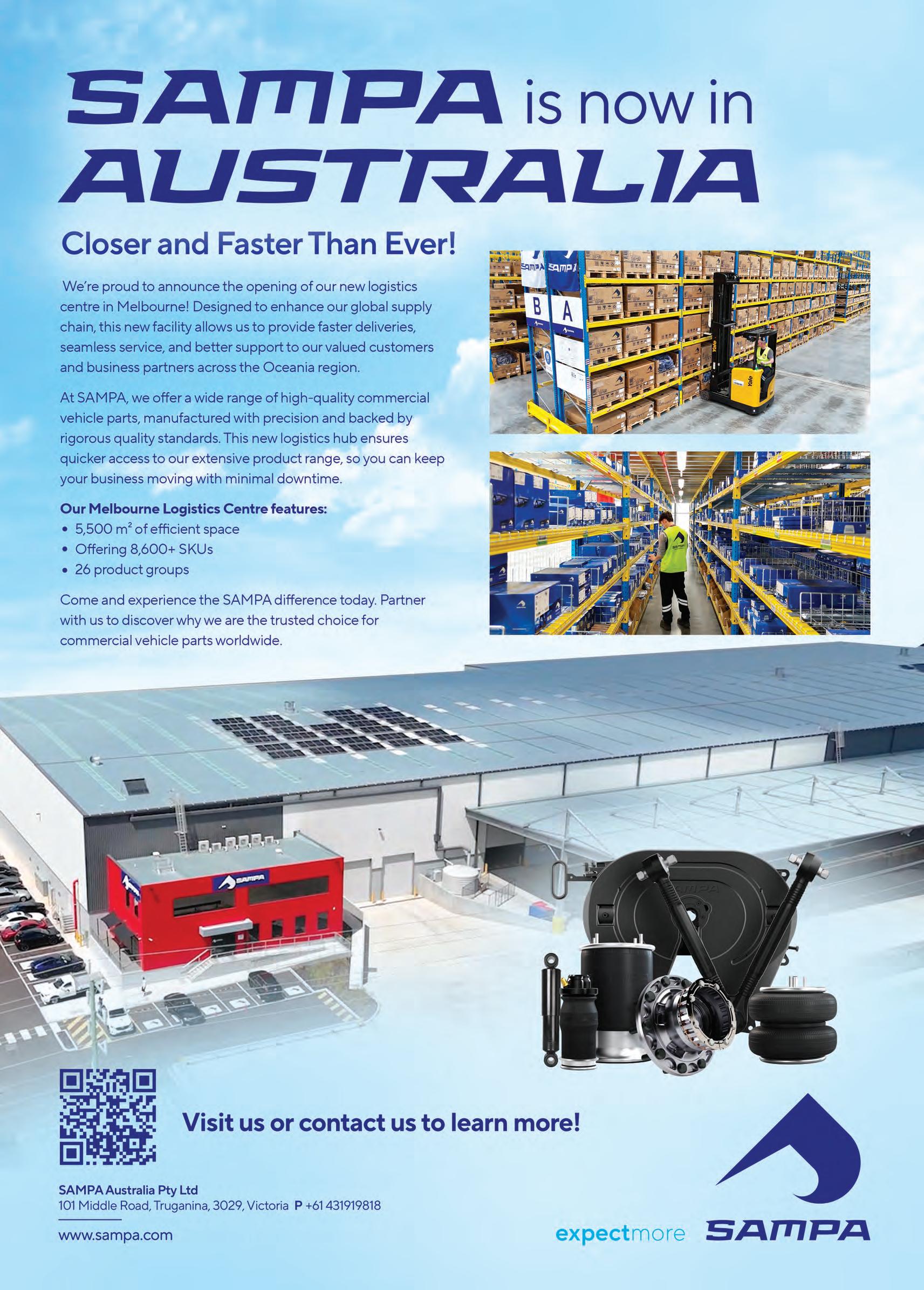



































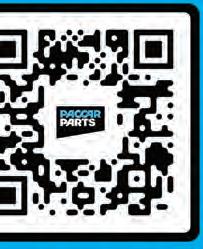























































































































8 ROAD UPDATES

Inside the latest funding and safety upgrades for Australian roads
18 PRESENT OR PAINFUL?
Sean Mortell looks at whether the NHVR’s new productivity plan truly tackles the key issues
24 SAFETY SAVIOUR

In early January, Prime Minister Anthony Albanese announced historic funding for the Bruce Highway. Yet not all of the industry is happy with the plan laid out

26 LIFE IN THE FAST LANE
Warren Aitken caught up with the owner of an eye-catching UD to learn the fascinating story of Jessica Baker and her life in trucking
32 KEEPING IT IN THE FAMILY

Craig Tesch and his stunning new Kenworth K220 are taking Morgans Long Distance Transport to the next level
44 KING RIGS

From crane trucks to plumbing vehicles, check out the interesting backstories to Isuzu’s trucks of the year

48 TRIBUTE TRUCK
Just a year after the passing of his pop, Dave Attkins’ boss at Compas Transport gave him a unique new truck to honour the life of the popular trucking industry member


52 LOVE FOR LORRIES
While in Belgium, Warren Aitken tracked down a fellow truck enthusiast friend in Nick Wright to learn more about his special Scania


62 TRUCK SALES
Check out the leaders from December’s truck sales data







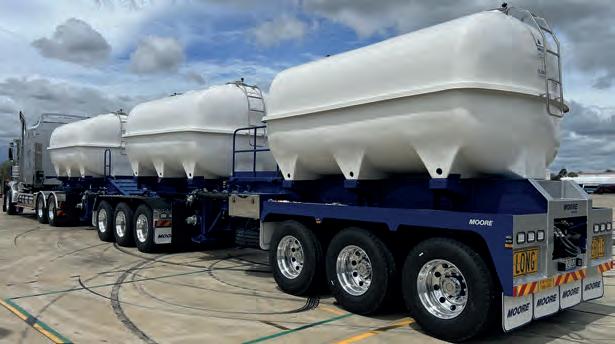








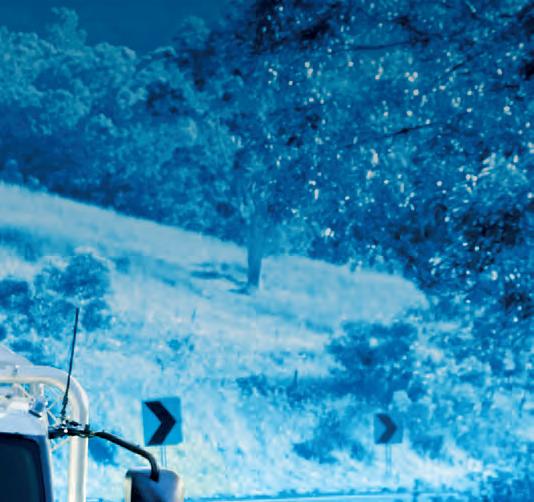


UP TO 20% * IN FUEL AND EMISSIONS REDUCTIONS WITH AUSTRALIA’S ONLY SELF-CHARGING HYBRID ELECTRIC TRUCK.
The Hino 300 Series Hybrid Electric utilises an electric motor and a diesel engine working in parallel, intelligently switching between the two or a combination of both - to boost efficiency. Maximum torque generated at very low rpm minimises fuel use resulting in a reduction in carbon emissions. And as the Toyota Group hydride nickel battery automatically recharges whilst on road during operations, there are no recharging requirements. That’s the power of change, that’s the Hino Hybrid Electric. Visit hino.com.au


EDITORIAL
Editor Sean Mortell
E-mail Sean.Mortell@primecreative.com.au
Journalist Tiarna Condren
E-mail Tiarna.Condren@primecreative.com.au
Contributors Warren Aitken, Frank Black, Sarah Marinovic, Rod Hannifey, Michael Kaine, Glyn Castanelli, Robert Bell, Geoff Crockett
Cartoonist John Allison
PRODUCTION
Art Director Bea Barthelson
Print IVE Print
ADVERTISING
Business Development Manager
Hollie Tinker Ph 0466 466 945
E-mail Hollie.Tinker@primecreative.com.au
SUBSCRIPTIONS
www.ownerdriver.com.au/subscribe
Phone +61 (0)3 9690 8766
Mon-Fri 8am-4.30pm (EST)
Email subscriptions@primecreative.com.au
Mail 379 Docklands Drive, Docklands, VIC 3008 Australia
EXECUTIVE GROUP
CEO John Murphy
COO Christine Clancy
Publisher Sarah Baker
Operations Manager Regina Fellner
Sales Manager – South Danny Hernandez
379 Docklands Drive, Docklands Melbourne VIC 3008
Telephone: (+61) 03 9690 8766
www.primecreative.com.au
ISSN 1321-6279
OwnerDriver magazine is owned by Prime Creative Media. All material in OwnerDriver is copyright and no part may be reproduced or copied in any form or by any means (graphic, electronic or mechanical including information and retrieval systems) without written permission of the publisher. The Editor welcomes contributions but reserves the right to accept or reject any material. While every effort has been made to ensure the accuracy of information Prime Creative Media will not accept responsibility for errors or omissions or for any consequences arising from reliance on information published.
Opinions expressed in OwnerDriver are not necessarily the opinions of, or endorsed by the publisher unless otherwise stated.


Change is the name of the day to start 2025, with the industry already mobilising to prepare for a landmark year
If the opening weeks of 2025 are anything to go by, change will be a dominating theme of the year for Australia’s trucking industry. This intention to introduce new ideas and tweaks to improve the sector was first on display at the very end of 2024 when the National Heavy Vehicle Regulator unveiled its Heavy Vehicle Productivity Plan for 2025 through to 2030.
While it originally promised to be an exciting surprise Christmas gift for many in the industry, our chats with various members of the sector didn’t quite ooze satisfaction. It’s an interesting and defining moment as the national regulator signals a clear recognition of the need to improve productivity within the freight industry. While also having to handle the increasing pressure of switching to sustainable vehicles and trying to abate a concerning road toll trend, the regulator and governments have a hefty task ahead of them this year if they are to meet the industry’s demands and get productivity back on an upwards trajectory. Our feature on page 18 involving many of the sector’s heavy hitters highlights some tips that could result in the first large scale productivity reversal for quite some time in Australia.
As 2024 came to a rapid close, the new year has
seen statistics and data from past year land to summarise where the industry is at, starting with the most alarming – the road toll. Sharp increases in lives lost on the roads in both Queensland and Western Australia is enough to leave many policy makers concerned about the safety threats present on major freight routes. With these highways being the workplaces for Australian truck drivers, something needs to be done to bring the road toll number down in 2025, not continually rising. In our deep dive into the road toll statistics for 2024 on page 13, there are also some ideas presented from state governments about what they need to do to buck this tragic trend.
On the positive side, the Truck Industry Council’s (TIC) 2024 truck sales data was released for December, allowing the market to ascertain the figures for the entire year. With there being no surprises in the presence of big brands dominating, the shock was left for the total truck sales tally as Australia broke its all-time sales record for a third consecutive year. Despite a slowing end to 2024, it was enough to see Australia’s heavy vehicle sales peak once again, with 2025 tipped to show no signs of slowing down. Check out the December review on page 62 and the annual recap on page 64.
“With these highways being the workplaces for Australian truck drivers, something needs to be done to bring the road toll number down in 2025, not continually rising”




When it comes to our features, there’s plenty to choose from. In the opening weeks of the year, Prime Minister Anthony Albanese announced landmark funding for Queensland’s Bruce Highway. With the federal government pouring in $7.2 billion to upgrade the Bruce, and Oppositon Leader Peter Dutton then committing to matching it, the comfort of knowing upgrades are on the way made plenty happy. But is the timeline of how it’ll all happen acceptable for a road in dire need of fixing? Find out on page 24.
From Warren Aitken we had another trio of excellent tales, ranging from the magnificent Kenworth K220 specially designed and driven by Craig Tesch and the family-focused operation at Morgans Long Distance Transport. From this stunning truck of the month to his Belgium adventure of learning more about ‘lorries’ on page 52, Warren covered plenty of ground. Throw all of these stories together with the latest news and you get a February edition bursting with information. We hope you enjoy the read.


















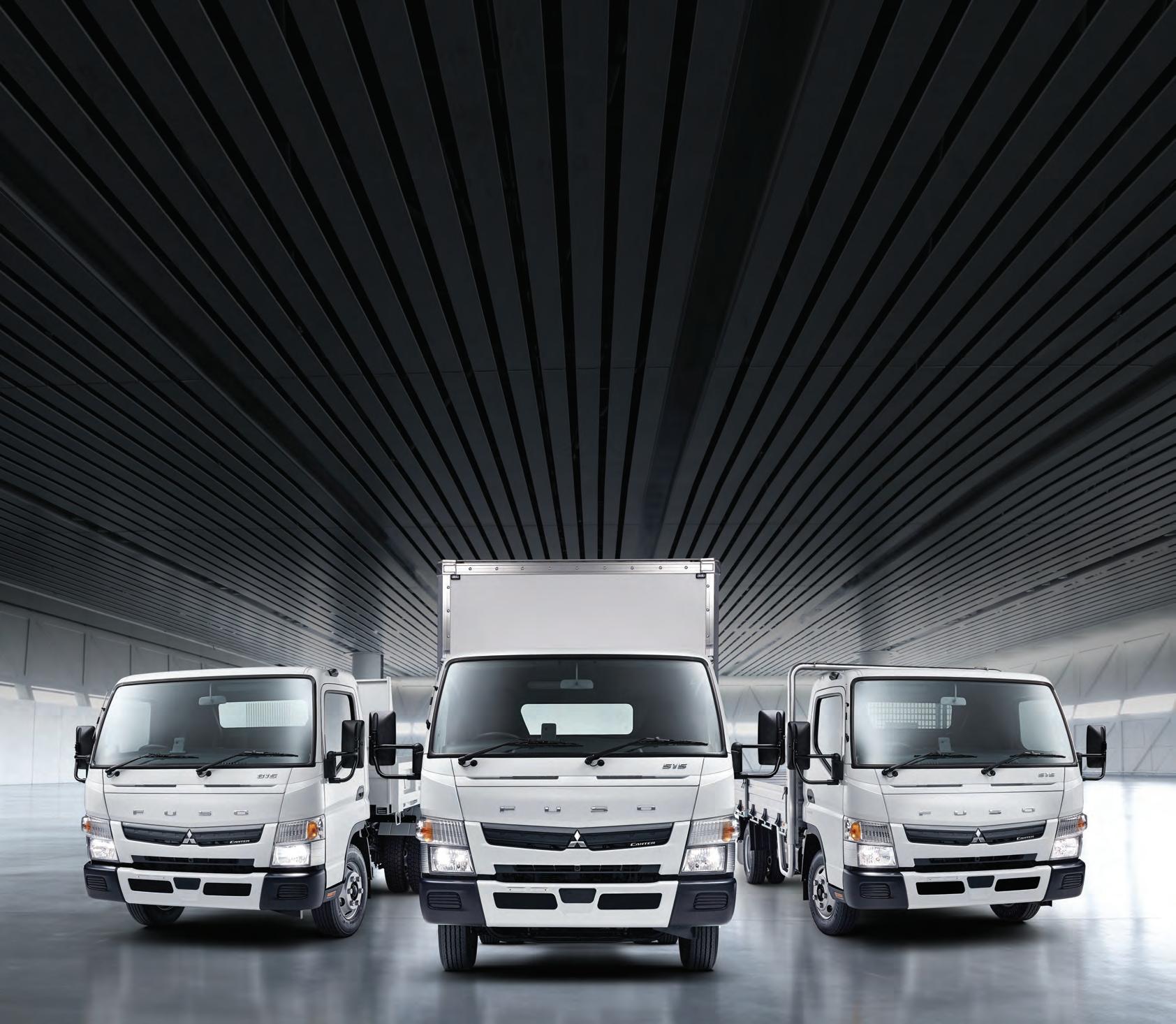


































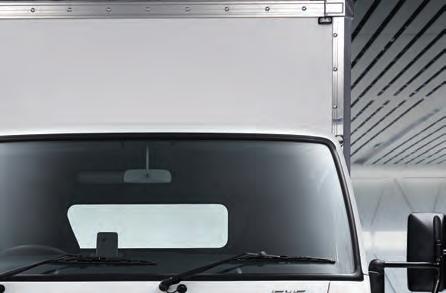


























The road works are already being announced for 2025. After the Bruce Highway funding commitments, there’s plenty more bubbling away. In Victoria, the West Gate Tunnel project is hurtling along as the city prepares for a second option to traverse Melbourne’s west, while a new smart motorway is now open in Sydney and money has been pledged to fix troublesome intersections in Gilgandra.
The Victorian government has revealed the West Gate Tunnel project is close to completion, with a big summer of works ramping up.
The project, once complete, will take thousands of trucks off local roads later this year.
Currently, crews are taking advantage of Melbourne’s summer weather to asphalt the new freeway and continue building the tunnel exit structure. During this period, lane and ramp closures are in place between the West Gate Bridge and Millers Road until March 8.
The West Gate Freeway is also reduced to three lanes in both directions between Williamstown Road and Millers Road until mid-February.
During this same period, there will also be ramp closures in place at the West Gate Freeway outbound exit ramps to Millers Road and Grieve Parade – drivers who usually exit the freeway at Millers Road or Grieve Parade will need to exit early at Williamstown Road.
During this period, drivers travelling to the city are advised to use Williamstown Road to get on the freeway and to use the right lane to access the West Gate Bridge as there will be lane closures.
The summer blitz of work will deliver permanent road barriers, additional signage and smoother roads, along with new inbound express lanes that will run between the M80 Ring Road and the West Gate Bridge, making travel quicker and easier for motorists.
When complete, Victorian transport and infrastructure minister Gabrielle Williams says it’ll widen the freeway from eight to 12 lanes and take 9,000 trucks a day off local roads.
“We thank drivers for their patience as we get on delivering vital works to open the West Gate
Tunnel later this year,” she says.
“The West Gate Tunnel Project will deliver a vital alternative to the West Gate Bridge, providing a much-needed second river crossing when it opens by the end of 2025.”
The New South Wales and federal governments have officially switched on Sydney’s Western Distributor, opening the nation’s latest smart motorway.
The Western Distributor, used by 130,000 motorists per day, now features similar smart technology signage seen on the M4 Motorway. Current data suggests the M4 Motorway now has reduced travel times of 20 per cent and a quarter less crashes since the smart signage was installed in 2021.
The technology provides motorists with real-time digital information, including speed limit changes and safety messages, in response to congestion and incidents for a safer and more consistent journey.
“It is a critical part of the Sydney road network which makes it the right place to deploy the smartest technology to help keep traffic flowing,” NSW roads minister
John Graham says.
“This technology has a proven track record of reducing travel times but also reducing crashes.
“When an incident happens this system reacts immediately which should ensure that time lost to delays is reduced. We all want
more time at home and with family and less time looking at the brake lights of the car in front.”
The digital system is set to clear incidents leading to traffic issues at a faster rate, particularly along the critical corridor between the Sydney Harbour Bridge, Sydney CBD and Anzac Bridge.
A series of 19 new gantries and four existing gantries along 5.5 kilometres between Anzac Bridge and Sydney Harbour Bridge now include automatic incident detection technology, vehicle detection technology, CCTV coverage and variable and static message signs.
The federal and New South Wales governments have revealed a $40 million investment in upgrading major intersections in Gilgandra to make them safer for heavy vehicle drivers.
As part of the funding package, four existing intersections on Hargraves Lane and Federation Street will be upgraded.
The upgrades will occur at where the two streets intersect with the Newell, Oxley and Castlereagh highways in a bid to increase freight productivity, reduce delays and improve safety.
“These intersection upgrades will be really significant for both Gilgandra locals and the truckies who transport goods through and around the town,” federal transport minister Catherine King says.
“We’re proud to partner with the NSW government on strategic investments like this that make our roads safer and more efficient.”
The upgrades will be designed to open up bypass access for all heavy vehicles and reduce the number of heavy vehicles passing through the Gilgandra CBD.
Currently, some larger heavy vehicles are unable to use
Gilgandra’s heavy vehicle bypass because these intersections can’t be safely navigated, meaning some of the biggest and heaviest vehicles need to travel along the Castlereagh Highway (Miller Street) through the town centre.
The NSW government has carried out preliminary investigations to determine the requirements for each of the key intersections and is currently consulting with Gilgandra Shire Council and other key stakeholders to refine the proposed improvements.
A Review of Environmental Factors (REF) and concept designs for the proposed intersection upgrades are expected to be placed on display for public feedback by late 2025.
“Right across regional NSW, we are building better road and transport infrastructure,” NSW regional transport and roads minister Jenny Aitchison says.
“We look forward to continuing to engage with Gilgandra Shire Council, the local community, the heavy vehicle industry and other interested stakeholders to deliver the freight, safety, efficiency and amenity objectives of the project.”



ReconditionedMercedes-BenzTransmissions. MostMakesandModelsG100,G131,GO210, G240,G280,G330available.S3. TA431566. POA
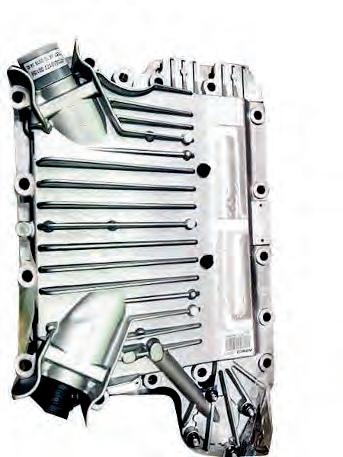
Unit 1/71 Axis Place, Larapinta, Brisbane, QLD, 4110, Australia
Ph: (07) 3276 9300 Fax: (07) 3276 9301
Email: sales@ggd.net.au davids@ggd.net.au
Ph: (07) 3276 9300 Fax: (07) 3276 9301 Email: mattc@gibbsparts.com davids@gibbsparts.com Web: www.gibbsparts.com
Web: www.gibbsparts.com

ZFEcolitepowerpacks.S40. TA952390.
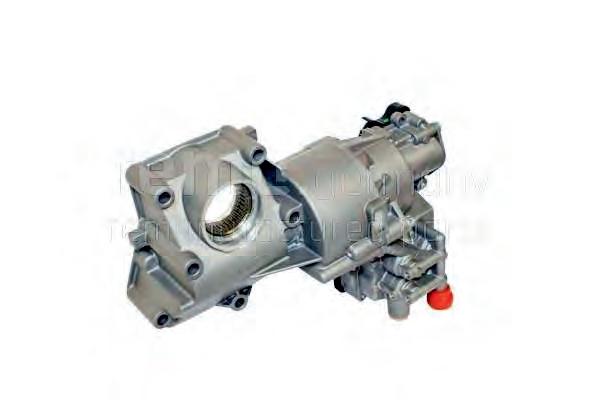
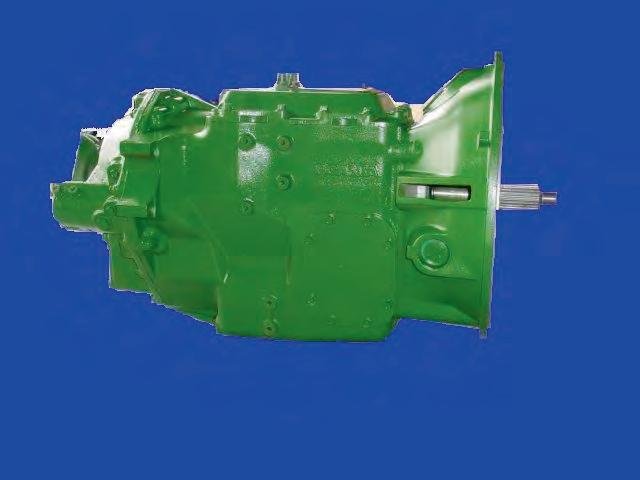
Allmakesandmodelsavailable.S11. TA431615. POA


VOLVO/MACKI-SHIFT/M-DRIVE AT2512C,AT2612D&ATO3112D. S44. TA952399. POA ZFTRANSMISSIONSALLMODELS Allmakesandmodelsavailable.S10. TA431606. POA

Freight is now moving quickly to rebrand new trucks and trailers and integrate the company in the next 90 days
Australian operator SRV Road Freight has announced it has completed the acquisition of beverage and food transport company BEVTRANS.
The general freight company says it recognised the strategic fit between the two businesses and the “significant value” it creates for both.
“This is an important day for the SRV Group as we can take our safety, reliability and value to the next level along the eastern seaboard,” SRV says in a statement.
The business is planning to move quickly on the acquisition, integrating BEVTRANS and solidifying the organisational structure within the next 90 days.
Company leaders and drivers
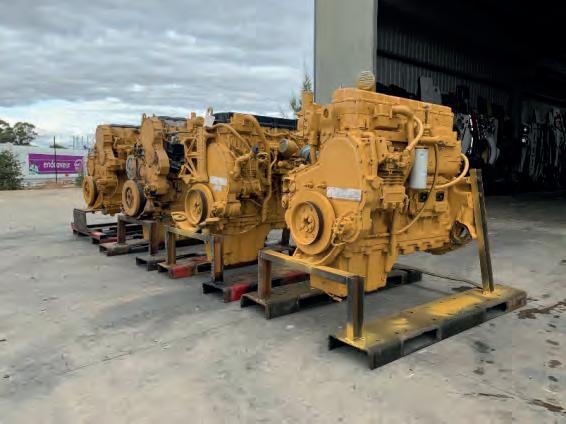
Specialists in CAT and Cummins Engines also carrying parts for all American Truck Brands and Road Ranger Gearboxes. Rebuilt and Second Hand Options Available. Warranty with all second hand and rebuilt engines.
CAT C-15 Rebuild (6NZ or 9NZ Prefix) $48,000 + GST exchange on Special Until EOFY or While Stocks Last. (Block Work, Pistons/Sleeves, Cyl Head, Injectors, Turbo, Camshaft, Rocker Gear, Water Pump, Oil Pump). 12 Months Parts Warranty, 6 Months Return to Base Labour. 550 HP Spec.
CAT C13 Engine (KCB Prefix) $25,000 + GST exchange. Second hand engine with 600,000km on it. Runs good with good oil pressure. 60 Days Return to Base Warranty. 470 HP Spec.
CAT C15 Acert Engine (NXS Prefix) $26,000 + GST exchange. Second hand engine. Has had a bearing roll (mains and big ends). 60 Days Return to Base Warranty. 550 HP Spec.
SRV’s acquisition sees it expand across the eastern seaboard. Image: IKT224/ stock.adobe.com

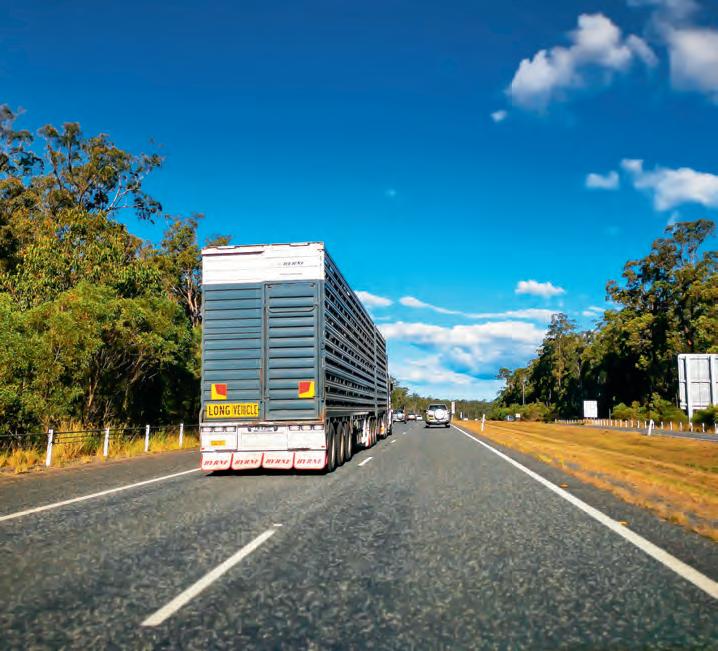
will begin visiting operational sites and DTCs to allow for a smooth integration for the two companies.
“The successful integration effort will be driven by management and operational staff to deliver a high level of service and results to our customers,” SRV says.
“We strongly believe offering our innovative solutions and integrating our resources and expertise will enhance our market position and provide substantial benefits to our customers.”
Over the next 90 days, new Vawdrey trailers and Kenworth trucks in the fleet will feature the updated BEVTRANS logo.
Cummins Signature Gen 2 Rebuilt Engine $48,000 + GST exchange on Special until EOFY or Stocks Last. Block Work, Pistons & Sleeves, Cylinder Head, Turbo, Camshafts, Injectors, Water Pump, Oil Pump all done. 12 Months Parts Warranty and 6 Months Labour.
Cummins ISX 475 Engine Second Hand Engine.
$22,000 + GST exchange on Special Until EOFY. Good Oil Pressure, Ran Good. 60 Days Return to Base Warranty.
Cummins Signature Gen 2 Second Hand Engine
$25,000 + GST exchange. Good Oil Pressure, Ran Good. 60 Days Return to Base Warranty.
Cummins ISX Signature EGR Engine. $52,000 + GST Exchange on special until EOFY or Stocks Last. Blockwork, Pistons & Sleeves, Cylinder Head, Turbo, Camshafts, Water Pump, Oil Pump.


Road Ranger Gearboxes Reconditioned and Second Hand.
All genuine Eaton Parts in reconditioned boxes. Various models available including 16718B, 16918B, 18918B, 20918B, 22918B. Call for pricing and availability of your preference.
The milestone in 2025 means the Queensland family operator joins a special list of Australian companies to celebrate longevity and excellence
Queensland based family business Russell Transport is celebrating its 100th anniversary in 2025 as it continues to excel as a successful logistics operator.
As one of the oldest family businesses in Australia, Russell Transport’s 100 years of operations has focused on servicing customers with the utmost professionalism.
Founded in 1925 by Beryl and Roy Bayley Russell, the third generation Queensland business began by transporting motor spirit for the Dalgety & Co Ltd, Queensland agents for the Commonwealth Oil Refinery (COR) in Brisbane. From these humble beginnings, Russell Transport has grown into a leading name in transportation and logistics, adapting to changing times while keeping its commitment to family values and exceptional customer service.
“Reaching our 100th year is a testament to the hard work and vision of three generations of the Russell family, as well as the dedication of our employees and the loyalty of our customers,” Russell Transport director Ken Russell says.
“We’ve also been able to continue our legacy of excellence in transportation and logistics.”
Throughout its history, Russell Transport has been shaped by the contributions of key family members. While Roy and Beryl laid the foundation, including Beryl’s crucial role in operations after Roy’s retirement, their son Phil Russell took over in 1970 and significantly expanded and modernised the company.
The third generation, including Julie, Ken and Michael Russell, joined in the 1990s and 2000s to bring fresh


perspectives to the company while driving further growth.
To commemorate the achievement, Russell Transport will host or be present at a series of events throughout the year, including a gala dinner in June. These celebrations will honour the company’s rich history and look forward to its future in an ever-evolving industry.
Russell Transport joins a prestigious group of Australian family-owned businesses that have achieved similar longevity, alongside notable examples such as Hutchinson Builders

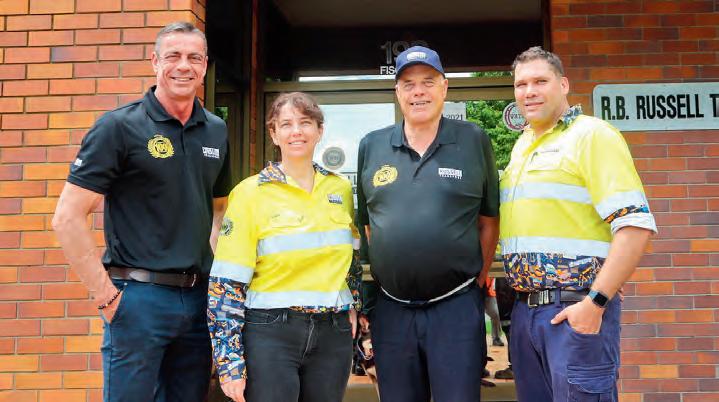
(Hutchies), Albert Smith Signs and Coopers Brewery.
Russell says joining these enduring businesses shows the company’s resilience and adaptability to thrive across generations.
“As Russell Transport moves into its 100th year, it stays committed to its founding principles of reliability, innovation, and family values,” he says.
“This milestone not only celebrates the company’s past achievements but also marks the beginning of a new chapter in its storied history.”





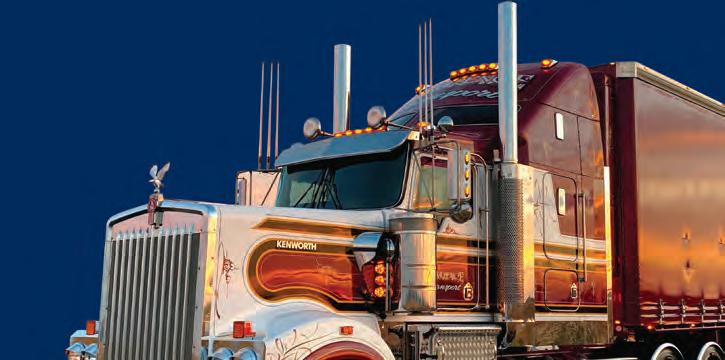


















The popular transportfocused Senator has received a prestigious award for his tireless work addressing
Senator Glenn Sterle has received a mighty honour to start the new year, being chosen as the 2025 recipient of the Senator Alex Gallacher Road Safety Award.
The award, better known as the ‘Alex Award’, is named after Senator Alex Gallacher, who was a tireless road safety champion before his passing on August 29, 2021.
His legacy continues to inspire, with the Safer Australian Roads and Highways (SARAH) Group establishing the award in Gallacher’s honour.
Presented on January 1 each year to coincide with Gallacher’s birthday, the Alex honours Australia’s unsung road safety heroes.
Upon presenting Sterle the award, SARAH founder and president Peter Frazer OAM noted that Sterle has dedicated his career to enhancing road safety. First starting as a truck driver and union official, Sterle brought his experience to the Senate where he has since promoted safety initiatives for the transport sector.
“Senator Sterle’s life-long commitment, tireless advocacy and substantial contributions in the road safety space embodies the spirit of the Alex Award,” Frazer says.
“He is an extraordinary road safety champion, driven by the belief that every Australian has the
right to get home safe to their loved ones every day with no exceptions.”
Federal assistant regional development minister Anthony Chisholm also heaped praise on Sterle, congratulating him for the award.
“If there’s one thing you know about Glenn, it’s his passion and commitment to road safety. He lives and breathes it 24/7, and he’s used his position as a Senator to effectively and passionately advocate to improve road safety right across the sector, benefiting workers, but also families and communities at the same time,” he says.
Upon receiving the award, Sterle highlighted the importance of integrating advanced technologies like telematics and driver monitoring systems into heavy vehicles, while also emphasising the need for more rest areas and improved infrastructure to meet Australia’s growing freight demands.
His goal is to reduce national road deaths to less than 570 by 2030.
“I’m deeply humbled to receive this award in honour of my great mate, Alex Gallacher,” Sterle says.
“Alex was a relentless advocate for road safety, and I strive every day to continue his legacy. We must work together to ensure safer roads for everyone.”
FedEx has revealed plans to separate its freight side into a completely new company this year
FedEx has announced that it plans to separate its FedEx Freight side of the business to create a second publicly traded company.
The separation is set to be achieved in the next 18 months for FedEx stockholders, resulting in the creation of FedEx Freight to


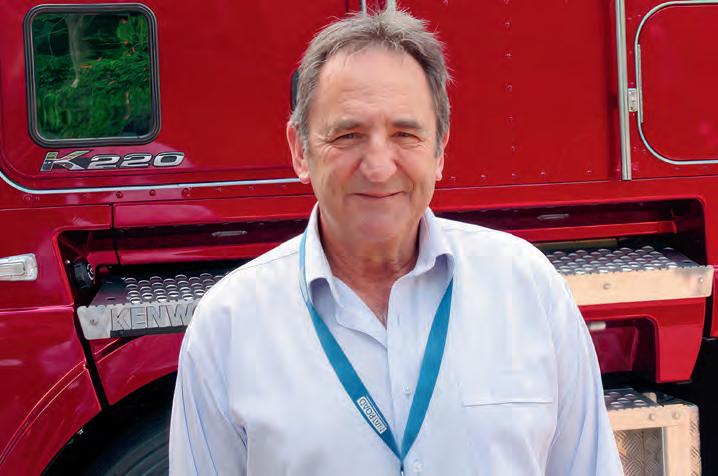

US based zero-emissions heavy vehicle manufacturer Hyzon Motors has announced it has began the process of dissolving its entire company.
Just days before Christmas, Hyzon Motors issued a worker adjustment and retraining notification to its employees at the company’s US headquarter facilities in Bolingbrook, Illinois and Troy, Michigan.
Hyzon says its inability to raise funding and the future uncertainty of government subsidies means customers have slowed down or suspended purchasing decisions.
If Hyzon Motors can’t raise funds or find a buyer, the reduction in force is expected to be completed in February.
The notice to its US employees begins a 60-day notice period that
sit beside FedEx.
FedEx says the split will maintain the strategic advantages of both parties and will ensure the same superior service for customers.
“This is the right time to pursue a separation as we respond to the unique dynamics of the LTL market,” FedEx president and CEO Raj Subramaniam says.
“This announcement is a testament to the strength of the business our team has built, and to our dedication to doing what’s best for our customers, our team members and our stockholders. Through this process, we will unlock value for our freight business and position FedEx to create even greater value for stockholders.”
Vice chairman of the FedEx board R. Brad Martin says the past 50 years has seen FedEx build a strong global platform

it must give before idling operations and laying off employees.
The news comes after Hyzon closed its Australian operations in August last year, with the global head suspending any funding to the Australian arm.
producing significant value for stockholders.
“Building upon that powerful foundation, and following a careful assessment of our portfolio, the FedEx Corporation Board is confident that a separation of FedEx Freight will drive continued growth and value creation,” Martin says.
The split follows a recently completed assessment that saw FedEx decide that strategic opportunities arise from separating FedEx Freight into an independent company.
Through the separation, FedEx says both companies will benefit from enhanced operational focus, distinct investment profiles, strong balance sheets and a shared brand.
This move, part of other FedEx initiatives, is expected to create $4 billion in cost savings by the end of 2025.
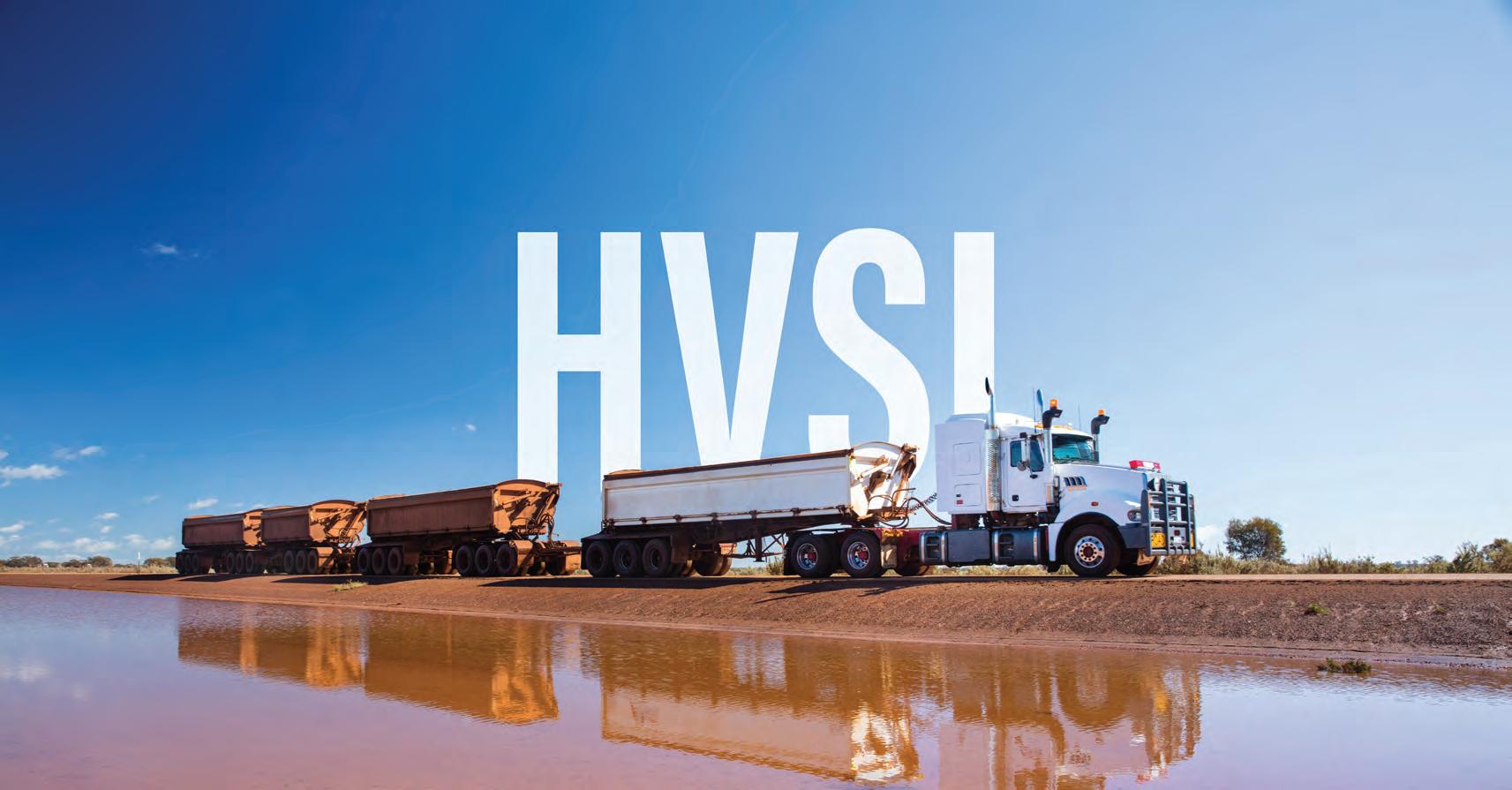
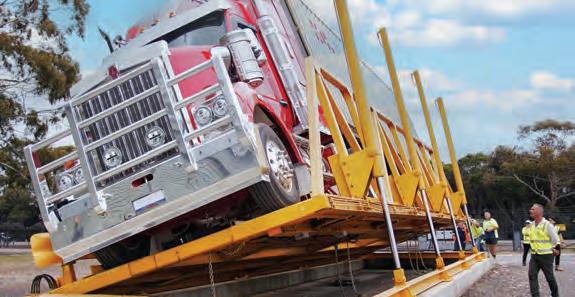



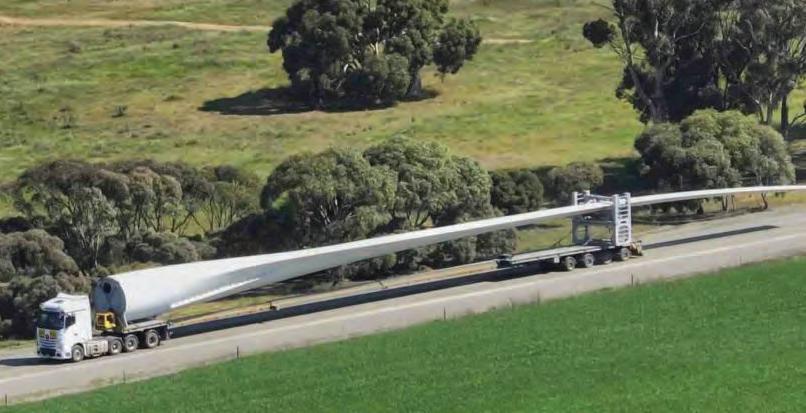
Funding available for submissions supporting heavy vehicle safety improvement projects.
Applications close 17 February 2025
For more information visit nhvr.gov.au/hvsi





OwnerDriver breaks down the 2024 road toll numbers to show the key factors leading to an alarming national road toll for the past year of more than 1300








Numerous state and territory governments are calling for drivers to be safer on the roads in 2025 following the release of the 2024 road toll figures.
In total, 1302 lives were lost on Australian roads last year, with numerous states recording some of their highest road tolls in recent history in 2024.
New South Wales was the jurisdiction with the highest road toll in 2024, mirroring its 2023 result with 340 deaths on its roads.
Queensland had its worst year on the roads since 2009, with 302 people dying on its roads in 2024. Its 2024 road toll is 25 more than 2023, and 33 more than the five-year average.
While Victoria’s road toll was the third highest in Australia in 2024, its 283 deaths recorded on the roads last year is down from 295 in 2023. Despite this drop, the 2024 road toll for Victoria is still well above its five-year average of 249 deaths recorded.
Western Australia was next with 186 deaths recorded on its roads in 2024, marking its highest road toll since 2016 and an increase of lives lost of 28 from 2023.
South Australia’s road toll dropped from 117 in 2023 to 90 in 2024, while Tasmania’s also decreased by four lives lost to 32 in 2024.
The Northern Territory recorded a road toll of 60 in 2024, while the ACT listed 11 lives lost on its roads as of late December.
The likes of NSW and Queensland say speed and regional roads are
becoming key factors to the worrying spike in road deaths in the past year.
Despite introducing seatbelt cameras on July 1, 2024, the NSW government says the road toll remains too high.
In 2024, 136 people died in crashes in NSW where speed is a factor, while 234 people out of its 340 death toll died on regional roads. Fatigue also remains an issue, with 77 fatalities attributed to driver tiredness in 2024, while the likes of alcohol and drugs and motorcycle
past two years running,” NSW roads minister John Graham says.
“If there is a bright spot in the data in 2024 it is that the sharply higher trend of fatalities recorded in 2023 has not continued and we did not see another increase in the total.
“I want to urge all drivers who qualify, to remain offence-free from January 16 to receive a demerit point removed from their licence. The more people who succeed, the more overall road safety is enhanced.”
NSW regional transport and roads
Deaths on regional roads accounted for more than 60 per cent of fatal crashes in 2024, with the southern region spanning Darling Downs, Ipswich and South-West Queensland having the highest number of fatalities.
The Queensland government is now hoping the announcement of the new funding arrangement with the federal government for safety upgrades to the Bruce Highway will drive down the road toll in 2025 and beyond.
“I want to urge all drivers who qualify, to remain offence-free from January 16 to receive a demerit point removed from their licence. The more people who succeed, the more overall road safety is enhanced.”
riders also being listed as factors in the 2024 road toll.
In 2025, the NSW government is looking to trial average speed cameras for light vehicles while removing a loophole that forces all motorists driving on a foreign licence to convert to a NSW licence within six months.
“Too many lives were lost on NSW roads in 2024. We should never become desensitised to the annual figure or accept that it should be as high as 340 as it has been for the
minister Jenny Aitchison says: “More than two thirds of those people died on regional roads, despite only a third of our population living in the regional areas of NSW.”
A similar trend emerged in Queensland, with the state government saying speed has continued to climb year-on-year as a key factor when it comes to fatal crashes, while motorcycle riders and senior drivers are also listed as being disproportionately represented in the road toll.
In Victoria, 149 of its road deaths in 2024 were in rural regions, with the other 134 being in Melbourne. This is a 14 per cent drop compared to 2023, yet the rural road toll death is still below the five year average of 140. Finally, Western Australia’s alarming 2024 road toll is a major spike from 2023, and is the highest since 2016, when 195 road deaths were recorded. Out of its 186 lives lost on roads in 2024, 107 of these were in regional areas, while only 79 were on metropolitan roads.
The Truck Industry Council’s latest plan looks at lowering the average age of Australia’s truck fleet to unlock a myriad of benefits
Words: Geoff Crockett
With the federal election on the horizon and the first month of 2025 already gone, the pressure is rising for political parties to show their colours when it comes to transport industry issues.
For the Truck Industry Council (TIC), 2025 coincides with an update of its five-year planning document, the National Truck Plan, and its ongoing mission to modernise the Australian truck fleet.
TIC CEO Tony McMullan says while there is a clear imperative from the electorate to take the issue of climate change seriously, the reality of Australia’s aging truck fleet and the approaches by governments to date to effect change makes the challenge of reducing carbon emissions difficult.
McMullan is the first to acknowledge that the TIC is the peak body representing truck manufacturers, importers and major component suppliers in Australia, and a more modern fleet would benefit these groups.
However, he says the National Truck Plan is about more than commercial interests — it is about future-proofing an essential industry and making Australia’s truck fleet safer, greener and cleaner.
Data from the Road Vehicles Australia Report, released annually by the Australian Bureau of Infrastructure and Transport Research Economics (BITRE), shows that in 2024 the average age of trucks in Australia’s fleet was 14.8 years. By way of comparison, similar data reported internationally has the average age of truck fleets in the USA as 6.7 years, in China as seven years and in Singapore, 5.6 years. New trucks feature the very latest in safety systems and cutting-edge technology to reduce diesel engine carbon and noxious emissions to a minimum.
While safety systems such as lane assist warnings, electronic stability control and automatic emergency braking systems are being mandated

for new trucks from this year, along with Euro VI engines – TIC modelling, based on the turnover of trucks, shows it will be at least 2056 before 95 per cent of the Australia’s truck fleet is rolling with all three systems on board.
Those Euro VI engines emit less nitrous oxide, less carbon dioxide and use less fuel than earlier emission level engines – but it will be decades until 95 per cent of the truck fleet is operating the newer engines.
McMullan says as of early 2025 there will be 10 truck brands offering battery electric trucks and another brand offering diesel/hybrid trucks as part of its line-up. He says while manufacturers will continue to develop their hybrid, BEV and FCEV offerings and assigning resources to research and development in the space, more needs to be done to make the products accessible to truck owners and drivers.
The introduction to the National Truck Plan puts it simply: “TIC calls upon federal and state governments to actively pursue an agenda which accelerates the adoption of the latest heavy vehicle safety systems, emission standards and advanced fuel saving technologies that will result in a safer, cleaner, greener and more efficient national truck fleet.”
It also notes that: “Australians want to be sure that the trucks on the nation’s roads today comprise a modern truck fleet.
“Settling for less would be to agree that it is acceptable to go to a hospital and receive treatment from 15-year and older medical technology.
“We would not settle for that and nor should we accept and old Australian truck fleet.”
When it comes to policy recommendations for governments to consider, the TIC plan suggests a mix of incentives targeting four key pillars of finance, regulation, low emission fuels and behavioural change.
These include:
• 100 per cent instant asset right off depreciation allowance to offset purchases of low and zero emission trucks and Euro VI or equivalent diesel only trucks
• 50 per cent depreciation write off on purchase of used ADR 80/03 Euro V and equivalent diesel trucks, if upgrading from Euro IV or earlier
• National green vehicle rebates reducing registration and stamp duty charges on low and zero emission trucks and Euro VI diesel
• Allow higher payloads on low emissions trucks to ensure productivity parity with similar ICE trucks
• A road user charge for operators based on the principal of all vehicles paying proportionally for the physical damage they cause, along with the safety and emissions levels they offer
• National Cabinet to remove regulatory and infrastructure barriers preventing the uptake of Higher Productivity (PBS) Vehicles
• Federal government to implement policies to stimulate the provision or of key infrastructure for the transition and uptake of low and zero emission heavy vehicles
• Low emission zones as defined by road/tunnel/port infrastructure or geographical parameters preferencing low emission or Euro VI equivalent vehicles with

reduced charges.
• Annual safety/roadworthiness and environmental test scheme to be mandated for all heavy vehicles over one year old
• State and federal governments to facilitate the start of the evaluation trials for trailers with traction eAxles, by amending regulations as required
• Federal finance and incentives to foster the development of an Australian low carbon, liquid fuel industry production capacity
• Immediately finalise the draft Paraffinic Diesel (renewable diesel) Standard
• Expand the Guarantee of Origin Scheme to include Low Carbon Liquid Fuels (LCLFs)
• Implement blending mandates for bio-diesel, renewable diesel and SAF to be introduced concurrently on all three LCLFs and at a point in the fuel supply chain no later than the fuel wholesaler
• Introduce measures that will achieve cost effective, high quality and consistent, LCLF/mineral diesel blends to support blend mandates by means of a volume blending regulation and systems similar to that deployed in Europe
• Invest in a public awareness campaign to encourage the move to lower emission vehicles.
McMullan says the National Truck Plan: Modernising the Australian Truck Fleet offers a politically and technology agnostic road map toward a safer, greener and cleaner future for Australia’s road transport industry and it will be at the heart of TIC’s conversations with politicians and government leaders over the coming years.
It’s official! SAMPA Group has launched its Oceania Logistics Centre in Truganina, Victoria, marking a significant milestone in the company’s growth journey in Australia.
The new facility, an advanced factory and office complex was unveiled just before Christmas, reflecting years of meticulous planning. This development allows the Turkish commercial truck and trailer parts manufacturer to stock thousands of components locally, significantly reducing delivery times for its expanding Australian customer base.
Melbourne-based Serhan Memik, Managing Director of SAMPA’s Oceania region, emphasised that minimising workshop downtime is a top priority when repairing commercial trucks and trailers.
He says by having parts readily available within Australia, SAMPA ensures faster service to meet the industry’s high-pressure demands.
For years, SAMPA has collaborated with the HVIA and the Department
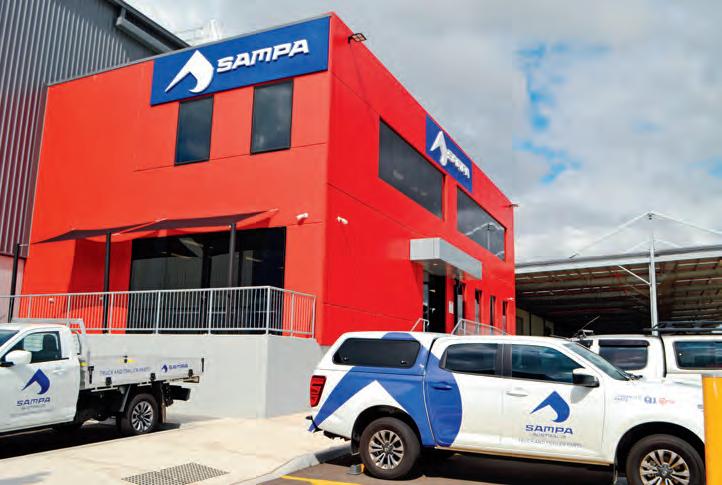
of Infrastructure and Transport to guarantee that its parts align with Australian design standards and expectations.
With exports to 160 countries, SAMPA operates a robust network
of over 7,000 employees, 27 offices, and 35 warehouses worldwide. The company manufactures an impressive catalogue of over 100,000 parts for heavy-duty commercial vehicles, including European and American
trucks, trailers, and buses.
The grand opening of the Truganina facility was celebrated with key dignitaries in attendance, including His Excellency Ufuk Gezer, Ambassador of the Republic of Türkiye to Canberra, Consul Dogan Isik, SAMPA Group CEO Tarik Altuncu, and board member Hasan Mufit Sahinkaya. HVIA CEO Todd Hacking also joined the event, travelling from Brisbane to commemorate the occasion.
Looking ahead, SAMPA is poised to expand its Australian footprint further, with plans to establish satellite offices in both Brisbane and Perth within the next 12 months. Meanwhile, operations at the Melbourne logistics hub will continue to evolve, leveraging advanced technology to streamline parts delivery. Currently, more than 8,600 SKUs are ready for immediate shipment.
The Oceania warehouse is located at 101 Middle Road, Truganina, Victoria. Call 03 9394 5000 or visit www.sampa. com/en for more information.



















Iam very proud to be part of the Labor Government which announced $7.2 billion in new funding to fix the Bruce Highway in Queensland recently. This investment will bring this critical piece of road infrastructure up to a minimum threestar safety rating.
This is fantastic news for truck drivers and the other road users who frequently use this critical highway. I have read articles and had conversations with drivers about the condition of the Bruce which is why it’s so pleasing to see that the federal government is delivering and building a better and safer future for the Bruce and for everyone who uses it.
Since the announcement, this investment has been widely welcomed by industry groups and associations, including the RACQ, the QTA, the TWU and the Australasian College of Road Safety (ACRS).
This historic funding is the single largest investment ever into the Bruce Highway, and brings the Australian government’s total outlay for the 1,673km road to more than $17 billion.
The Department of Transport and Main Roads has estimated $9 billion will achieve a minimum of three out of five-star safety rating for the entirety of the Bruce.
In recognition of the Bruce Highway’s national importance, unique challenges and dire safety record, the federal government is committing to funding 80 per cent of that $9 billion.
The Bruce Highway has an average Fatal and Serious Injury (FSI) crash rate three to five times higher than any major highway in New South Wales and Victoria.
As the major north-south corridor which connects Brisbane to the regional centres of Bundaberg, Rockhampton, Mackay, Townsville and Cairns, the Bruce is critical to the movement of passengers, freight and tourists across the state – supporting around 62 per cent of the population in Queensland.
The new safety package will fasttrack critical projects along the whole corridor, and will initially focus on priority sections north of Gympie that have been identified by stakeholders due to their higher than average crash rates.
Priority sections include

Maryborough to Benaraby, Rockhampton to St Lawrence, Bowen to Townsville and Ingham to Innisfail.
Importantly, projects within the package may include installing safety barriers, wide centre lines and audio tactile line marking; constructing wider shoulders; increasing run off areas, overtaking lanes and rest areas; and improving intersections, signage and sight lines.
A key take out for me with this investment is the focus on rest areas.
The improvement to the condition of the roads and the increase to a minimum three-star safety rating will save lives. There is no doubt about that.
However, the inclusion of rest areas as potential projects as part of this package is a demonstration of how the Albanese Labor government understands the road transport

industry as well as the importance of rest areas to truck drivers and supporting them to manage their fatigue.
As someone who still drives trucks up to Kununurra in WA’s northwest from time to time, I know how important rest areas are for road safety and productivity. I also understand that there is still a huge need for more rest areas around our country to support our truckies.
Following the last federal election campaign in 2022, the federal government delivered on its commitment to allocate $140 million over 10 years to the Heavy Vehicle Rest Area initiative which would support the construction of new or upgrades to existing rest areas for heavy vehicle drivers.
In December of 2022, I was honoured to be appointed Chair of the Heavy Vehicle Rest Area Steering Committee which overseas applications to the initiative. The Steering Committee includes five long-haul truck drivers and four industry representatives.
Under this initiative, state, territory and local governments are able to apply for funding for new and upgraded heavy vehicle rest areas.
Since the committee began its work, $36.3 million in Australian government funding has been approved for 21 rest area projects from the Albanese government’s Heavy Vehicle Rest Area Program to support our truckies. The Steering Committee is committed to supporting projects that demonstrate value for money as well as deliver the best safety outcomes for our truckies.
We want all truck drivers and road users to have their say on what heavy vehicle rest area upgrades are needed and where, and we want to hear from you! A designated survey has been created for people to provide feedback which can be found at https:// survey123.arcgis.com/share/9da6627f b06f4fadbc489431be7c4c48?portalUrl =https://spatial.infrastructure.gov.au/ portal or you can get in touch with me at senator.sterle@aph.gov.au. Stay safe on the roads and always remember to drive so others survive.
Glenn



In the final weeks of 2024, the NHVR unveiled its latest Heavy Vehicle Productivity Plan. Sean Mortell looks at whether the plan truly tackles key issues impacting productivity
As December rolls around each year, thoughts quickly turn to the holiday period. Most importantly, many begin brainstorming what they want for Christmas. Late last year, as the adults had their usual range of options to bring a smile to their face while kids eagerly awaited a long list of toys sitting under the tree, members of the Australian transport industry received a surprise present. Just five days before Santa began his annual trip around the globe, the National Heavy Vehicle Regulator (NHVR) lined the sector’s stockings with something new.
In December, the NHVR gave the sector an unexpected Christmas present when it officially released its latest Heavy Vehicle Productivity Plan (HVPP). The plan, spanning from this year through to 2030, outlines 22 actions to overcome challenges currently impacting the trucking landscape.
Whether it be the search for growth in the national freight task, mitigating road fatalities or addressing environmental and health impacts relating to the transport industry, the NHVR plan included plenty of points to pique the interest of truck industry members. While it originally seemed to be the dream gift for many in the industry yearning for a proactive approach to change, some transport associations quickly found the plan to be more akin to a lump of coal lodged deep in their stockings.
As one industry member surprised by the NHVR’s Christmas gift, Western Roads Federation (WRF) CEO Cam Dumesny saw positives in the present, but wasn’t completely full of festive cheer when reading the plan.
“It’s good that the report shows the NHVR is working on productivity,” he told OwnerDriver.
“The plan is better than no plan at all, and putting productivity at the centre of activity is a good thing, but I don’t think the report focuses on all of the important aspects of fixing productivity.”
The ‘P-word’ has been a constant presence in the Australian trucking industry for some time. Many transport industry members have been quick to point out that productivity growth has stalled since around 2007 when the Global Financial Crisis first ground the global economy to a halt.
This economic downturn has meant productivity has been put on the backburner, simmering behind the scenes without much attention from regulators and politicians. Back in the 1990s, measurable and celebrated productivity growth across the Australian freight sector was celebrated. Now, it has slowly been reduced to the faltering flickers of a fond memory attributed to a ‘golden era’ of trucking regulation.
Alongside Dumesny, Queensland Trucking Association (QTA) CEO Gary Mahon wants to see the “enormous issue” of productivity tackled in more complexity than shown in the NHVR’s plan in order to return the industry to the glory days of the ‘90s.
“We need a much more progressive outlook to change the composition of the fleet along with other changes in the HVNL to give us that productivity bounce,” Mahon told OwnerDriver.
“We need to get back to the ‘90s – the last decade we had where there was elevated, measurable and celebrated productivity growth across the industry.
“It waned down to 2007 and has barely had a pulse in it since then. A big way of seeing this productivity boost is by also getting the Heavy Vehicle National Law (HVNL) review back on track.”
While the HVNL review continues to receive focus from the NHVR and other members of the industry, it isn’t mentioned in the Heavy Vehicle Productivity Plan. Despite the plan’s detailed 22 action points to enhance heavy vehicle productivity and resilience, Dumesny thinks true improvement can’t occur without addressing both productivity and the HVNL in the same timeframe.
“The fundamental problem with the HVNL currently is that local governments are elevated to the same status as state governments when it comes to being road asset owners,” Dumesny says.
“The NHVR has had a challenge for more than a decade to get these systems flourishing on Australia’s key productivity routes. However, the Western Australian and Northern Territory governments have deemed authority over every road in their jurisdiction, so they don’t need to go through an approval process for major freight routes like other states, they only do so out of courtesy.
“These two jurisdictions don’t have to work alongside the likes of 640 local governments around Australia to get these productivity changes approved – it can be a nightmare of a system for the other states and territories that have to work through this.”
Alongside productivity, Dumesny views sustainability as the next most pressing issue for trucking in Australia. In his view, the two are inextricably linked. Amid a cost of living crisis for many in the nation, the bureaucratic red tape that limits certain freight activities means transport is contributing to these rising costs. At the same time, heavy vehicle manufacturing within Australia has dropped to a miniscule fraction of the country’s economy.
Dumesny says this blend of challenges facing the local transport industry can all be addressed equally with a more considerate approach to increasing productivity in the sector.
“Our freight supply lines are a problem, as are our emissions. Do you want to improve these? Then let’s get more productive,” he says.
While the NHVR’s productivity plan is a first step in addressing these issues and returning the industry to its previous heights, Dumesny says the focus shouldn’t be on rates. Instead, current regulation and requirements on transport operators fills his focus when it comes to improving productivity.

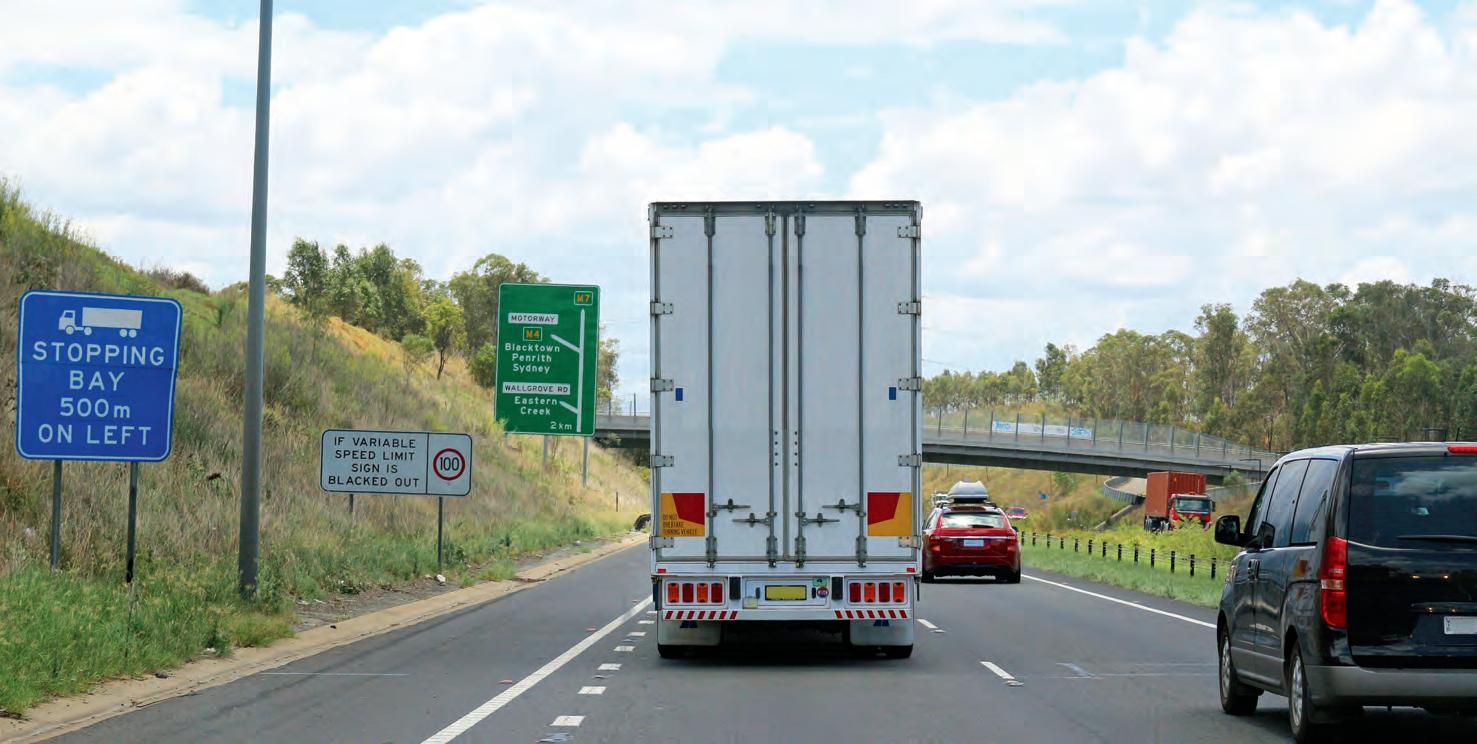

“It’s not about pushing rates down further, as they’re already too thin now,” he says.
“It’s about removing unproductive time with red tape, time and money that is currently wasted on areas we don’t make money from.”
Dumesny and the WRF aren’t the only members of the transport industry with reservations when it comes to the NHVR’s productivity plan. While the regulator’s document also addresses the shift from asset management to optimisation and the increased frequency of unplanned supply chain disruptions, Victorian Transport Association (VTA) CEO Peter Anderson says the NHVR missed key areas in its fiveyear strategy.
“The VTA is disappointed that the NHVR Heavy Vehicle Productivity Plan disregarded key concerns such as heavy vehicle driving training and uniting all Australian road jurisdictions under a single heavy vehicle law,” Anderson told OwnerDriver.
“It also doesn’t address the adoption of innovations from OEMs and the industry. The plan fails to look at real-world needs and doesn’t mention the need to improve the HVNL.”
These oversights have been enough to leave Anderson and the VTA dispirited. He says the NHVR’s credibility has been reduced following the plan’s release as it doesn’t unite Australia’s transport industry under a cohesive framework.
“It repeats last year’s efforts without tackling specific industry issues and doesn’t inspire confidence in
significant outcomes,” he says.
However, as they say, beauty is in the eye of the beholder. Heading up the Hume from the VTA, Simon O’Hara from Road Freight NSW (RFNSW) chose to focus on the positives attached to the NHVR’s Christmas gift.
“The NHVR’s Heavy Vehicle Productivity Plan is a great roadmap for the future and report card for the present,” he told OwnerDriver.
“The safety challenges for road freight and decarbonisation must remain our collective focus, but the reference to unplanned supply chain disruptions also form a key part of our conversations held with federal and state ministers, road managers and regulators.”
O’Hara strays from the disgruntled reaction of other Australian transport bodies, instead relishing the mention of key industry challenges. While it may not have been the ideal Christmas gift for many in the sector, industry members like O’Hara are choosing to optimistically pick the positive points in the plan to celebrate and bring attention to.
“One of the most important references in the plan is that the NHVR firmly believes productivity isn’t a trade-off with safety and sustainability, and that stakeholder management and harmonisation remain front and centre imperatives,” he says.
“Our view is that the NHVR must ensure that productivity for operators remains an essential part of its work with the industry.”
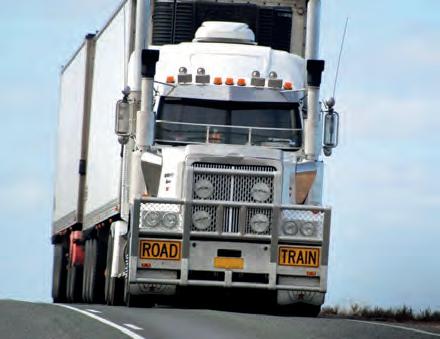
The transport industry has given their thoughts on how they want to see productivity gains achieved
ABOVE: Can productivity improvements be linked to safety and sustainability changes?
LEFT: From rest areas to new technology, productivity is all the rage in 2025
The TWU
is

celebrating a strong start to 2025 with the announcement of two new codes for gig workers and road transport drivers
This month, truck drivers and gig workers receive new rights under transport reform laws. For the first time there will be protections from unfair contract terminations if you’re a truck driver, and unfair deactivations if you’re a gig worker.
‘Deactivation’, by the way, is how gig companies refer to kicking a worker off an app, often with no reason provided and no way to appeal. This is a huge win for owner drivers and other workers in the gig economy, one of the changes under transport reform laws that will make a real difference to people’s lives.
The rights will be covered under two codes: for gig workers, the Digital Labour Platform Deactivation Code, and for road transport workers, the Road Transport Industry Termination Code.
For gig workers it means if they’re told they’re being deactivated, they’ll have the right to discuss it with the platform – and importantly, with a human instead of an algorithm. It is mind-boggling that
gig workers have been sacked from an app without even talking to a person for so many years. They’ll also be able to access the Fair Work Commission to appeal a decision.
If you’re a gig worker, trying to get a fair outcome, or even a person to talk to you, has been next to impossible. Many have been forced to look for other work after losing access in an instant to an app that was their source of income.
This change will make a real difference to the lives of those workers and is a crucial step in bringing up the gig economy as a whole.
For truck drivers, the changes mean there’ll need to be a fair process before contracts are terminated. The Fair Work Commission can also consider these contract terminations and order remedies – including reinstatement of a contract if it was unfairly terminated, or compensation.
For too long, owner drivers and transport operators have been under immense contract pressures. Over many
is the
of the Transport Workers Union of Australia. Contact Michael at: NSW Transport Workers Union, Transport House, 188-390 Sussex Street, Sydney, NSW 2000. twu@twu.com.au
conversations with drivers over the years, I’ve heard too many stories about those pressures on drivers to work beyond legal driving limits just to avoid losing a contract, to fudge logbooks or overload vehicles.
Of course, many transport operators are themselves under huge contract pressures from the top of the supply chain.
A driver at Scott’s Refrigerated, before it collapsed, had been working well beyond his limits, and called in to say he was too fatigued to keep going – and was told he had to keep going or they’d lose the contract. He rolled his truck and was killed.
That’s just one story. There are countless in the road transport industry, not just tragic deaths but businesses going under because they tried to do the right thing and couldn’t compete with those who weren’t; people who’ve walked away from the industry because it had become unsustainable.
These new rights, which will give drivers protections against unfair contract terminations, are a crucial part of making this industry better. Of course, it’s only one part of things.
Drivers and transport operators can’t be the only ones held accountable when they have the least control. That’s why it’s so important that the new transport reform laws also give us the power to rope in those wealthy clients at the top of the supply chain and ensure they pay their fair share.
This entire industry fought for those laws and we’re only just getting started using them.
“For truck drivers, the changes mean there’ll need to be a fair process before contracts are terminated. The Fair Work Commission can also consider these contract terminations and order remedies – including reinstatement of a contract if it was unfairly terminated, or compensation.”
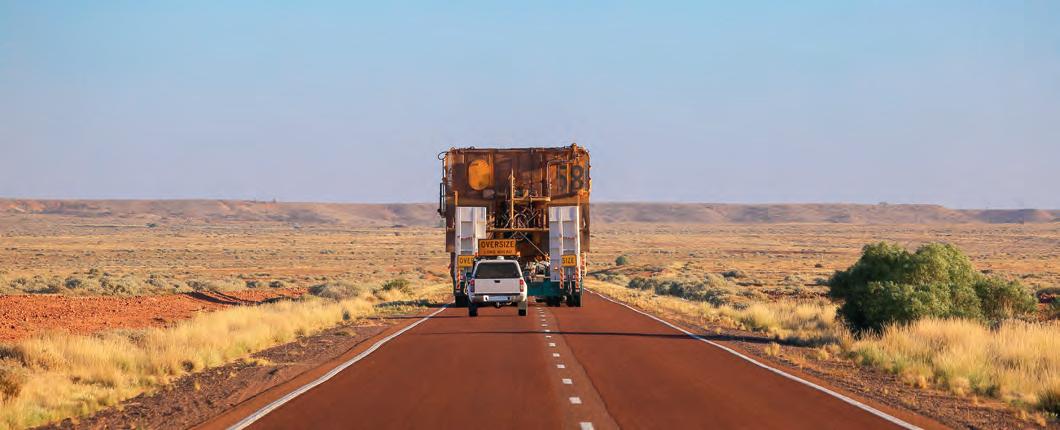
One of our first applications using the laws, after wide consultation, was to ensure maximum 30-day payment terms, industry-wide, no matter whether you’re a transport business or an employee driver or owner driver. That’s another step towards reducing the huge financial burdens on drivers and operators.
The other applications – to establish minimum standards in food delivery and parcel delivery – will help bring the industry up. Sub-committees for this first round of applications are now beginning to allow the industry to have a say and be involved in the process.
That’s just the start. Over time we’ll be able to build on these standards and ensure road transport is safer, fairer and more sustainable – and able to deal with the challenges posed by automation and transition to net zero.
Over many years, wealthy clients at the top of the supply chain have been able to dictate terms and conditions, while making mammoth profits at the expense of workers and transport operators.
But with the whole industry united, that era is drawing to a close. It’s time for wealthy clients to pay their fair share, and we’re well on our way to making that a reality.
New rights to contract protections are one piece of the puzzle. Our first round of applications are another. These laws themselves are just a tool to help us deliver real change – what has got us this far is realising that what unites us as an industry is far more than what divides us. And it’s what will ensure a better industry into the future.
NHVR Michelle Tayler

The NHVR has many projects underway, with submissions open for its latest round of Heavy Vehicle
As the heavy vehicle industry comes up for air after completing its biggest and busiest season, it’s important to reflect and talk about the safety issues faced when on the road and at every stage of the journey to see what can be done to make the transport and logistics industry safer.
To help address current and emerging heavy vehicle safety challenges, the NHVR’s Heavy Vehicle Safety Initiative (HVSI) grants program supported by the federal government provides crucial funding to industry to deliver tangible safety projects that will make immediate and long-term improvements to road safety. These are road safety projects for industry, by industry, to make an impact where they feel it matters the most.
To date, the Australian government has invested over $41 million across 169 HVSI projects. These projects are making a lasting impact to solve a key road safety gap or issue.
a practical solution to manage wait times and combat fatigue.
FOOT IN THE DOOR BY WOMEN IN TRUCKING AUSTRALIA
Women in Trucking Australia’s (WiTA) Foot in The Door project provides eligible women with training and work placement support to remove the barriers around gaining employment as a heavy vehicle driver. The Foot in The Door project connects licenced inexperienced female HR/HC/MC drivers with heavy vehicle training organisations and employers across Australia. The project has already placed 24 women into full time driving work, with a further 13 women in training and job ready.
ROUND 10 OF THE HVSI GRANTS PROGRAM IS NOW OPEN
There is $4.2 million in funding available for industry-led road safety projects as part of Round 10 of the HVSI grants

program. Project submissions must address one of the key themes of safer drivers, safer vehicles and safer road use.
WHO CAN APPLY?
Applications are open to small, medium and large businesses, owner operators, peak bodies and associations, and councils that are registered with an ABN and hold the required insurances. If you have a project that requires input from a diverse group of stakeholders, this is welcomed too.
Round 10 project submissions are encouraged to address one of the following topics:
Innovation and Technology
Projects that implement new technological solutions or innovative approaches, such as developing cutting edge tools, software or processes, to solve an existing road safety gap or challenge. For example:
• Projects that propose novel and scalable technological solutions
• Integration of emerging technologies such as artificial intelligence, blockchain, or advanced data analytics
Safety Awareness Initiatives aimed at improving road safety standards or practices. For example:
• Campaigns that target regional, rural and remote areas
• Educational programs, or tools designed to enhance safety in specific contexts
• Initiatives that promote proactive safety practices and behavioral changes
Evidence-Based Material Development Projects that develop, validate or disseminate materials based on rigorous research and data. For example:
“There is $4.2 million in funding available for industry-led road safety projects as part of Round 10 of the HVSI grants program. Project submissions must address one of the key themes of safer drivers, safer vehicles and safer road use.”
WIDE AWAKE WAIT LOSS TOOL BY OPPOSITE
Opposite’s Wide Awake Wait Loss Tool project, in partnership with SCT Logistics, took a deeper look into how excessive driver wait times at pick-up and drop-off locations contributed to fatigue. The project utilised user testing sessions and surveys by drivers and managers to unpack the effects of heavy vehicle wait times. Opposite’s Wait Loss Tool put a spotlight on driver wait times, giving supervisors and leaders a dashboard where they can view and filter wait time data to identify where they can improve operational efficiency. A prototype of the Wait Loss Tool is now available to the heavy vehicle industry as
• Projects that use robust research methods to develop or refine materials
• Guidelines, training modules or educational resources grounded in theoretical evidence
• Plans for dissemination and use of materials to ensure industry wide accessibility and impact
Round 10 submissions close at 5pm AEST on Monday February 17, 2025. For more information on the Heavy Vehicle Safety Initiative grants program and to download the Round 10 application form please visit www.nhvr. gov.au/hvsi.



In early January, Prime Minister Anthony Albanese announced historic funding for the Bruce Highway. While many celebrated the news, Sean Mortell hears from the industry about what the specifics of the upgrades should look like
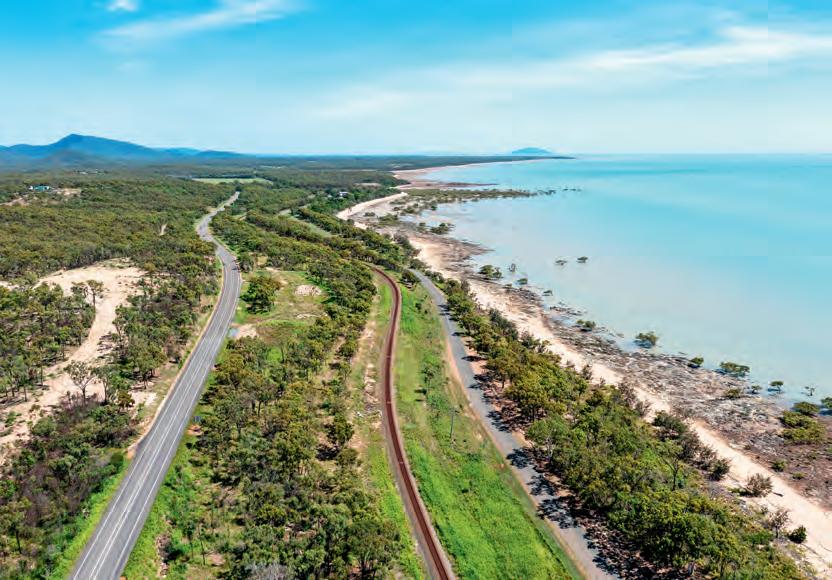
Wayne Sachs remembers the day he decided to take action. As a seasoned paramedic with more than 50 years of experience for the Queensland Ambulance Service, the numerous call outs to Gympie and the Bruce Highway for road tragedies had become too much. In February 2009, he went to Parliament House in Canberra to meet with the then infrastructure minister, Anthony Albanese.
“I went to the minister to talk about the fatalities on the Bruce Highway and the people that were suffering serious injuries over a long period of time with nothing being done,” he says.
“He spent a good hour with me in Parliament House that day, listening intently and acting. The Bruce moved from number 26 on the priority list to number one, and things got done almost immediately. I’m so very grateful for the minister taking it to Cabinet.”
By May that year, funding was announced for the Bruce Highway around Gympie. By September 3, the first sod was turned, with work starting on section B on the Cooroy to Curra stretch.
“There were 54 people killed just on that one little section, so the first 10 months of work was dedicated to it,” Sachs says.
“Since this has been done, the bypassing of Gympie has stopped fatalities in that area. You might get the odd bingle here and there, but this move has saved countless lives.”
Sachs was on hand nearly 16 years later when, in early January, Albanese, now the Prime Minister, made the trip to Wide Bay to announce the single largest investment ever made in the Bruce Highway. As part of the funding, $7.2 billion of the $9 billion required to improve the Bruce to a three-star safety rated highway will come from the federal government.
“This major announcement is amazing, just incredible,” Sachs says. “They’re saving thousands of lives. It’s a lot of money, but it’s worth it.”
The funding for the Bruce Highway can’t come at a better time. In 2024 alone, there were 41 fatalities from incidents on the Bruce. While 2025 has only just begun, there have been two fatalities already at the time of publication.
“This is why the Bruce Highway is such a priority,” Albanese says.
“This is a special piece of highway, but it’s also a dangerous piece of highway and it needs upgrading.
“What we’re doing is the right thing by the national interest, and that’s why the investment is being made.”
The $7.2 billion funding package includes fasttracking critical projects along the entire corridor, starting with priority sections north of Gympie such as Maryborough to Benaraby, Rockhampton to St Lawrence, Bowen to Townsville and Ingham to Innisfail. Projects will include installing safety barriers, wide centre lines and audio tactile line marking, as well as wider shoulders, increased run off areas, overtaking lanes, rest areas and improved intersections.
The announcement is significant in multiple ways. While it makes history as the largest ever investment made in the Bruce Highway, it also strays from the call made by federal transport and infrastructure minister Catherine King roughly 18 months ago to change road infrastructure funding to a 50:50 split model with state governments. On the Bruce Highway, the $7.2 billion funding means the federal government has returned to the previous 80:20 split.
“The Bruce Highway is unique – there was 50:50 funding in place with state governments when I was the infrastructure minister and we were able to completely duplicate the Pacific and Hume Highways,” Albanese says.
“However, if you look at the east coast, the Bruce Highway is the most important for further investment, so that’s why it stands out in requiring this unique response that we’re delivering.”
Currently, almost 45 per cent of the Bruce Highway achieves a two-star safety rating. By providing funding for more overtaking lanes, a larger central divider and central barriers, the federal government is hopeful of lowering road deaths on the 1,600km long highway.
“You’ll also see the straightening out of some of the more dangerous sections, as well as resealing works,” King says.
“This will make a significant difference to both road safety and productivity for the many trucks that carry freight along this spine of a road.”
For the Queensland government, the 80:20 funding arrangement announcement is a big win. Arriving just months after the new state government re-formed the Bruce Highway Advisory Council, transport and main roads minister Brent Mickelberg views the news as a “win for Queensland”.
“Queensland deserves better than a secondclass highway and that is why we are focused on delivering a safer and more reliable Bruce,” he says.
“One of my key priorities as transport and main roads minister is to deliver a long-term upgrade plan to bring the Bruce Highway up to safety standards.
“The return to an 80:20 funding split is a welcomed commitment from the federal government to enable our delivery of a safer Bruce.”
While the news was also welcomed by various transport bodies like the Queensland Trucking

Association (QTA), it wasn’t a complete cause for celebration. QTA CEO Gary Mahon was left pleased by the funding announced, but frustrated by the timeframes outlined by the federal government.
“We welcome it but we would’ve preferred the money to be spent over four years, not eight, so we can start seeing a material difference in the next couple of years,” he told OwnerDriver.
“Compare it to the work undertaken on the Curra to Gympie section that was 62km long and took 15 years to complete. For now, I’d love to hear of interim works occurring on standout sections where fatal crashes are happening.
“While the amount of work being done over hundreds of kilometres sounds very large, over eight years it doesn’t spread that far.”
On top of this, Mahon, through his involvement in the recently reformed Bruce Highway Advisory Council, is also pushing for the upgrades to include more new rest areas. While his interactions with Mickelberg lead him to believe that the state government may choose to go with dual lanes to future proof Queensland’s freight routes, he also wants to see drivers prioritised with roadside areas.
“We’ve had no reply on whether the Bruce and other major works currently underway like the Tiaro Bypass will include rest areas on both sides of the road,” he says.
“We’ve argued strongly for significant rest areas to be included on that bypass on both sides of the highway, but have had no clear commitments yet.”
While many celebrated the news, Mahon has been quick to look at the practicalities involved with such a large-scale infrastructure project. Well attuned to the needs of drivers taking the Bruce every day, he wants to see works clearly defined and underway this year.
“I’ve heard some remarks that works may start at the end of this year, but we need a commitment soon,” he says.
“I’d like to think that works get underway this year, but we’ll have to see what happens.”

When it comes to other stakeholders who have campaigned for more federal funding to upgrade the Bruce, the Royal Automobile Club of Queensland (RACQ) views the announcement as a resounding success. RACQ CEO David Carter says the win comes after months of “relentless evidence-based campaigning”.
“Right now, Queenslanders are three to five times more likely to be killed or seriously injured in a crash on the Bruce Highway compared to the Pacific Highway in New South Wales and Hume Highway in Victoria. It’s simply not fair,” he says.
“Queensland has 180,000km of roads and, while the 1,673km-long Bruce Highway makes up less than one per cent of that network, it accounts for more than 10 pe cent of the road toll.
“When New South Wales and Victoria had their major national highways fixed, the federal government covered at least 80 per cent of the funding needed, now it’s the Bruce’s turn for serious funding.”
However, Carter knows the Bruce won’t be immediately fixed. While the federal government has committed to begin works on the road as soon as possible, Carter has called for the industry to be aware of the constraints in place to getting this done.
“With Queensland’s projected population growth, getting the Bruce up to scratch is no quick fix. There will be ongoing upgrades required over many years,” he says.
“What we need now is to see these promises delivered and bipartisan support to do the work that’s required – a commitment beyond political cycles.”
Moving forward, Albanese says the next step is to work with the Queensland government to plan which priority projects begin first, and how the transformational upgrade will eventuate.
“I discussed with the Queensland Premier the priority projects – he certainly agreed Maryborough to Benaraby was the first priority,” he says.
“The total expenditure of that was $9 billion to lift the whole highway up to that level three of safety, and that’s where our $7.2 billion commitment comes from.
“We want to roll out as much works as possible as soon as possible. That is our objective.”
Opposite top: The federal government finally committed to unprecedented funding for the Bruce Highway in January
Opposite bottom: Gary Mahon believes a revamped freight network could revitalise Queensland’s trucking capabilities
Above: The industry has welcomed the funding, but specifics of where the safety upgrades will begin are still up in the air
Left: Recent fatalities and crashes have led to the $7.2 billion announcement for the Bruce Highway



A few years ago, Warren Aitken discovered an eye-catching UD at a truck show. Now, he’s caught up with the owner and learnt the fascinating story of Jessica Baker and her life in trucking

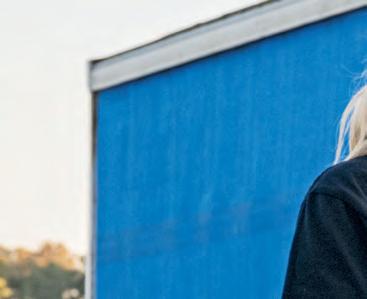








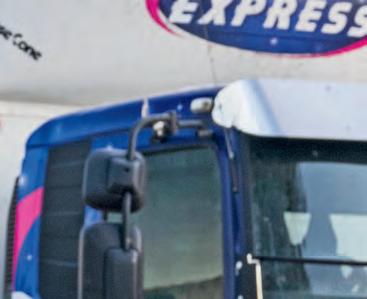

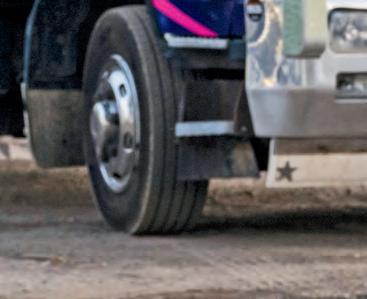

My apologies everyone, this story has been a long time coming. Years actually. I am pretty sure it was either 2020 or 2021 when I first met the lovely young Jessica at the Dane Ballinger Memorial Truck Show in Bathurst. I was absolutely captivated when circling the truck show and saw this beautiful little thing sitting down near the back of the show – the sun beaming down on it like a supersized spotlight. I was just drawn in.


As a photographer, I broke out the camera immediately, super keen to capture such beauty, with a heavenly glow to highlight the shot. Just when I was about to snap the perfect shot, Jessica Baker walked around the corner and ruined my shot. I couldn’t complain though – it was her little UD freight truck I was trying to photograph. Not that I knew it at the time, but Jessica was also walking around the truck admiring it, hence I figured she was just a fellow enthusiast like me, so I waited for her to move on so I could snap my shots. She proceeded to get into the little UD, and it all made sense. She was a truck lover like me and she was admiring how cool and colourful the UD was; however, she was doing it as the owner. I had to introduce myself and see if she would be interested in a story.










Four years later, here we are, finally getting to share Jessica’s story. Due mainly to my procrastination, it is a very different story to the one I would have told back in 2021. Back then young, Jessica was a one woman, one truck operation. In 2025, it is now a one woman, one partner and four truck operation. The origin story will be the same, but the progression of All Go Express has added three more trucks and a lot more work to Jessica’s expanding fleet.
Jessica Baker is a born and bred truckie. She grew up surrounded by trucks and with a toy cabinet devoid of Barbie dolls and devoted to all things trucking. Her parents were at the head of the table of their own family transport company, under the banner that Jessica would later use as All Go Express.
The family-owned business had one B-double, a trio of semis, a handful of rigids and about 60 contractors. Due to the sensitive nature of All Go Express’s contracts, the family’s trucks were kept very plain, very non-descript and without any signage.
What mum and dad carted was not of importance to Jessica as a kid. She just loved everything trucking.
“I used to love finishing school and going with dad, because most of his freight was transported at night,” Jessica says.
“I’d go to the warehouse and help him load trucks or wrap pallets or label stuff, I just loved that side of it.”
School was not her favoured vocation – she endured it – but working and following in mum and dad’s footsteps was where her heart lay.
“I went in a truck when I was like three months old,” she laughs as she tries to put a finger on when her passion first became evident.
“It was either three or six months, I have a photo somewhere.”
Whatever the age, that passion was flamed through her teenage years and into young adulthood. Even getting her driver’s licence while at high school became a trucking experience.
“With dad being in trucking when we did our Learners, that’s me and my brother and sister, we did it all in a three-tonne Mitsubishi Canter,” Jessica says.
“That’s how I learnt to drive, in a little Canter. Dad said it would be better for us because you sit up higher and have a better view, so that’s how I learnt to drive.”
It was after Jessica gained her licence that school became just a constraint of her day. She would turn up and do the work, but after school Jessica was already in the process of building her future.
“I took out a loan to buy a Sprinter van and I was contracting to mum and dad on the weekends and in school holidays,” she recalls.
“I also picked up some work delivering flowers as well, so I ran under Elegance by Jessica.”
That after-school job became the stepping stone for Jessica. The Sprinter van went from a weekend worker to a full-time gig for the young lady, and she was loving it. She continued to contract to All Go Express and continued to grow her own client list as well. It soon got to the point where the little Mercedes-Benz van couldn’t hold it all in and Jessica had to start re-evaluating her options.
“I really liked the idea of being my own boss, and loved the driving, so my dad convinced me to buy a truck and go bigger,” she says.
“I got a loan and went looking for the perfect truck and I found the UD, which had 100,000km on it, but was in great condition and I bought it.”
When Jessica purchased the UD, her company was still running under Elegance by Jessica. Her parents had the All Go Express banner with their company, as they had for 25 years.
Above: Jessica and her dad with Jess’ ‘I just like it’ truck in the
Below: I did make it clear there wasn’t anything Jessica wouldn’t have a go at carting, right? The little UD has seen just about everything under the All Go Express title

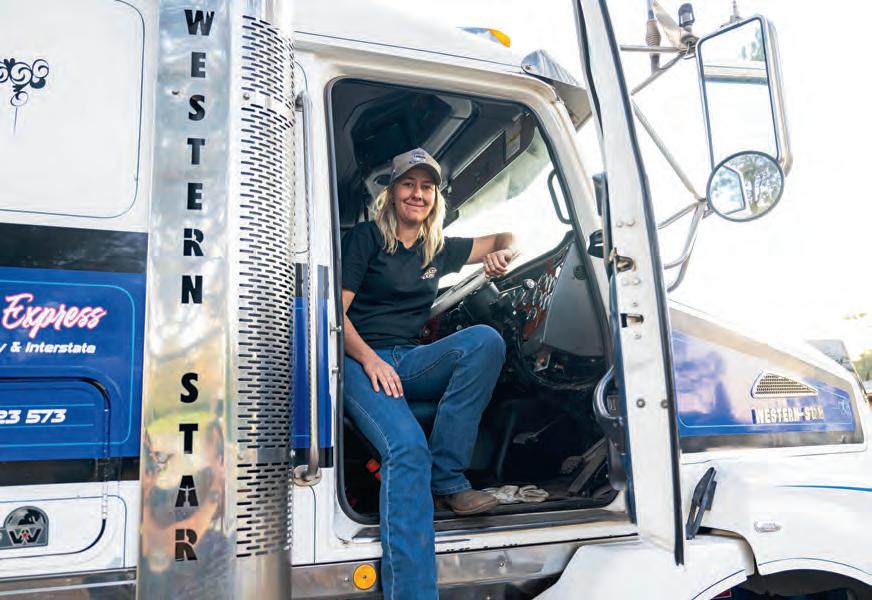

Top: Jessica will never say a bad word about her UD, but quietly admits that she loves driving the Western Star 5800 truck and dog
Above, L to R: Being in the transport industry, dealing with load challenges, long hours and all the pros and cons is exactly where Jessica has always wanted to be. Her success with All GO Express is a reflection of her work ethic; One of her first jobs with the new second hand 5800 was carting hay, it was a learning curve for Jessica but one in which she thrived
Below: The latest addition to the fleet is this immaculate Western Star 4900. The flat roof and big CAT make it another favourite for Jessica to get out and about in
Opposite top: There is no slowing this trucking lady down. Starting with the Sprinter van in school, to now having a full fleet in her backyard, young Jessica Baker is following her passion and kicking goals with each load
Opposite middle: The advantage of the 5800 Western Star is the ability to throw the dog trailer on and extend the loading capacity. This was one of the more varied loads she’s had, this time working alongside her partner Michael

Jessica continued contracting to them and picking up a little work of her own on the side.
Then everything changed; after decades in the transport game, Jessica’s parents decided to pull up stumps and enjoy some time off. It was a well-earned retirement for Carmen and Warwick, but it could’ve been a major hurdle for Jessica. While she had built a small list of private clients, the majority of her work was still with the All Go Express contract.
The young lady didn’t let it phase her. She was never shy of doing work, and when needed she showed she was never shy of chasing it either. Soon enough, she had found more contract work for her little UD, although this time not under her Elegance by Jessica business name. Instead, as a tribute to the history her parents had forged, Jessica took over the All Go Express name

and reimagined her little UD as a moving memorial to her parents’ company, complete with Aussie flag artwork over her little workhorse.
“I got a little bit scared when mum and dad got out, because I had a loan over my head and now I was having to go out on my own and find more work,” she says.
“But I just carried on and found something else.”
That work initially came from Minto Based RevTrans, who had Jessica doing a lot of local Sydney work. The Revtrans work soon gave way to work with Komatsu, carting parts to mines all around New South Wales.
“The Komatsu work was very different, mainly very heavy, with solid sprockets and things to various mines,” she recalls.
“When I was doing the flowers and pharmaceuticals it was all really light, now all of a sudden it was extremely heavy.”
The Komatsu work really was the lead-in to where Jessica is now. At the time, the Komatsu deal meant she was unable to cart any other freight out of Sydney. This was fine – she would head north-west out of Sydney, covering mines as far up as Mudgee. Jessica built solid relationships with many of



the businesses on those routes and was soon getting work coming back to Sydney as well. By the time the Komatsu work finished upl Jessica had massive support from businesses in the Mudgee, Dubbo and Bathurst areas and her little UD was running flat out every day.
It seems many businesses were loving the personal touch and friendly personality that Jessica hit the road with every day. Her love of trucking and enjoyment of being her own boss shone through with her service and this, in turn, was reflected in the work she was picking up.
The downside of a strong work ethic and happy customers, paired with one small UD to do all the work, is that eventually it becomes too much. This led to the expansion of the fleet. As you will pick up in the photos, there are now four trucks in the All Go Express fleet, the ‘OG’ being Jessica’s UD. It’s still the busiest of the fleet, however, now Jessica also has her 5800 Western Star truck and dog to help.
“I bought the 5800 because it was a really good set up,” she says.
“The truck would allow me to get the heavier stuff I wasn’t able to get on the UD and, if it was really busy, I would have the dog trailer to load up as well.”
She was also quick to point out that her tarping and tie-down knowledge was extremely limited when she purchased the flat top set up.
“I had never dealt with tarps or anything and wasn’t going to until a guy saw my set-up and asked if I could cart some hay for him,” she says.
As is the young lady’s mentality, Jessica didn’t hesitate to increase her skills resume. She went and bought a set of tarps and proceeded to learn all she could about loading and tarping flat tops. As for the Western Star itself, it’s now her favourite truck to drive, as it has a CAT in it too that she loves.
Her latest acquisition is another Western Star, this time a flat roof 4900 with a C15 underneath.
“We picked up some work that will require a drop deck and, at the moment, we kind of have the horse without the cart,” she says.
“I saw the Star for sale – I love flat roofs and I love CAT motors – so we grabbed it.”
You will notice I have moved to ‘we’ now rather than ‘I’. That is because Jessica’s partner Michael is a big part of the company these days. If he isn’t covered in grease and oil servicing one of the trucks, he is most likely behind the wheel of one helping to get all the work covered. Jessica has come a long way from weekends in a Sprinter van – she now has
multiple vehicles and dozens of loyal clients that support her due in large part to the enthusiasm she has for her craft and industry.
I could rabbit on about her drive and passion, however I think it is best summed up by focusing on the final vehicle in the fleet photo, the one we haven’t talked about yet in the Kenworth K123 with its whopping great Texas bumper.
“Honestly, I bought that because it just looked cool,” she admits.
“I tell people it’s a project truck, which it is, but I saw it sitting in a paddock doing nothing and I love flat roofs. Then I saw it had a CAT in it and I just wanted it, simple as that, it’s a cool truck. I’ll use it for hay runs or something, but I just loved it, so I bought it.”
It is that passion for trucking that has seen Jessica shine and thrive. The pride she had in her UD that first time I met her has never diminished. She loves her trucks and loves her job, and that is inspiring. She is not afraid of work – the fact that she’s put nearly three-quarters of a million kilometres on her UD shows that. I’ll leave the final word to her.
“I love trucks, and its not a matter of if you are male or female, if you love trucks anyone can do it. It’s a great industry to be part of,” she says.
SEND YOUR LETTERS TO:
Letters to the Editor need to be typed or clearly handwritten and be no more than 500 words. Letters should include name, title (e.g. owner-driver, manager) and city for publication, unless otherwise requested. Letters may be edited for clarity or space.
Sean.Mortell@primecreative.com.au or 379 Docklands Drive, Docklands, VIC 3008
We prefer letters by e-mail, but handwritten letters will be accorded the same opportunity to be published.

HVNL review
If you drive or operate on the east coast and if you haven’t read the HVNL penalties review, you should. It is a manifesto of the intent of complete control of an industry by the NHVR – in fact, every driver and operator should take a week off and read the whole HVNL – it is educational reading, it shows that the intent is again to further discriminate an industry and breach the constitution and deny drivers rights under the rule of law.
What it tells us is that our submissions to the NTC/NHVR review in 2019 was a waste of time. The 12 non-driving offense penalties will stay and increase and 50 other fines will increase to Draconian amounts. The NTC made an undertaking to meet with stakeholders to discuss the review but it never happened.
Drivers and operators will need to take every infringement to court or it will cost them dearly, even if they have to lose a trip. Solicitors advocate the law, but defendants will need to take their own fatigue experts to give evidence and their own industry experts to argue against enforcement opinions.
Being infringed for a fatigue provision is an offence against a provision of the Act S223 and S228, but is not evidence of a driver driving while fatigued unless you act or look or open your mouth to enforcement authorities when we are stopped. Unlike in movies, fatigue is an opinion by enforcement in Australia. Personally, after 65 years in the job, I would argue any driver using BFM or AFM could be fatigued at any time and the provisions should be rescinded.
Every driver needs to seek advice from their solicitors and accountants on how to divest all their assets that they have worked hard for, and company directors need to adopt asset protection for themselves and for the
trading company, which we were forced to do 50 years ago.
Jerry Brown-Sarre
To prevent the carnage on the Hume Highway it is essential for these things to happen:
• pavement maintenance to be significantly improved including complete replacement of the pavement 10kms either side of Marulan both north and southbound
• no further high productivity vehicles to enter service until all significant grade sections be upgraded to three lane
• i mprove driver safety by significantly increasing the frontal collision resistance of all heavy vehicles (including buses), resulting from rear ending a slower moving lead
involving intersections with B and C class secondary roads
• a ll entrances to private properties to utilise offset medium strip roundabouts or be accessed by a parallel full length service road both south and northbound
• t he present ‘Dog on the Tucker Box’ service facility should only be accessed by north bound traffic
• t he present ‘Dog on the Tucker Box’ service facility should be duplicated on the east side of the highway to cater for southbound traffic
• t he Coolac Mobile service centre (temporarily closed) should gain, more or less, additional direct access to and from the north bound lane
• L indsay Bros Transport and other road haulage operators should not use the Kyeamba Gap Rest Area as a driver/prime mover
“Just a brief list of the undersigned’s New Year wishes for improved road safety.”
heavy vehicle (this frontal impact protection requirement will require a new ADR)
• r ight hand turns from Hume Highway southbound to Lachlan Valley Way, Bowning or Burley Griffin Way should be eliminated by a flyover just south of the present Yass Valley Way flyover by a service road, incorporating an extension and upgrades of Walls Junction Road and Red Hill Road (both roads which are suitably presently north of the highway in the vicinity)
• a ll traffic flows presently cutting through on traffic to be replaced by flyovers or offset medium strip roundabouts especially those
changeover site (as it is illegal to drive across or on a medium strip unless entering into a public road or private entrance)
• To increase the number and heavy vehicle capacity of both north and southbound ‘drive through layout’ shaded rest areas complemented with international standard exit lanes from and merging lanes to the through traffic lanes
Just a brief list of the undersigned’s New Year wishes for improved road safety, especially heavy vehicle driver safety, on the Hume Highway.
Arnold McLean, Keiraville, NSW

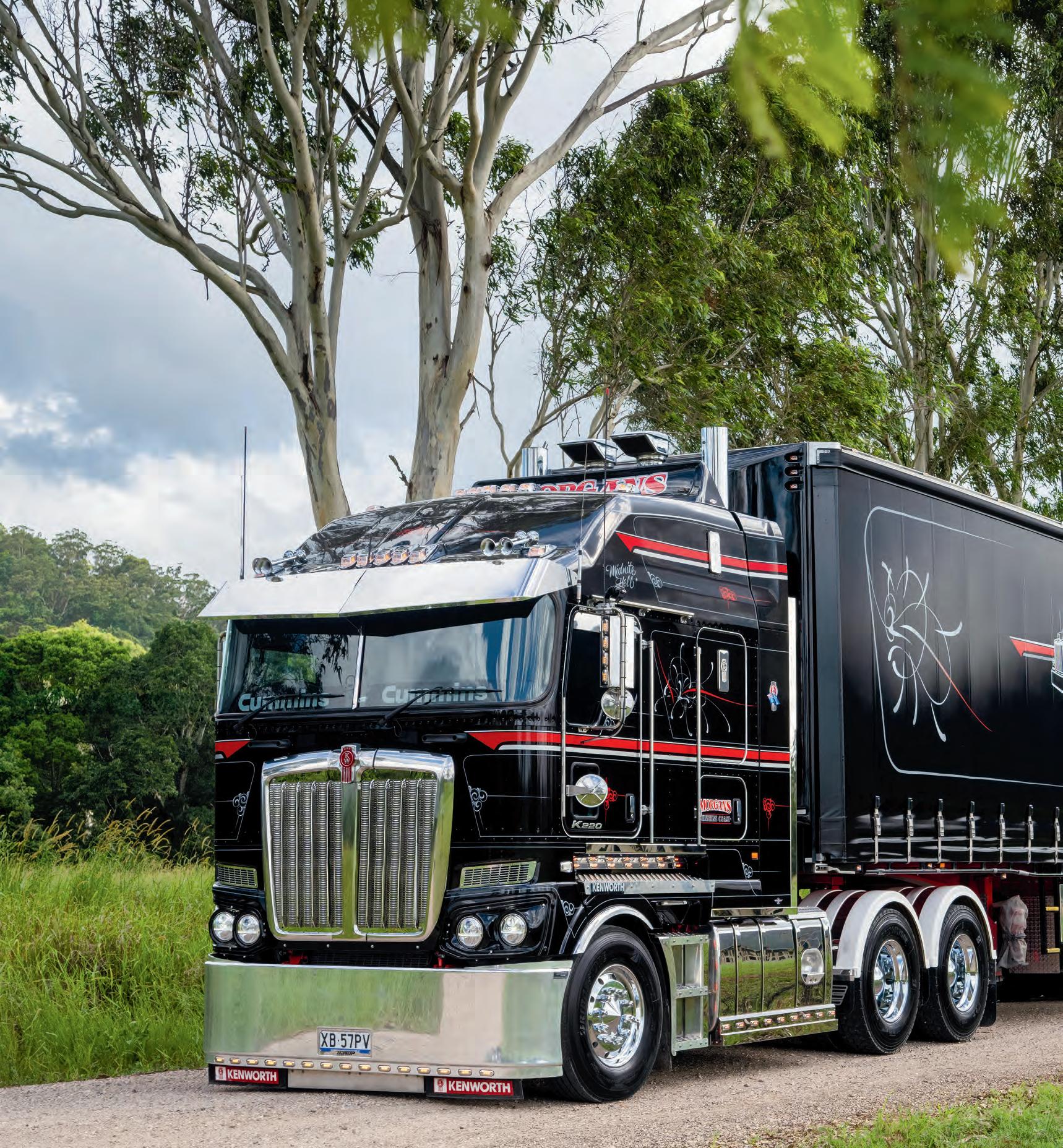
Michael Jordan and Craig Tesch. It may seem like I am drawing a pretty long bow when I place these two individuals in the same sentence – after all, one is a 6’6 GOAT who played over 1000 NBA games, averaging more than 30 points per game, while the other is a little less than 6’6 with zero NBA games and subsequently averaging a lot less. Where they do cross paths is in their approach and attitude.
I recently had the privilege of sitting down with Craig Tesch to discuss his stunning new Kenworth K220 and learn about the family
business he is a part of in Morgans Long Distance Transport. It was during this meeting that I drew the line between the two men, with one particular Michael Jordan quote coming to mind.
‘I truly love the game; I wouldn’t be playing if I didn’t love the game.’ While Michael was referring to his life in basketball, this quote holds sway over everything in Craig’s life, from the family company he grew up with that has now become his own family company to his career. It is a quote that holds true to everything Craig has thrown himself into and has now resulted in arguably one of the coolest looking units on Australia’s vast highways.
As is my usual style, before we take a look at the stunning piece of machinery on the pages before you, we need to a cruise down memory lane and lay the groundwork for this impressive K220. I will try and condense it down a bit, but to be honest I won’t be trying hard – there is so much history behind Morgans Longs Distance Transport, so many amazing characters and so many old school outlooks, that I don’t want to glance over it all. We need to start with the man that began it all back in 1973 – Lawrie Morgan. I shouldn’t say ‘the man that began it all’ because it wasn’t a one-man operation. It was the power couple, Lawrie and Dulcie Morgan that












Warren Aitken was able to track down a stunning new Kenworth K220 owned by Craig Tesch and Morgans Long Distance Transport. He soon learnt the truck was just a small part of a wonderful family tale



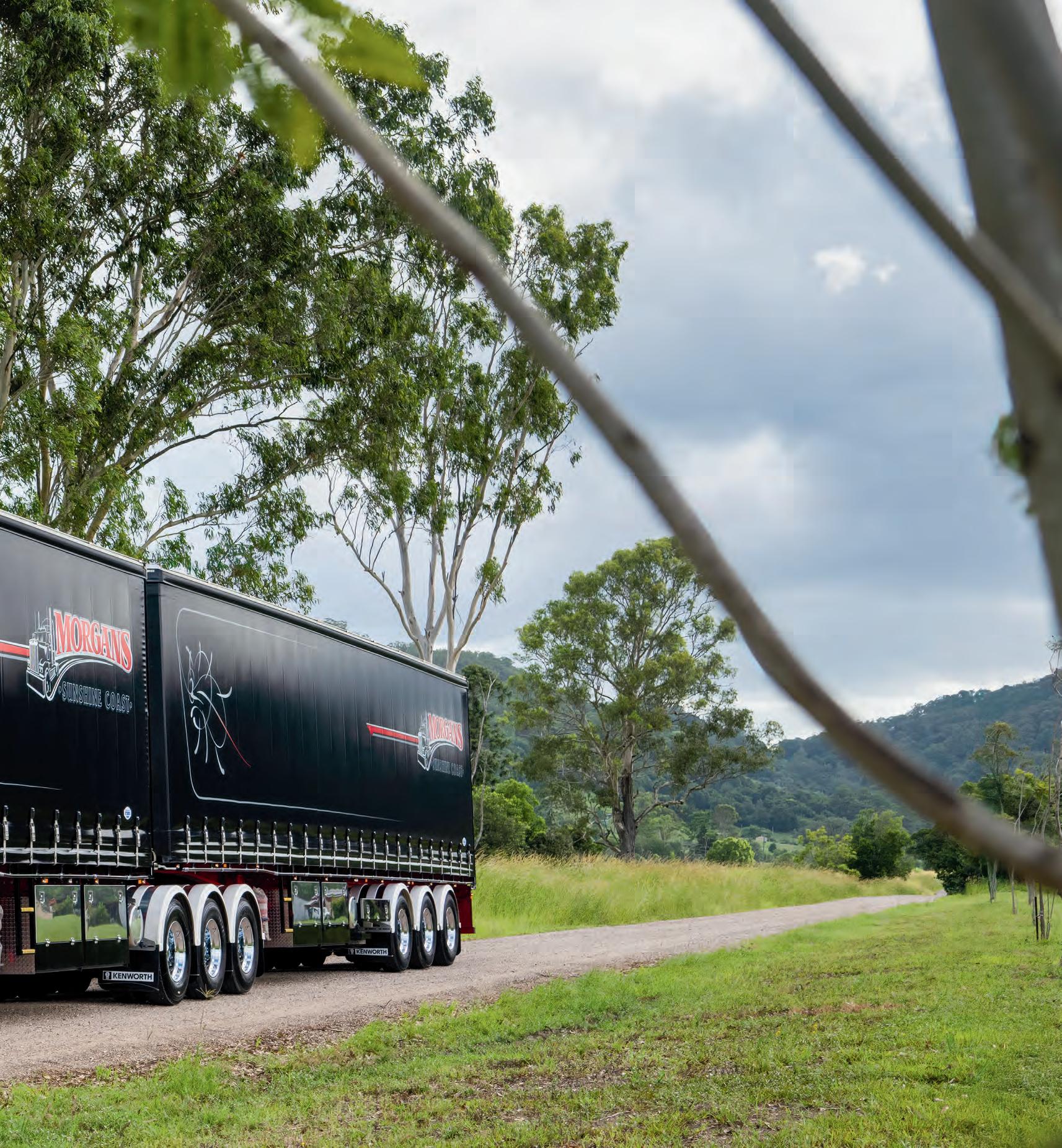
started Morgans Suncoast Freighters, a family transport company whose current reincarnation is Morgans Long Distance Transport. Lawrie and Dulcie began back in 1973 with an old Cummins powered V8 Acco and Haulmark Bogie flat top. Lawrie was carting cement and timber from Gympie down into Brisbane. His ability to deliver great service with a friendly and professional approach saw him rapidly increase his workload and subsequently his delivery radius. Within four years the fleet had quadrupled, with a MAN and a couple of Mercedes-Benz models joining the Acco. More trucks and more work eventually led to Lawrie and Dulcie relocating to a new depot in
Maroochydore on the Sunshine Coast.
As business grew and intra and interstate work became a part of the family business, there was a need for a Brisbane depot as well, and Morgans Suncoast Freighters moved in with McClintock’s Transport in Rocklea. There was a solid mix of trucks in the Morgans stables now, including International S-lines and T-Lines that joined Volvos, MANs, Mercedes-Benz models and an array of others. The Sunshine Coast work was building and the interstate work was thriving.
During this growth period for Morgans Suncoast Freighters, there were plenty of employees added to the books, with Lawrie’s
family approach to his drivers being a leading incentive for his workers. The work was never easy, but the workers felt valued and appreciated. This led to a lot of long-term workers on the Morgans’ books, matched by a lot of long term clients. It was all due to the same reason – it was a very family friendly culture that Lawrie and Dulcie were cultivating.
It was this culture that led to Craig’s dad Gordon joining the employee registry all the way back in 1984.
“Dad had been actually working for Buntines up in the Northern Territory. He was driving road trains hauling cattle from station to station


















in an old 280hp W-model Kenworth,” Craig says.
“Then when mum had me, she wanted him closer to home, so he took a job with Morgans.”
It would have been a hell of change, from the rough open terrain of the NT with a couple of trailers of stock hanging off the back to local work delivering timber in an old Mercedes-Benz. However, that family philosophy that Lawrie and Dulcie were fostering was a driving factor in Gordon and Lyns’ move from the wilds of the Northern Territory to the Sunshine Coast.
Craig’s arrival on this planet came around the same time as Gordon’s position at Morgans Suncoast Freighters began. While his first experience with trucks isn’t officially remembered, Morgans Transport placed a huge emphasis on family and the yard was often the epicentre of family activities. Weekends and after schools would often see drivers’ kids hanging around the yard, so it’s fair to assume Craig was indoctrinated from day one.
“Me and my siblings grew up in and around trucks,” he says.
“We’d go for trips when dad was driving for Morgans – we’d be hanging out there on school holidays, sweeping the yard, stacking pallets and getting up to mischief with the other drivers kids.”
It is the kind of upbringing many of us can
“We’d go for trips when dad was driving for Morgans – we’d be hanging out there on school holidays, sweeping the yard, stacking pallets and getting up to mischief with the other drivers’ kids.”
relate to and many of us wish we could introduce our kids to now.
While Craig was cutting his teeth on all things transport at Morgans, his dad was also learning so much from the same people.
“Lawrie had a great bunch of drivers, mainly older than myself,” Gordon Tesch says.
“They would teach me a lot about loading and tying your load down so it got to the customers with no damage, which meant a lot. I was lucky enough to have learnt so much from those older drivers and it has stayed with me.
“Lawrie and Dulcie were very good to their drivers, so much so that a lot of their older drivers still stay in contact – it says a lot about them.”
After almost 10 years as a company driver, the opportunity arose for Gordon to purchase his own truck.
“In 1994 I had the chance to buy my own truck, it was a 1989 4800 Western Star and I towed one of Lawrie’s trailers,” he says.
“With a young family to feed, it was a hard slog – a lot of working day and night and most weekends. Sunday was usually greasing and washing. It wasn’t much fun for the family, but it had to be done.”
The hard work did pay off – soon Gordon purchased his first brand new trailer.



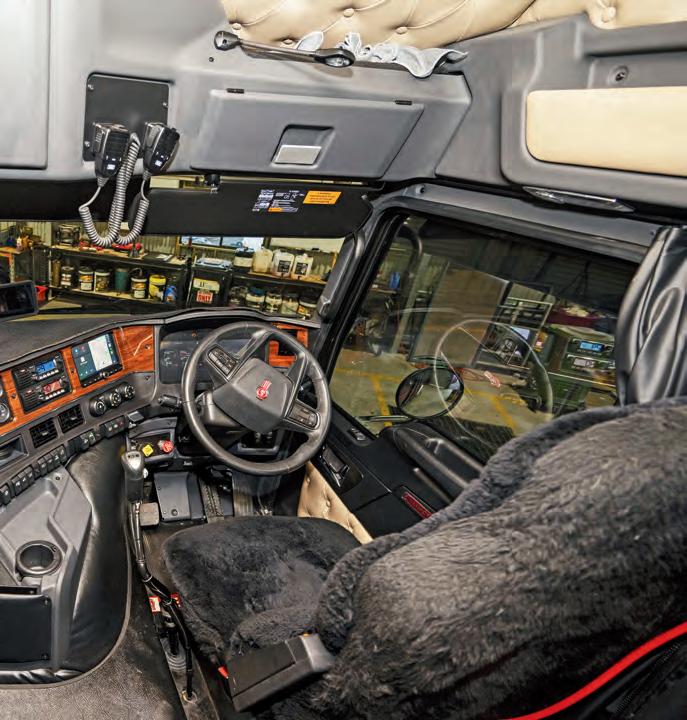

“It was very exciting when I bought the Freighter Tautliner as it saved a lot of time not having to tarp everything,” he says.
As I pointed out a couple of paragraphs ago, Morgans Sunstate Freighters kept growing as the work rolled in. Subsequently, Gordon and Tesch Transport also benefited. Soon he had two trucks towing for Morgans as well as work that Gordon had picked up himself.
In 2005, with one eye on a well-deserved retirement, Lawrie and Dulcie decided to sell Morgans Suncoast Freighters. All the local work got sold to Peter Carter of Carters Transport and Lawrie only just held onto one of his linehaul trucks. During the sale procedure, Lawrie approached Gordon about forming a new company that
Left and far left: The biggest change with the new Kenworths is the change to fully electronic dash boards; Crabby jumped out of a K200 for the K220 and observed that there seems to be a lot more headroom around the driver in the new model. There is still plenty of storage space too
Opposite top: One of the stalwarts of the Morgans Sunstate Freighters was the old MANs; When Gordon put his stunning Western Star on the road it was well before phone cameras, so finding shots of this epic rig is difficult. We did find this one of the big Star resting at home; I would love to tell you what year this fleet photo was taken but memories have faded a lot – as you can see by the old Nissan and T-lines it was a fair while ago




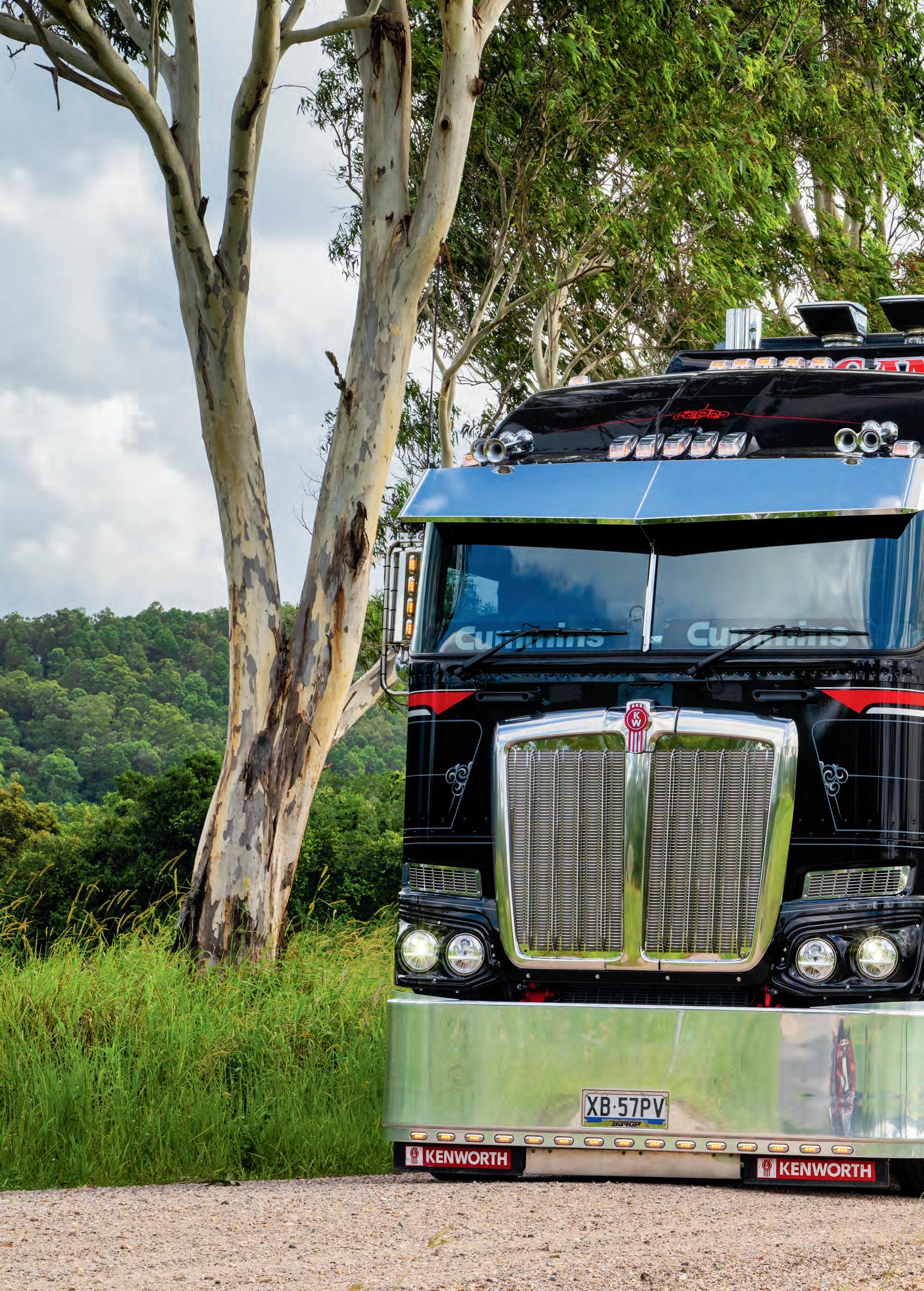




focused more on the linehaul work. Gordon was keen to learn and Lawrie was keen to pass on his experience, hence the creation of Morgans Long Distance Transport.
That’s a rough summary of the first three decades of the Morgan dynasty. Between Lawrie and Gordon, there would be several books worth of stories and adventures that could be and should be absorbed. Unfortunately, I don’t have the space here to be able to share, but I will work on it. For now, we will focus on the man of the moment in Gordon and Lyns’ first born Craig Tesch.
You should have an idea of the type of bloke Craig is by the opening quote I used. I had the pleasure of annoying him all afternoon for photos, then over an hour in the office for an interview and not once did he lose his enthusiasm for all things trucks and family. He is a bloke that truly loves what he does – he has a huge passion for trucks and gets his joy from working, be it behind the wheel, a desk or the tools.
Growing up in Morgans Transport’s yard fuelled his love of trucking, but it was actually the mechanical side of
“We needed a B-double unit and one that works with a 34 pallet set.”
Above: The man, the myth, the legend – Craig ‘Crabby’ Outtrim is the long time Morgans driver given the responsibility of piloting this beast of a truck, and he does it with pride and passion. There’s rumours he’ll detour his run just to avoid puddles, that’s dedication
Below: Craig and the team opted for the big bed bunk with their new cabover and when it comes to big bunks, K220 big cabs nail that
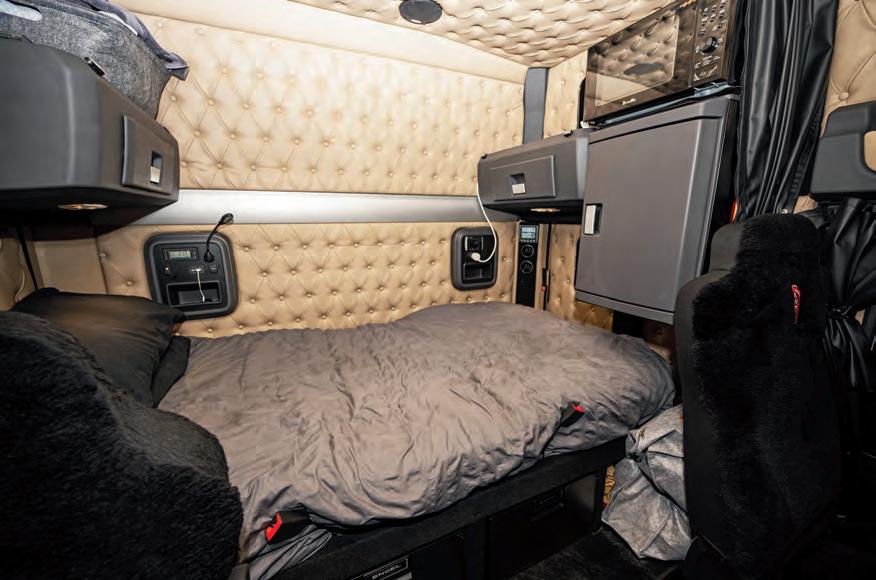
things that took hold of Craig first. Upon leaving school, he undertook a heavy diesel apprenticeship with Brown and Hurly in Darra.
“When I first started there, I was such a massive truck fan and we got to see all the cool gear coming into Brown & Hurley,” he says.
“I’d end up getting all starry-eyed admiring this cool gear until someone would yell at me to get back down and do some work.”
While he was at Brown & Hurley learning his trade, he made sure he took the opportunity to gain his heavy vehicle licence.
“We’d have to do the test drives and that as well, so I got my licence that way because I knew I also wanted to do some driving,” he says.
Craig did eight years with Brown & Hurley before taking a chance to chase some driving work.
“I’d always wanted to drive and I took a job in the workshop at Lindsay Transport hoping I’d get some experience there,” he recalls.
“Lindsays was good for the fact I had to learn new skills, working on trailers, fridge vans and even helping the tyre fitters, but the first truck I drove was actually for Tympats –he was known for giving young guys a go.”
After a couple of Gladstone runs, the bug well and truly bit Craig and he was hooked. His driving career was underway. Remember what I mentioned earlier about Craig doing what he does because he loves it? I should also have shone a light on the work ethic of this generational truckie. While Craig was flat out in Brown & Hurley’s workshop, or Lindsay’s workshop, or behind the wheel of a flat out Tympat truck, he was also a main mechanic for Morgans Transport. Every Saturday was spent servicing the fleet up on the sunshine coast.
Even when his driving career took off and he was a regular in the old SBA Kenworths, weekends were still


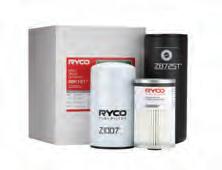
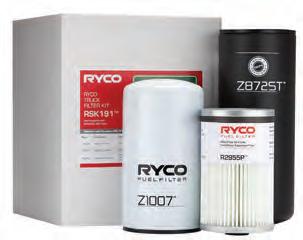
When you choose Ryco, you’re not just buying a part.
You’re buying round-the-clock technical support, market-leading innovation, and unparalleled filtration expertise. Ryco’s Commercial Filter Range includes oil, fuel, air, coolant, crankcase, cabin air, AdBlue urea filters, transmission and Service Kits for a large range of popular North American, European and Japanese Trucks. So when your customers need superior protection, be Ryco Ready.




SCAN TO FIND FILTERS FOR YOUR TRUCK.
FILTERS TO SUIT ‘TRUCK OF THE MONTH’: Kenworth K220









Above: Don’t worry about the mudflaps, we had the bags dropped for photo purposes. The point of this shot is to show the impressive custom wrapped rear bar from Rocklea Truck Electrical
Right: The rear gantry with stainless straight cuts right through was another Brock addition that fits perfectly with the new K220
Below: While the K220 was the first black addition to the fleet, it was very closely followed by another. The stunning T909 came dressed in a similar suit to the cabover
Opposite middle: It’s the little details that really emphasis the effort put into the new Morgans’ truck, like the custom Morgans cut in between the drives

spent on the tools. When he tried his hand driving for Morgans, weekends were still on the tools. When he started his own mobile mechanics, Shift Transtech, obviously then he was still on the tools, but then his off season was behind the wheel. Needless to say, Craig loves to work and loves the work he does, hence why in 2018, when Lawrie and Dulcie truly decided to embrace the retirement concept, Craig and his very tolerant wife Nicole decided to buy into the business with his mum and dad. Morgans Long Distance

Transport became a fully Tesch family operation.
I must apologise, because I am sure I have not done neither Lawrie, Dulcie, Gordon, Lyn, Craig and Nicole enough justice by trying to condense decades worth of enthusiasm, hard work, professionalism and dedication into so few words. If you take nothing else from this, I just need you to understand all three entities have grown up and implemented the same core values when it comes to trucking. It’s a family thing; your workers are your backbone and hard work pays off. Now I really need to shift focus to this Kenworth that just oozes cool.
If you have seen a Morgans’ truck on the roads, you know that black is not their colour. Looking good is their thing but it is normally done in a straight white suit with plenty of scroll work and a touch of red running through. They are also heavily invested in single trailer work and dominated by the big bonnets of the Western Stars and Kenworths. A K220 was quite the shift, much less a black one.
“We needed a B-double unit and one that works with a 34 pallet set,” Craig says.
“We’ve never had a brand new cabover, we’ve had a few 909s, but never a cabover, so we ordered the full set up. Then one night, me and the old man were having a few and just thought ‘f**k it, let’s go black’.”
That is the simplified and raw answer for all those asking why this truck is different and what its significance is. As Craig summed it up, he just wanted it. The problem with the written word is that sometimes it’s difficult to communicate tone and context.
I had the pleasure of heading to see Craig’s company and hence understood his motivation for the truck was the result of his passion for trucks, his love of cool-looking set-ups and his appreciation for Kenworth. I also loved his honesty, as he said the truck could also acknowledge the seven years he and Nicole have been a part of Morgans, but it could also celebrate the 20 years his parents have also been part of Morgans as well as paying homage to the Morgans’ 50th anniversary. All of those are valid, and even true, however sometimes you just want a cool truck, and the K220 nails that.
A lot of the credit for this truck falls at the feet of Brock and the Rocklea Truck Electrical team.
“When Nicole and I first bought into the company with
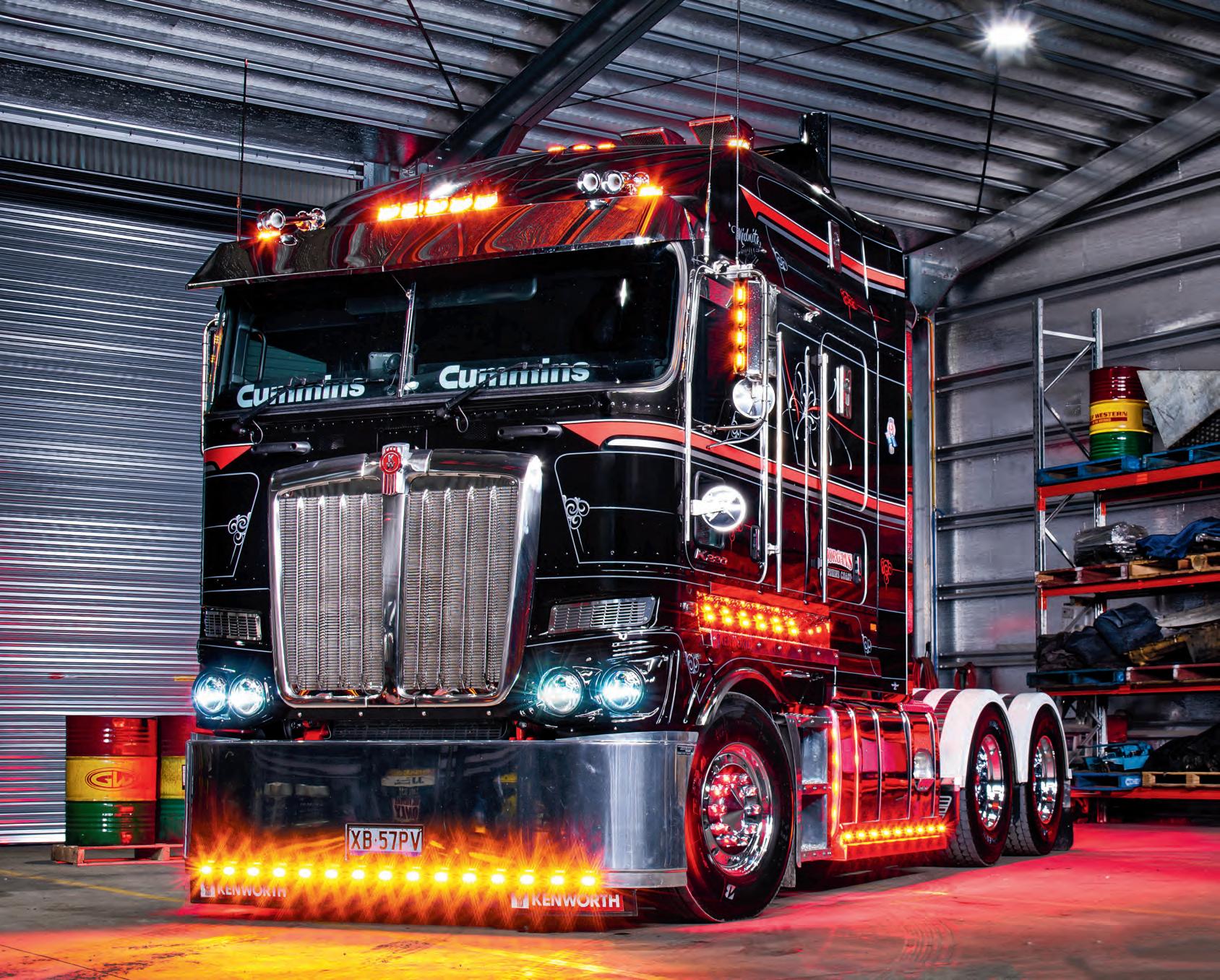
“Brock just knows what looks good and works, so with this one, I had a couple of ideas, but basically just left Brock to do what he thought looked cool.”
dad, to celebrate we bought our first new truck in a 409SAR named ‘For the Hell of It,” Craig says.
“Through Brown & Hurley, we were introduced to Brock at RTE and he did all the custom work and made it look awesome. Brock just knows what looks good and works, so with this one, I had a couple of ideas, but basically just left Brock to do what he thought looked cool.”
When dealing with a company like Rocklea Truck Electrical, they have more than a bit of experience in making trucks look cool. Specifically, they know how to let owners know if their ideas will work.
“I remember talking to Brock about my vision, saying we should paint the visor and stuff, and he just said ‘leave it with me mate’,” Craig says with a smile.
“Then I went in there a couple weeks later and it was a stainless visor – he’d installed chrome air cleaners down to the pre-cleaners (they had originally been red) and I didn’t think of it. I saw it and thought it was sick – Brock had a vision
and he made it work.”
There was some more subtle alterations from the RTE crew as well, like a whole new design for the cab wings. The new K220s have a bit of a pitched end so RTE designed a new wing that runs parallel to the fuel tanks and looks much tidier. The choice to stick with the white guards was something Craig was firm on.
“I wanted the white guards because that’s what we had on the trailers,” he says.
“As a whole unit, it stands out more than with stainless guards.”
Look at the photos and tell me he’s wrong, I dare you.
Another player that deserves a big round of applause is the legendary Tony Gibbs from Truckwriters, who was let loose with his brushes and skills. He subsequently brought a lot of the red lines that are symbolic of the Morgans trucks onto the black base while adding in a mix of scroll work that break the big cab K220 up perfectly. Craig is very quick to acknowledge

all of those that have played a part in this epic build, from doyen of diesel and Brown & Hurley salesman Jim Boler to Nathan Tomkins at Trailer Sales who worked hand-in-hand with Fleetmark to ensure the 34 pallet B-double set looks as sharp as the pilot vehicle.
The end result is an amazing working work of art, designed and motivated by a family who still hold family days at the yard, still hire school kids to come and wash trucks in the weekends and who have a staff of mechanics that have progressed from those same truck washing weekends. It is a family company determined to share their joy and passion and have chosen to do that with arguably the coolest looking K220 around.
I shall end by just reiterating the quote that may have come from the GOAT, but it resonates through and through with Craig Tesch and his team.
‘I truly love the game; I wouldn’t be playing if I didn’t love the game.’


Rod Hannifey gives his experience of some recent road conditions and queries how the industry can push regulators and governments to upgrade dangerous sections
Goodaye all, a new year is upon us and what will it bring?
Thus far it has brought more bad roads if any of you have travelled from Brisbane out over the Gap, 10km of rough surface 60kph signs as the road falls apart underneath us. Overall though, I generally think this is still a better road than the National Highway, the Gore via Toowoomba.
Any of you who have seen my Facebook page ‘National Highway or National Disgrace’ which has photos of the first three creeks/bridges as you head north out of Gundi towards Toowoomba, (though yes there is finally major work upgrading the last of that three) may well agree about how we can have a national highway with such narrow and potentially unsafe bridges on it?
I will thank TMR for levelling and repairing the shoulder opposite the BP at Captains Mountain. They had been doing some work just south of there and I rang to complain about signs and lights left in place when the road seemed to have been fixed and when they rang me back to discuss, I asked
if something could be done. The holes at that time were pretty savage and deep – you had to nearly stop on the road and then pull off, you could not get a decent run out of the bay, as you are then merging into 100kph traffic. Much better now, thanks!
To those who make the effort to “call” when leaving the mountain, particularly when they are loaded and pulling out from the parking on site, well done. In many ways, there are so few spots now where this is really needed and occasionally someone will call out of Suttons Forest, for example, and they either get a snide comment or ignored. Onto a major highway with a merging lane, even if there’s lots of traffic or fully loaded, is not the same as crossing a major highway blind in both directions pulling out of an uphill slope at 100 tonne or more.
The ’call’ signs for the narrow bridges on the Gregory Development road and then into Townsville as well are sometimes needed but mostly worthy, but then some are wider and have better site distance and may seem unnecessary unless you have met a wide load there. The one at the

ROD HANNIFEY, a transport safety advocate, has been involved in raising the profile of the industry, conducting highway truck audits, the Blue Reflector Trial for informal parking bays on the Newell, the ‘Truckies on Road Code’, the national 1800 number for road repairs proposal, and the Better Roadside Rest Areas Group. Rod is the current president of the NRFA. Contact Rod on 0428 120 560, e-mail rod.hannifey@bigpond. com or visit www.truckright.com.au

northbound entry to Roma seems to be overkill.
Of course, on the other side of that are places that need such signage and yet there is none. It makes you wonder who controls such things and if they really understand trucks? I would really like to know how many road agencies actually have anyone with truck knowledge working for them now.
So do you have a place that needs a ‘Trucks Call’ sign? Have you raised it with anyone, your local state, federal or council rep, your industry association or even just your state incident call number? If you see the problem, but haven’t raised it, why not? Is it too hard, or you don’t know where to start? Let us know if you have raised it and got something done, perhaps that will inspire others.
Years ago, it was a requirement for some departments, particularly where you had truck issues, that some staff had to have some awareness, if not a licence or on-road experience, before you could advise or be in charge of such projects.
Still, here we are with many major projects which can and do have major impacts on trucks and not only the businesses behind them, but the drivers as well, though from where I sit, little or no real input at times. Putting out a document that no one will ever see or read and then saying you have “consulted with industry” seems to cover someone’s backside well enough to escape further scrutiny and have such projects approved, only when completed to have us say “what about this” or “who was consulted about this?”.
How likely is this to change and can the NHVR do more in this space? They do not and never have had responsibility for truck rest areas, yet we all hope they truly recognise the importance and value of not just somewhere to park when tired, but a place where you can actually get good rest and sleep.
But they too have their hands tied in dealing with all the different states, bodies, councils and others, but what can be done to see that change? We certainly want them to do certain things, but they can’t do it all alone, so can we help them to help us more and how do we do that? Doing it on your own can certainly be daunting, to say the least.
I can make a list of things where I have had bits of road fixed, potholes filled and signs changed, but I don’t drive every road and if you spend much of your time on one or a few, you as a frequent user have the knowledge and awareness of the problems. But they won’t get fixed unless you tell someone, will they?
I have had people suggest SNAP Send, but there are two problems for us. One is you should not be trying to take a photo while driving and that could well earn you a ticket. Secondly, you mostly just can’t park your truck and walk back for the photo, so for now, use the incident numbers you see on your state billboards and we will make a list for you for next month. Till then, safe travelling, Rod Hannifey.
Robert Bell and the Highway Advocates team look at the challenges and triumphs of the road transport industry over the past year
As another year flashes by, it’s time to take stock of what the road transport industry has endured and achieved. For many, this period marks the familiar Christmas compliance blitz by the NHVR and various police forces, leaving some worse off after heightened scrutiny. Beyond that, 2024 saw several pivotal developments, both good and bad, for the industry.
The resignation of Sal Petroccitto as CEO of the NHVR after a decade in the role marked a significant moment. While his tenure was celebrated in many quarters, the Heavy Vehicle National Law (HVNL) still falls short of its original purpose. Only in April last year did the NHVR begin enforcement duties in Queensland, the state where it is headquartered – a milestone that came alarmingly late.
Petroccitto’s departure wasn’t the only notable exit. Ray Hassall, Executive Director of Statutory Compliance, also resigned after 11 years, shortly after their legal defeat in South Australia’s White Line decision.
Adding to the industry’s challenges, the much-anticipated HVNL review by the NTC delivered mixed results. While penalties for some minor offences were reduced, fines for others increased significantly, and new offences were introduced. Among these, the new duty of a driver to avoid driving while unfit offence stands out.
With a maximum penalty of $26,610, it broadens the scope for retrospective scrutiny of driver rest breaks. Consider a scenario where a driver, after a seven-hour rest break, spends two hours watching Netflix or chatting at a roadhouse. Should an accident occur later, authorities could examine this downtime and question the driver’s fitness. This vague and punitive approach sets a concerning precedent.
The safety statistics for heavy vehicles over the past year paint a troubling picture. According to the Department of Infrastructure, Transport, Regional Development, Communications and the Arts, there were 183 fatalities in crashes involving heavy vehicles in the 12 months ending March 2024. Of these, 98 deaths involved articulated trucks and 88 involved heavy rigid trucks.
Even more alarming is the steady increase in these incidents, averaging a 2.3
per cent annual rise over the past three years. Bus-related fatalities also surged, with 19 deaths last year and an average annual increase of 16.5 per cent over three years. Without intervention, projections suggest fatalities and hospitalisations from heavy vehicle collisions could rise by 23 per cent by 2030 compared to 2017 levels. While there are theories about the causes, they don’t offer solutions. What’s clear is that enforcement linked to revenue generation continues to expand, often at the expense of meaningful interventions.
Amid these challenges, 2024 has also been a year of growth and success for Highway Advocates. Founded in 2021, the firm has established itself as a leader in providing legal representation and compliance assistance to the transport industry.
This year, Highway Advocates relocated


to Goulburn, NSW, under the guidance of Principal Solicitor Rodney Boyd. Robert also launched Highway Advocates Consultancy Service (HACS), offering cost-effective compliance solutions. Conjunctively, these entities address the industry’s increasing need for support in navigating complex regulations. Robert is still retained as a consultant to Highway Advocates, with his ‘industry insider’ experience and knowledge proving invaluable.
Notable recent successes to round off 2024 include cases where clients facing severe penalties saw extraordinary reductions. In one instance, a client charged with 19 offences, including four critical and one severe breach, avoided convictions, fines and demerit points on all fatigue-related charges. Instead of a potential $235,560 fine, he was fined just $150 on each of the remaining charges – a mere one per cent of the possible maximum.
Other successes include two clients with critical risk charges who avoided convictions, fines and demerit points, receiving conditional release orders instead. These outcomes underscore Highway Advocates’ critical role in protecting drivers and businesses from disproportionate penalties wherever possible. Even when not possible, our outcomes are outstanding under the circumstances. One such example involved a client who had lost three metal discs from his load, weighing 1200kgs in total. The discs caused a grass fire on the roadway verge, which had to be extinguished by the Fire Brigade. It looked pretty dire for our client, who had used properly rated load restraint straps but had relied upon what appeared to be inadequate metal strapping by the manufacturer/loader. Ultimately,
“As the road transport industry gears up for another year, the challenges remain daunting. Rising penalties, safety concerns and the relentless push for revenue-linked enforcement will continue to test operators and drivers.”

our client was convicted but received a nominal fine under the circumstances. It is important to remember that the courts have inherent discretion to impose licence suspensions/disqualifications for any traffic related offence, regardless of whether it is legislatively mandated.
As the road transport industry gears up for another year, the challenges remain daunting. Rising penalties, safety concerns and the relentless push for revenue-linked enforcement will continue to test operators and drivers. However, Highway Advocates provide a beacon of hope, advocating for fair treatment and offering practical solutions.
In an industry as vital as road transport, the need for balanced, evidence-based policies has never been greater. Highway Advocates will continue to stand by its mission – keeping you on the road where you belong.
Late last year, Isuzu crowned its newest Truck of the Year winners. From crane trucks to plumbing vehicles, Sean Mortell found out the interesting backstories to these unique vehicles

What’s your favourite truck that you’ve ever seen? Was it pristine clean, a restored old beauty? Or was it a brand spanking new model, with technology attached that surprised you and made you ogle in wonder?
Each year, every truck enthusiast throughout Australia gets to enjoy some of the best looking Isuzu models in action around the nation when the major manufacturer announces the winners of its Truck of the Year competition. Behind the 2024 winners, revealed late last year, is a story that is just as unique as the special vehicle they use each and every day.
For all of this trucking love, the Grand Prize for 2024 went to a plumber. At Sydney Side Plumbing – leak protection has been the primary focus for Mohammad ‘Mo’ Mourad and his team since starting the business roughly 15 years ago.
Having been in the plumbing sector for just under 30 years, Mo knew he needed a vehicle to transport his tools and parts in style. A day’s work often includes travelling all over Sydney so being able to quickly race to his truck and find the right piece of equipment was always a top priority.
Yet Mo didn’t know what he wanted his truck to look like and include until he found inspiration on a trip to the Big Apple more than a decade ago.
“I was on my way to New York with my brother
in 2013 and saw a truck on the street there in Manhattan,” Mo told OwnerDriver
“I turned to my brother and told him it was a nice and stylish truck, one that I wanted to build one day for my work.”
Just a year later, the time came to acquire a truck that would match his plumbing needs.
After a very good friend helped Mo design what he wanted, Isuzu quickly came calling, with one of the brand’s fabricators helping build the custom-designed model for Mo and Sydney Side Plumbing. It caused a splash in the local plumbing community.
“A lot of people told me I was crazy for building a truck back then, as they all normally drove around in utes and vans,” he says.
“When it was all wrapped and finished, I had many people come past my mum’s house knocking on the door to take a photo of the truck because they loved the design and wanted to do something similar for their business.”
That first unique Isuzu truck quickly became the talk of the town. Mo developed a love for the Isuzu brand, with the reliability of his special model meaning Mo soon spread the word to fellow plumbers that Isuzu would look after their needs.
Roughly 10 years after Mo first went to Isuzu for the groundbreaking truck, he decided to return to design a new custom truck that could
take his business to the next level.
“We wanted to build a truck that would come equipped with every single fitting we’d need to tackle each job and complete high quality leak protection,” he says.
“We wanted to fill the tray with every single type of fitting we could so that we had everything we needed when we went to a job. Whether it was repairing a pipe or leak protection, we wanted to have a truck fitted with everything in case of emergency.”
With Mo enjoying the comfort of the Isuzu brand, the end result was a custom NLR 45-150 that became more than just his own special vehicle. With a high-pressure water jet out the back, PVC pipe holders on top, emergency lights and an LED board on the dash, the eye-catching truck soon began turning heads once again.
Also featuring jackhammers, concrete stores and every single type of pipe a plumber could ever ask for, the new Isuzu unit allows Mo and his team to complete a wide range of jobs onsite without having to go back and forth to suppliers to secure parts. The unique truck is more than a just an attention-catcher – it also acts as a mobile warehouse for the Sydney Side Plumbing team.
This unique design saw Mo become the 2024 Grand Prize winner for the Isuzu Truck of the Year competition, with judges impressed by the one-of-a-kind NLR 45-150. On top of this, Mo and

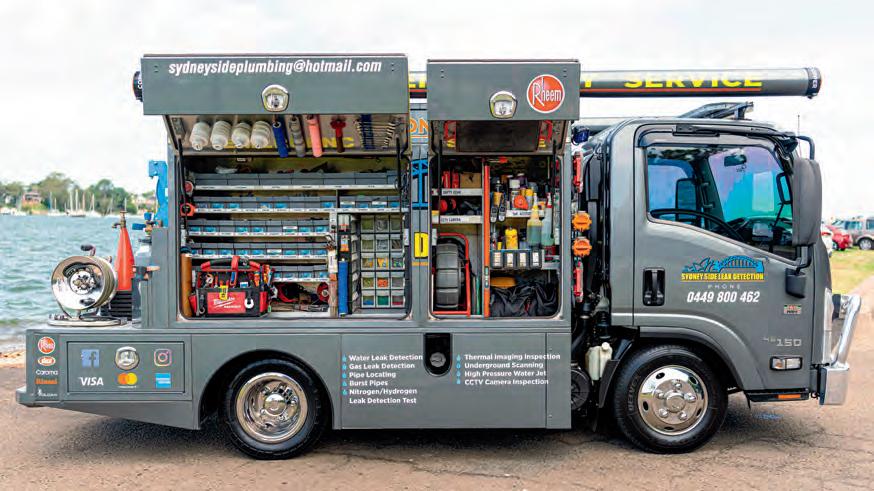
his team also won the ‘King of the N Series’ prize, taking home two gongs.
He says it’s accolades like this and the constant service his truck receives that makes Isuzu an appropriate choice for his unique plumbing needs.
“The trucks have always been outstanding, and I make sure they get serviced very often,” he says.
“I’m very proud to have won the Truck of the Year honour for Sydney Side Plumbing. It’s brought a massive smile to our faces, and hopefully it allows us to continue doing the same for people who need leak protection.”
Mo and Sydney Side Plumbing weren’t the only ones who were recognised at the Isuzu Truck of the Year awards for 2024. In Kyneton, Victoria, Dean Lamb from Watts Fresh was crowned the King of the FX Series for last year.
Watts Fresh provides the regional Victorian town


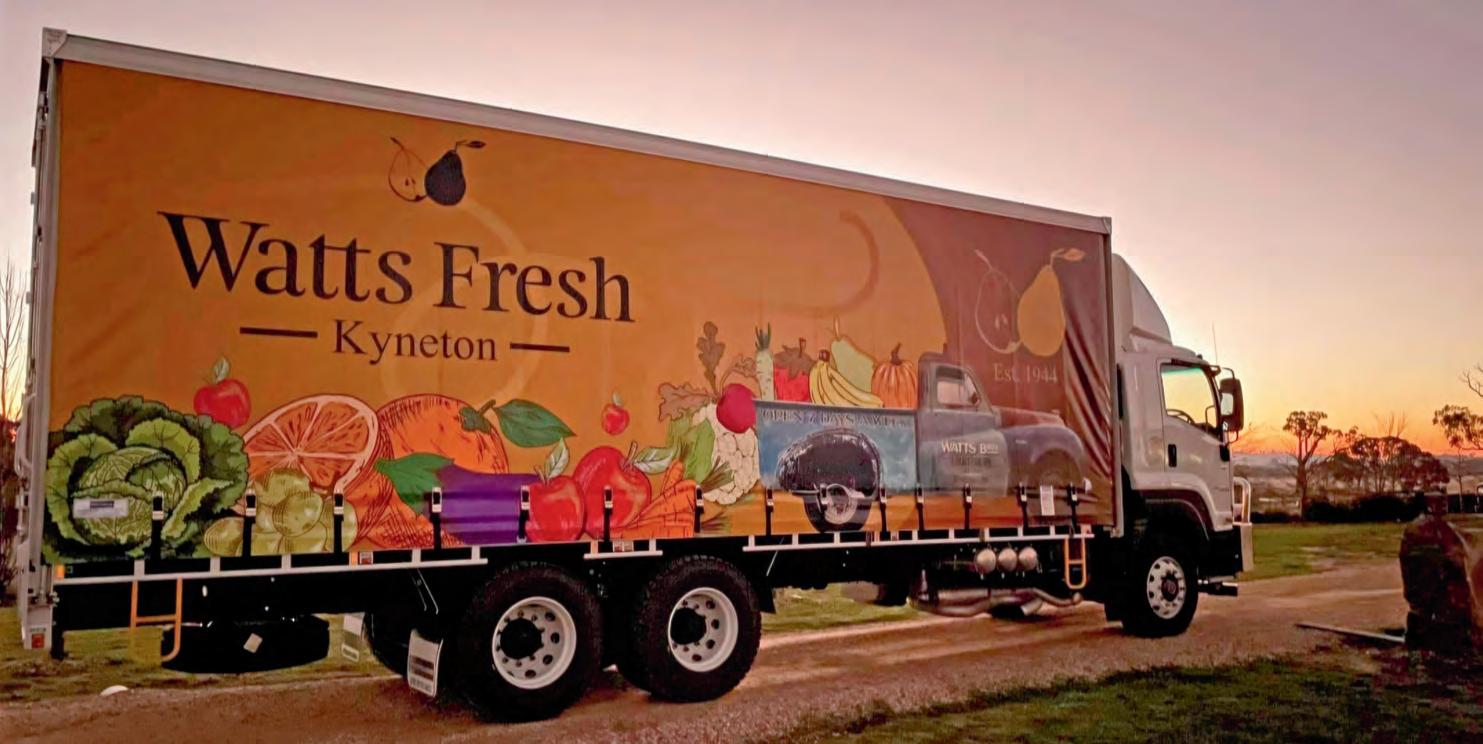

“It’s a brand new truck that I’ve been driving since the business collected it. I decided to enter it in the Isuzu Truck of the Year competition because it’s a unique fresh build that not many may have out there.”
with local deli goods, health foods, fruit and vegetables, with its FXY 240-350 model becoming a key cog in its successful machine. The custommade heavy-duty transport truck has kept produce fresh with its special attachments.
“Our FXY 240-350 has a custom insulated side curtain and is the first brand new truck we’ve ever bought,” Dean told OwnerDriver
“My first ever truck was an old Dodger with a motor in it that I bought for around $700 and had dad paint for me to use with our first shop. This is the fifth fruit shop my wife and I have owned, and we’ve had it for about 11 years now.”
The decision to buy a new truck has paid dividends. The good old fashioned greengrocers have succeeded at various locations, with the Kyneton venture having been listed in the top 10 retail fruit and veg stores in Victoria in multiple years.
The couple know how to vendor fruit and veggies, but they didn’t always know the best options for trucks to help their business grow.
Dean recalls a few “horror stories” in days gone by where old trucks they used had holes in the floor, no brakes or wires that would catch fire. When he bought the new Isuzu, he realised the power of a good quality truck.
“We went the extra mile with this Isuzu model and included an insulated body on the back from
Prestige Truck Bodies to go with the insulated curtains,” he says.
“My daughter came up with the graphics for the curtains, and it all went smoothly. It means we have better quality produce even if we’re stuck in traffic, as the truck will help us hold a cool temperature.
“Initially I was going to buy a smaller version of the truck, but we decided to go for a larger size. When we come home the truck is nearly full, and we have some big hills on the way home that the truck tackles with ease.”
The larger model has also allowed Dean and his wife to train new staff to drive without much hassle. It’s this care for produce and service that allows Dean to call for Australians to celebrate their own independent greengrocers to ensure they remain a vital part of the community.
“We can do things better than the big supermarket players,” he says.
“The first rule I learnt at my very first shop was to buy good quality produce and value our customers – this truck helps us give customers great value and the best quality fruit and veg.”
In the FY competition, Daniel O’Brien and Brooks Lift and Shift took home the award for their FYJ 300-350 crane truck. Daniel has driven the truck for the past year since Brooks first bought it, with Daniel driving it interstate
between Adelaide and Melbourne, as well as to and from Geelong.
“My Isuzu is very versatile in what it is able to carry and lift,” Daniel told OwnerDriver
Daniel has been driving crane trucks for eight years at Brooks Lift and Shift after originally gaining experience in the mining maintenance sector. Since first hopping behind the wheel at age 17, he’s only driven Isuzu models.
The special part of Brooks Lift and Shift’s new FYJ 300-350 crane truck is its unique crane attached, with the fitting making it stand out as an eye-catching model.
“It’s got a decent sized crane on it for the size of the truck,” he says.
“It’s a brand new truck that I’ve been driving since the business collected it. I decided to enter it in the Isuzu Truck of the Year competition because it’s a unique fresh build that not many may have out there.”
The award is deserved recognition for Daniel and the team at Brooks Lift and Shift. When they first ordered the model and went through the build process, the company had a goal of making it look worthy of being a possible Truck of the Year winner. This included the group taking their time to ensure the truck came with all appropriate features so that there was no need to have to add more parts to it as time went on.

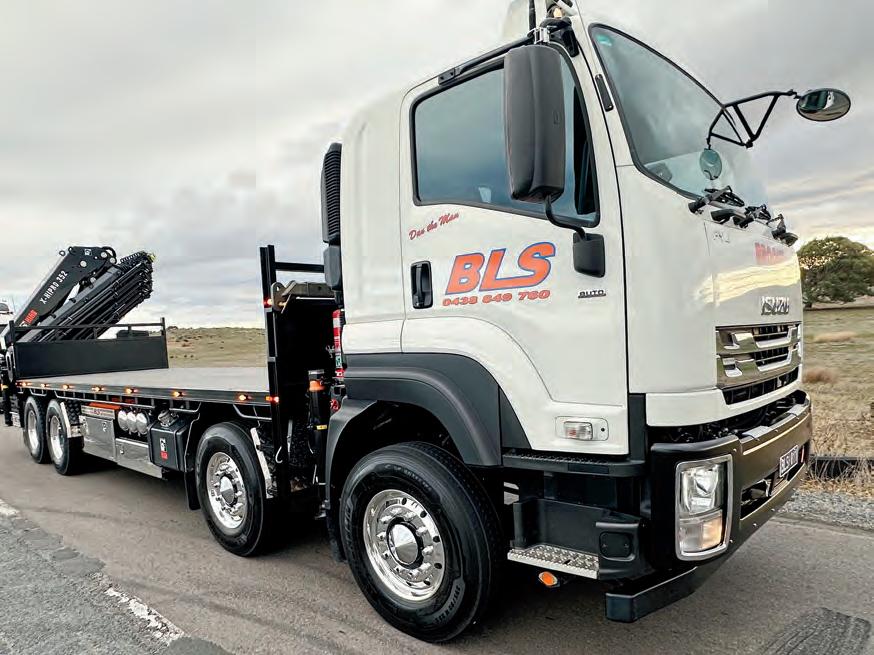
It all paid off when Daniel and the Brooks team were named in the latest round of Isuzu Truck of the Year winners for 2024.
“We were so chuffed when it was named a Truck of the Month, even more so when it was crowned the King of the FY Series,” he says.
“We were stunned by the news, but the truck has performed well and we’re happy to win the award.”
The final category was the F Series prize winner, with Jason Spiteri and Zozo’s Earthworx winning with a classic FRR 600. Operating out of Dean Park in New South Wales, the special truck follows similar themes to the other Isuzu winners for 2024.
“What makes our truck special to us is that the whole thing was custom built by myself in my backyard,” Jason says.
“I put a lot of hard work and labour into transforming it from the Pantech that it was when I first bought it.”
To find out when the 2025 competition opens head to www.isuzu.com.au for more information.

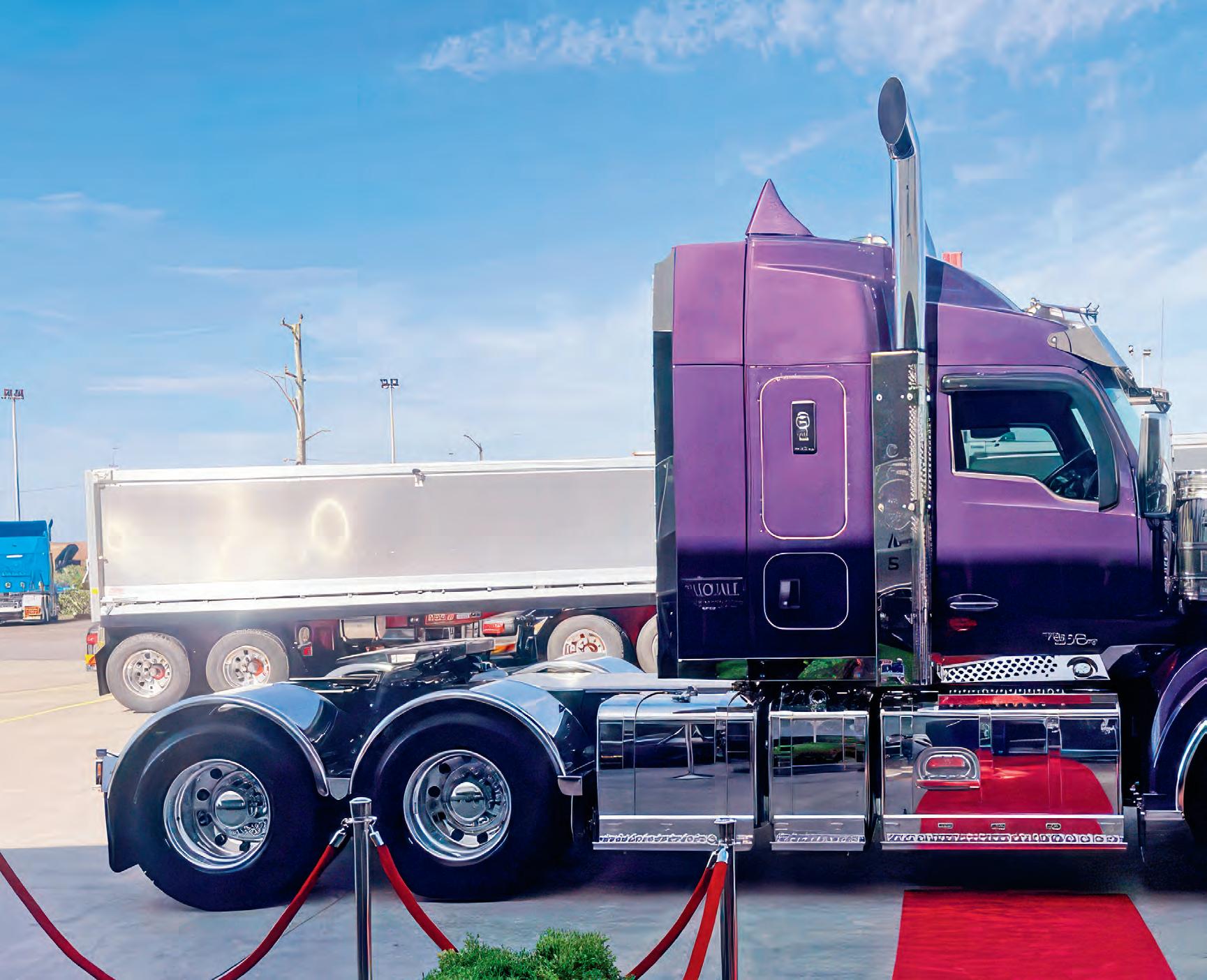
Just a year after the passing of his pop, Dave Attkins’ boss at Compas Transport gave him a unique new truck to honour the life of the popular trucking industry member


What is the best gift your boss has given you?
A Christmas bonus? An afternoon off? Some handy tips to improve your skills? For lucky truck driver Dave Attkins, his career was made when his boss bought a new truck and made some modifications to pay tribute to Dave’s late grandfather.
A couple of years ago, Dave’s boss Colin Pasquale at Compas Transport ordered a new truck, with the primary aim being to provide it to Dave to use on his daily runs. When tragedy struck Dave’s family, the plans for the truck soon changed.
“The truck was always coming, then, on December 29 in 2023, we lost my pop,” Dave told OwnerDriver.
“He had such a big influence on my life and my career – he was where it all began for me.”
Throughout 2023, Dave’s pop had been battling cancer, with his family giving their all to try and keep him as comfortable as possible in his final months. When word got through to Colin Pasquale that Dave and his family had lost pop, he did his best to grant them their wish.
“My uncle and myself both wanted to put pop on the back of a truck to carry him to his resting place,” Dave says.
“I spoke to Colin about it – at the time we were going to use his T900, pending its availability. While all of this was happening, Colin ended up buying me a T610 while we waited for the new SAR to be built.”
When the T610 arrived first, Colin moved to ensure the truck was ready for its special mission. It may not have been yet ready to go on the roads, but Colin soon had his workshop crew putting in long hours to get the truck on the road for Dave and his family, taking the turntable off and getting it ready for the day.
To commemorate Dave’s pop, Dave was able to drive a

day cab from the Compas Transport fleet while his father drove the operator’s Mack Trident in a procession. On Dave’s day cab were stickers that paid tribute to his grandfather. It proved to be a poignant moment for a family with a rich history in trucking.
“My pop began his driving career at the age of 17, where he drove for various companies over the years,” Dave says.
“Over the years he drove for Aztec Transport and BMG Transport before becoming an owner-driver on and off over the years.
“He had an extensive career with Lake Lines running from Lake Munmorah to western New South Wales and earned the nickname ‘Green Lizard’ when he first started driving. The Lake Lines owner one day bought pop a brand-new green Ford Louisville – from there he got the nickname from the guys at Lake Lines.”
At Late Lines, Barry Attkins (Dave’s pop) became a wellknown member of the trucking industry, driving W models and Western Stars and completing mainly fridge van work for Lake Lines’ subcontractor TNT Refrigerated. For many years, Barry would run all over the country, with Dave remembering his pop completing pig runs where he would collect pigs on farms and take them to meatworks and other locations.
“He spent a lot of time in the Hunter Valley on the coast with tippers,” Dave says.
“He worked right up until he got crook, completing parttime driving until he went out at 86. He gave up driving full-time at 78 but regretted it – if he hadn’t of done that he thought he would still be going strong.”
Described by Dave as a “gentleman of the highway”, the Attkins family paid tribute to Barry through a funeral procession of trucks that left from his house in Muswellbrook, NSW. Dave says he was a lover of the land, including farming and his cattle. As a kid, Dave would find any reason to be around him – he just wanted to be like his pop.
“I was always going to drive trucks, regardless of what pop said to me,” Dave says.
“He tried to talk me out of it as a kid. He said if he discovered that I was driving trucks then he would kick my ass, but then I got too big for him and he couldn’t.


“In the end, he was proud that I drove trucks, and told me so a few times when we would buy a truck. They were special times.”
The funeral saw around 150 people and 15 trucks take part in the special ceremony to honour Barry’s life. With a truckthemed coffin joining the procession, Dave relished being able to drive the old Mack Trident for the day. Soon enough, Dave was able to hop behind the wheel of an updated truck that had some special touches part of it to pay tribute to Barry.
As time went on and Dave was invited to chat with Colin more about the new truck that was incoming, Dave got involved in picking the colours and the right specs. When the truck was finally ready to pick up, Colin told Dave to head to dealer Gilbert & Roach in Newcastle to see it in person.
“The team at Gilbert & Roach presented the SAR to my wife and I,” Dave says.
“Unbeknownst to me, Colin and his wife Marisa had gone and built the truck in honour of my pop without me knowing, putting his initials on the Kenworth badge and his name on the back of the truck.”
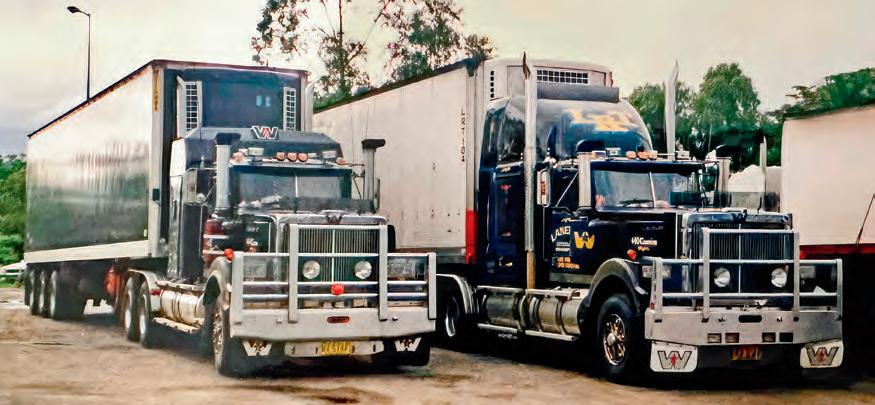
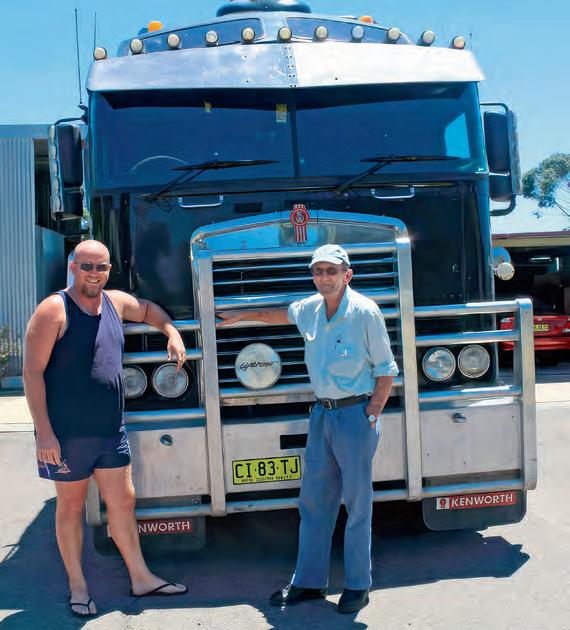
Dave will never forget the day he walked out of the Kenworth office at Gilbert & Roach and took in the new truck. Initially, Dave was simply impressed by the shiny new SAR that stood before him. When Colin turned up and told him to walk around the beast, he soon saw the special touches involved.
“I walked around the front of the truck and saw pop’s initials on the badge – that got me,” Dave says.
“We then moved onto the passenger side and headed around the back, where we saw the line ‘in loving memory of Barry Keith Attkins’ written on it – that blew us away.
“A Pegasus was also added to the Kenworth logo to commemorate pop’s love for animals.”
Although it was a surprise, this touching gesture wasn’t out of the ordinary for Colin and Marisa Pasquale. The couple first founded Compas Transport in 2002 and have quickly grown it to become one of the most respected and reliable privately-owned transport companies in NSW. By focusing on customer service and its people, Compas has allowed great staff like Dave to flourish and cherish working for the company.
“The new SAR has been unreal to drive – it looks wonderful and drives very well,” Dave says.
“It’s very comfortable and is getting better each day – it certainly turns some heads and I love it for that reason.”
The new SAR is Dave’s latest truck in a long history of hopping behind the wheel each day. At the age of 18, Dave followed in Barry’s footsteps and started driving rigid tip trucks around the Hunter Valley for an earthmoving company. He soon progressed onto working for a Queensland company, completing deliveries of beer and timber around time.
“I then got my trailer licence and started loading and unloading them interstate,” he says.
“I then got the opportunity to run linehaul from Brisbane to Maryborough and Bundaberg every day. I progressed to run more interstate routes for a few years before switching to some truck and dog work for various companies in the Hunter Valley again.”
Having been in and out of interstate and local work in recent years, Dave decided to work once again for Colin and the Compas Transport team around two and a half years ago. Since then, he’s been running between Sydney and Newcastle. Now, he’s doing so in the shiny new SAR that has a nice personal touch attached.
With Compas Transport celebrating more than two decades of operations, Dave is has nothing but praise for the Pasquales and how they’ve run the business since 2002.
“There’s a heap of new trucks coming to celebrate – mine just happens to be one of them that got turned into a special build,” Dave says.
“I can’t thank Colin and Marisa enough for everything they’ve done for my family and I, including the truck and the time off around the funeral.
“It was so special to be presented the new truck alongside my wife Nicole, who has been a big influence in my life. I’ll never forget that wonderful day.”
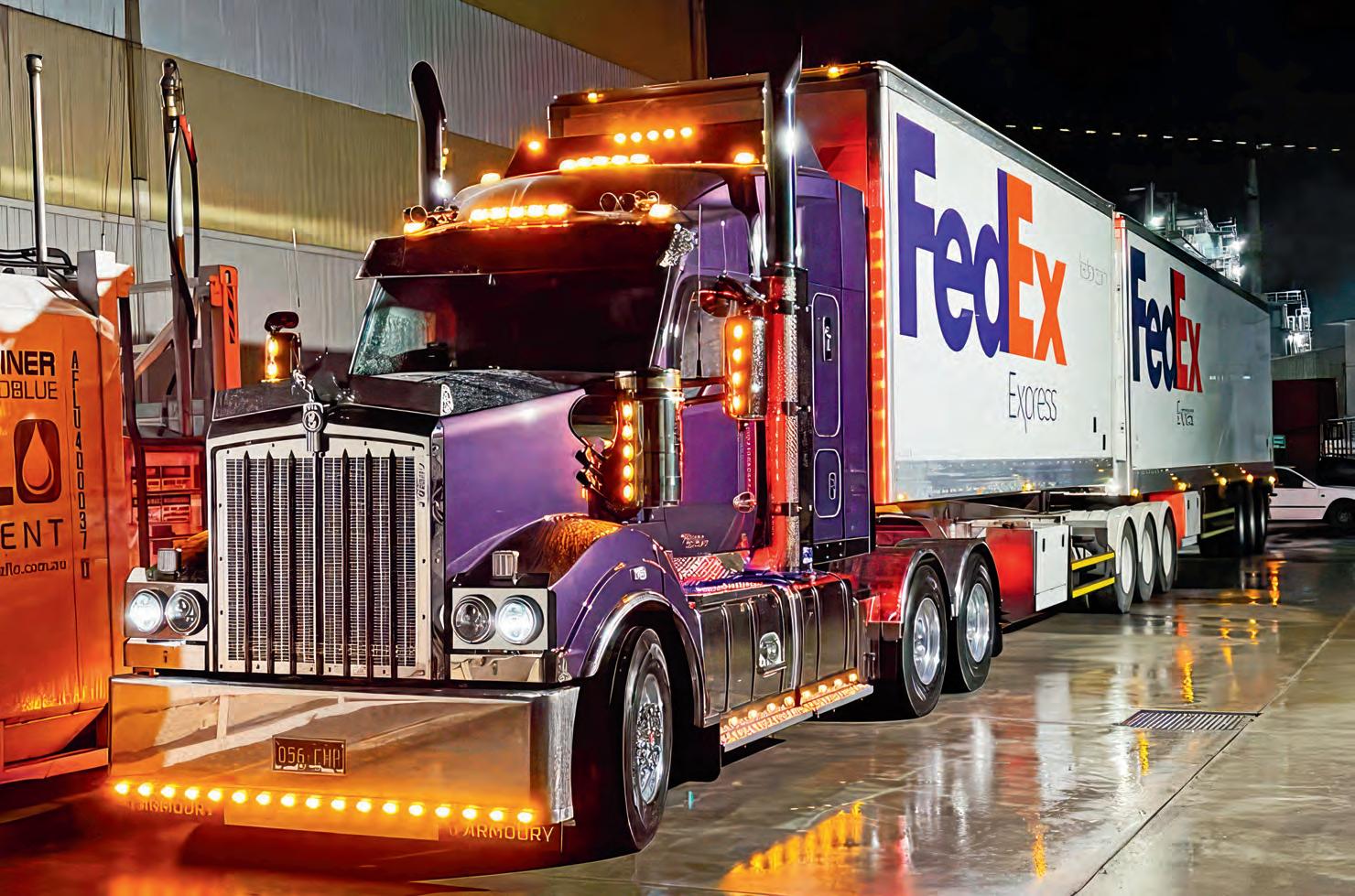


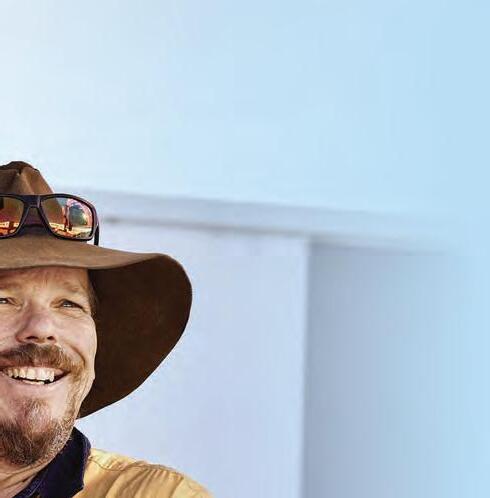
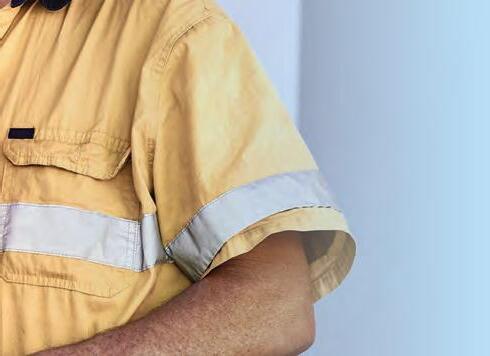

While in Belgium, Warren Aitken tracked down a fellow truck enthusiast friend in Nick Wright to learn more about his special Scania
Having done this story writing gig for a couple of years now, I have racked up more than a few interesting yarns, and over my years I have chased down stories for a multitude of reasons. Great people, interesting vocations, even just right time, right place.
Occasionally I get very superficial and chase down a story purely based on looks. I know the old adage ‘looks aren’t everything’ and, as a man unencumbered by the standards of beauty, I am a huge advocate of that saying, most of the time.
Today though, I am throwing it all out the window because I have gone all the way to Belgium to grab a story, based solely on looks. Yes, it sounds superficial, because it is. Well, at least it started out purely superficial. I saw the stunning Holridge Scanias, the colour scheme, the detailed artwork, the custom straps! They just looked one out of 10 and I knew I needed to photograph them. It was a huge bonus that the owner of these trucks, Nick Wright, also turned out to be an awesome, generous guy who’s love of trucks matched my own and who’s passion
for the Scania V8s and old school T-cab Scanias rivalled that of the hard-core Superliner and SAR fans here in Australia.
Thankfully Nick was more than happy to fill me in on his transport pedigree and shoot his immaculate trucks. Seeing as this is a UK based story, in this write-up I am going to try and adhere to the correct colloquial dialect. Forget the term ‘truck’ – for this story we’ll be going all ‘pommy’ and using the term lorry. However you refer to it, the Holridge Scanias are stunning looking trucks and well worth a European journey.
First things first, I’ll ease up on the dramatic licence a little. I didn’t go all the way to Belgium purely for these trucks. I did happen to time my European holiday with a time when Nick Wright would be in the country with a couple of his stunning fleet. It just sounds cooler if I proclaim I travelled nearly 30 hours just for a story. The origins of this story go back to 2023 when I first met T-cab enthusiast Nick Wright.
I was indulging in my maiden journey to the incredible TruckStar festival. Surrounded by a


couple of thousand outstanding lorries, it was Nick’s S660 Scania that first drew me in. Nick was at Truckstar debuting his beautifully restored T-cab Scania and was flat out networking with the thousands of fans that were snapping pictures and firing questions at him. The crowds around the T-cab meant that I was bucking the trend and getting all smitten with his cabover while Nick was fawning over the truck he had spent seven years rebuilding and a lifetime yearning for.
Although our adoration was focused on different vehicles, our dual appreciation for the big Swedish icons was very much aligned. During a little break in Nick’s fandom, I managed to grab his attention and find enough time to introduce myself and get to meet the man that would become a very good friend. I expressed my appreciation for his stunning looking lorries and we agreed that the next time I was over his way we would sit down and he could tell me all about his T-cab obsession, his love of all things Scania and how it feels driving a right hand drive lorry in a left hand drive world.
Roll on 2024 and I was heading back to Europe for another truck show. I reached out to Nick and we agreed to catch up. On a dreary overcast day, I found my way out to the tile factory in Belgium that is a second home to the Holridge trucks and caught up with the little Englishman with a big appetite for Scania and a massive love of lorries.
“I’ve been a lorry driver since before I was old

enough to drive them,” Nick says with a laugh.
“You had to be 21 to get your class one back then and I started working for a guy when I was 20.”
That eagerness stems from a childhood growing up around trucks and spending as much time as possible around them. Nick recalls a lot of his teenage years were spent in the passenger seat of one of his mother’s mate’s lorries.
“I remember going with mum’s mate Bill – he was a bit rough around the edges but had a heart of gold,” he says.
“He had an old school DAF, an old 3300 and some old 2028 Mercs, but Nick’s favourite one he drove was a flat roof F12. The lorry was a mess – I used to polish the dash. Back then, in the late ‘80s, it was a lot of running on red diesel, a bit of a bent kind of thing, if you know what I mean.
“Bill would work round the clock and I loved it, I’d have to keep asking him at night if he’s ok as he was starting to drift off. I never needed any money, Bill would give me food and cigarettes, all sorts.”
Now I understand I probably shouldn’t be quoting the supply of cigarettes to minors in my story, however it is England, and it really paints a picture of the era that Nick grew up in. It’s also worth noting the relationship with Bill that started Nick’s love of lorries would see Nick attend three of Bill’s weddings, one as the best man and the third marriage being to Nick’s mum.
From those early days, Nick developed the work ethic that in 2011 would see him and his wife Louise finally get the opportunity to start their own company.
“Louise and I started the company in 2011. It was an ambition
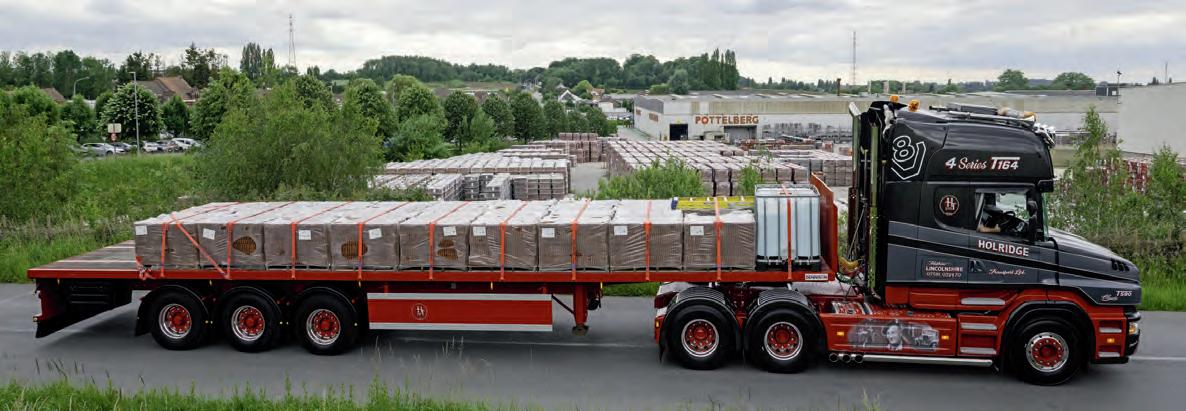



I’d wanted to do all my life and, at 37, we decided to give it a go,” he says.
“I sold my house and bought a 480, straight six-cylinder Scania. It had the old paper Tacko and I worked that around the clock. I knew I couldn’t afford to fail so I just worked.”
Those teenage experiences paid dividends as Nick got his company established and, after about 18 months, found his workload expanding with a need for a second truck in the Holridge fleet. This time it was to be a 105 DAF.
“I really wanted a V8 Scania right from the start but I just couldn’t afford one. I knew I had to work a bit more before I could afford one of them,” he says.
That Scania V8 dream would eventually come true. With Nick’s work ethos ensuring that he was never short of a load, it meant that it only took a couple of years before his goal was achieved.
“A guy from our local Scania dealer rang me up and said he had a lorry that was right up my ally,” he says.
“He knew I wanted a V8. It was from a one-owner operator for a lot of years and the guy had just passed away. It was a 164,
16-litre 480. I paid 14 grand for it and ran that truck for eight years; it was the hardest working lorry I’ve had, and I sold it for 24 grand a couple of years ago.”
That first injection of V8 power only drove Nick onwards, leading to several more V8s until he ended up with the S660 he has now. It’s my personal favourite, as you can see by the number of photos I took of it. He also has a stunning R730 and an old school R620, still working hard throughout England.
The majority of Nick’s work revolves around the cartage of tiles. I caught up with Nick over in Belgium where he often picks up the tiles to distribute around the UK. It is a complicated but efficient system Nick has set up. He leaves from his home in Lincoln and takes a load of tiles south to deliver before going further south to Folkstone where he drives his lorry onto the train. Yes, that’s right, he drives the lorry and trailer onto a train that shoots 24 miles underneath the English Channel and pops out in France. From there, it’s a bit over an hour to Belgium where he loads Belgium-made English roof tiles. If you look at the big picture, he travels over three countries in a little under three hours.
Back to the tile tale. While Nick is making his way over to load the tiles, he will also have a couple of his other trailers crossing the North Sea via ferry and getting dumped at a port only an hour away from the tile factory in Belgium. This means Nick can drop his loaded trailer, pick up the empties and head back and get up to six trailers loaded and returned to England over the course of a couple of days. While he is loading and returning trailers via the ferry, his local trucks are busy delivering the loads that Nick has already sent back.
It is a pretty smooth operation and one that has allowed Nick to keep food on the table and follow his passion for Scania trucks. This leads us to the other stunning Scania featured in the photos in the T-cab Scania.
“I have always loved T-cabs – something about the 16-litre 4 Series T-cabs I just loved. I’d never drove one but always loved them,” he says.

“They’re probably second nature to you guys in Australia, having the nose, but I’d always loved them, even just the look of them. Some people love the 143s, I just always wanted a T164.”
In 2016, with the Holridge company’s reputation ensuring his trucks were being kept busy and with the blessing and support of his amazing wife Louise, Nick finally indulged his final Scania fantasy by getting his own T-cab.
“Of course, I wanted a V8 but couldn’t find one, but I eventually found a six cylinder one,” he says.
“It was a 2003, six-cylinder 470 T-cab. The six cylinder wasn’t bad, but it was nowhere near good, so I bought an Irish motor and a four-series V8 and we got the entire engine as well as the wiring looms.
“We just completely replaced the old 6 cylinder 470.”
As we start to unravel the extent and effort put into this stunning T-cab, there are two things to keep in mind. Nick will attest to the fact that nearly 80 per cent of the original lorry ended up in the bin and that if the work wasn’t done by Nick himself, then you can bet anything that his head was on the left shoulder of whoever was undertaking the job.
The whole engine got rebuilt – pistons, liners, oil and water pumps. All main and bottom end bearings, you name it, it got replaced or refurbed, even down to the window wiper motor. A whole new bonnet was sourced, all the airlines, hoses and

wiring were replaced. It became a whole new truck. Inside got exactly the same treatment, with new Scania dash and panels while the floor walls and seats were all reupholstered. It was starting to sound like the 20 per cent he held onto was merely the chassis rails. The end result was a transformation from a tired old T124 Euro 3 470 into a state-of-the-art T164 580 6X2 twin wheel tag bull nose.
With the interior revamped, the powerline souped up and the truck as good as new, the only thing left was the aesthetic dilemma. Thankfully, Nick opted

to paint the truck in the company colour that work exquisitely on his S660 and R730, deviating only with the addition of some personal artwork.
“I grew up with my grandma and grandpa. I spent a lot of time with them and wanted to honour them on this truck,” he says.
“I’ve called it Lady Annie as that was my grandma and the photos on the side are of my grandpa.”
I should add that the Holridge name is actually an amalgamation of his grandparent’s names, Annie Holgate and Ernest Ridgill. The more I learnt about Nick during our catch-up, it was obvious that this seven-year project was a complete labour of love for a man that has an immense passion for his trucks and his family.
Nick is also happy to admit that, as well as him having the drive for such a project, he wouldn’t have achieved it without his lovely wife Louise, who has also spent more than any wife’s allotted time behind the tools and polishing clothes. As well as his son Thomas, who has become quite the YouTube star with his T-cab Thomas channel called Holridge_Tom, his support features a lot of the progress story behind this truck.
Although this was meant to be a short feature, it is hard to cull back a story when you sit down with someone with as much passion as Nick. It is also heartwarming to realise that trucking passion is a universal affliction, whether it’s Kenworths or Scanias, bonnets or cabovers. We all suffer the same, normally with a loaded garage, an empty wallet and a stack of photos.


Cure


Cancer’s national fundraising campaign is encouraging the Australian community to turn their next BBQ into a BarbeCURE® – an opportunity to raise money for cancer research
This summer, Cure Cancer is inviting people around Australia to make their next BBQ something more impactful. The way to do so is simple – gather your friends, family and community, fire up the grill and ask your guests to donate to a worthy cause.
Whether it’s in your backyard or at the beach or a local park, your BarbeCURE® can be more than just a chance to enjoy good food and great company. It can also help raise funds for life-saving cancer research.
The funds raised go towards supporting scientists working across all cancer types, funding cutting-edge research that improves treatments and outcomes for patients.
One research supported by this fundraising is Dr Ben Wylie, who focuses on childhood sarcoma. Based at The Kids Research Institute Australia in Perth, Dr Wylie and his team have developed an
innovative immunotherapy gel. This gel, crafted from natural materials found in the body, targets surgical areas to activate the patient’s immune system, helping to eliminate any remaining cancer cells. For children facing aggressive cancers like sarcoma, this research offers renewed hope for safer, more effective treatments and a brighter future.
“Most new cancer treatments are developed for adults and then adapted for childhood cancers, but children are not little adults,” he says.
“Support for childhood cancer research is vital to develop better treatments for cancers like sarcoma and improve outcomes for children and their families.
“This project funded by Cure Cancer will enable me to conduct cutting-edge research with the potential to create more effective treatments with fewer side effects.”
For this year’s BarbeCURE®, Cure Cancer is aiming

to raise $200,000 to fund two years of groundbreaking cancer research that accelerates breakthroughs, saves lives and brings Australia closer to a future where cancer is no longer a threat.
Currently, cancer continues to take a devastating toll, claiming nearly 10 million lives every year and affecting millions more. The only way to change this is through research. Since its inception, Cure Cancer’s BarbeCURE® campaign has raised over $1.5 million, directly supporting emerging cancer researchers who are improving cancer care.
Hosting a BarbeCURE® is both easy and rewarding. Start by planning your event – decide on a date, location and guest list. Whether it’s a casual weekend BBQ or a New Year’s gathering, any event can become a BarbeCURE®
Then, register the event at barbecure.com.au and invite your guests to join, then use social media to spread the word by tagging @curecancerau and using the hashtag #barbecure.
The next step is to fire up the grill, enjoy the food and day and encourage guests to make a donation. From there, celebrate and reflect by sharing photos and updates that allow guests to know the difference they’ve made by supporting cancer research.
Cure Cancer’s BarbeCURE® ambassadors (delete in) Manu Feildel, Gary Mehigan and Anna Polyviou have some great recipe ideas for your BarbeCUREs, from Manu’s chargrilled pork cutlet to Gary’s charred green vegetables and Anna’s peach melba pavlova smash.
Since its launch, BarbeCURE® has proven that even small gatherings can have a big impact. Together, we can raise the $200,000 needed to support two years of pioneering research, giving hope to patients and families everywhere.
So, why not turn your next barbecue into a BarbeCURE®? Register today, and let’s grill for good! Register at: barbecure.com.au
TOP: BarbeCURE® ambassadors Manu Feildel, Anna Polyviou and Gary Mehigan
LEFT: Host a barbecue at your place this summer, sign on to raise money for cancer research and capture the fun for the socials to encourage others to join the cause and help BarbeCURE® to reach its $200,000 fundraising target




moments line February
Simon Smith
Plenty of famous birthdays line this month’s edition of Australian rock music history dates. Unfortunately, tragedy is also part of it, with multiple deaths, including that of former AC/DC frontman Bon Scott, part of February’s folklore.
Here are some key milestones, birthdays, and anniversaries in Australian rock ‘n’ roll history for the month of February, from the Australian Truck Radio Rock ‘n’ Roll Diary:
FEBRUARY 2
2006: Drummer Geoff ‘Drainpipe’ Plummer passed away on this day. Known as the drummer and a vocalist for band Ol ’55, he also was part of The Fives throughout the ‘80s.
FEBRUARY 4
1975: Not quite rock music, but Australian singer Natalie Imbruglia was born on this day. Well known for hit single ‘Torn’, she’s popular for her singer-songwriter career, as well as for being an actress.
FEBRUARY 10
1944: We’re taking it back a bit to the day Paul Allen was born. The Australian singer-songwriter, musician and entertainer was renowned for his flashy performances and vivid costumes, with songs like ‘Go to Rio’ still being staples today.
FEBRUARY 14
1960: On this day, Frank Seckold was born. A keyboardist who also provided vocals, guitar and other instrumentals for 14 bands, Seckold was members of bands such as Mad Gorilla, Freeway, The Beatnix and The Generation.
2007: 47 years after Seckold’s birth was a sad day in Aussie music history, as country music legend Smoky Dawson passed away. With a career lasting more than six decades, Dawson passed away almost 95 as an icon after a glittering life of country rock music and entertainment.
FEBRUARY 15
2012: Another sad day in music history as English-born Australian guitarist and songwriter Clive Shakespeare passed away from cancer at age 62. Known as a co-founder of pop rock
group Sherbet, he was part of the band’s success in the ‘70s through hit singles such as ‘Summer Love’.
FEBRUARY 17
2010: Ruby Hunter, also known as Aunty Ruby, passed on this day. The Indigenous Australian singer, songwriter and guitarist had a stellar career, with Hunter also being the life and musical partner of the wellknown Archie Roach.
FEBRUARY 18
1953: Back to another date of birth, with English-born Australian drummer Derek Pellicci born on this day. He’s best known as a founding member of Little River Band, and now lives in Melbourne with his family after a successful career.
FEBRUARY 19
1980: One of Australian music’s most sorrowful days as former AC/DC lead vocalist and lyricist Bon Scott passed
SIMON SMITH is the manager and producer of Australian Truck Radio. He has been in the radio game for 44 years and has been customising playlists for truckies for at least 20 of those. For great tunes 24 hours a day, 7 days a week, download the digital app for your phone at www. australiantruckradio. com.au
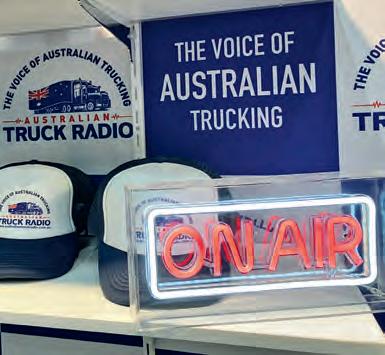
away. From the formation of AC/DC in 1974 until his death he was at the head of one of the world’s biggest hard rock bands, being named by Classic Rock in 2004 as the leading greatest frontman of all time. He was also previously part of Fraternity and The Valentines.
FEBRUARY 28
1952: We’re back to Sherbet again. This time, Australian drummer Alan Sandow was born in Adelaide. Now aged 72, Sandow was a key member of the massively popular rock band.
2007: A final bleak day in Australian music history as Billy Thorpe passed aged 60 on this day. The English-born Australian singer-songwriter was lead singer of his band Billy Thorpe & the Aztecs, which rose to prominence in the ‘60s.
There were plenty of tragedies occurring in February when traversing through Australian rock music history, but there are also plenty of great members who were born this month. Check back in next month for another edition of Australian rock music history.
“From the formation of AC/DC in 1974 until his death he was at the head of one of the world’s biggest hard rock bands, being named by Classic Rock in 2004 as the leading greatest frontman of all time.”


Gordo Mackinlay urges industry members to do anything they can to make the industry a better place in 2025

As I sit here writing the column you are now reading, it is less than a week from Christmas, a time when our industry is pushed to deliver the excessive amount of freight that needs to be shifted in the lead up to the festive season.
Our drivers are putting up with the ‘Over Population Situation,’ most likely struggling to get a park as the caravans are pulled out of the shed for the annual test of wheel bearing resilience, and the tyre lottery that goes with it begins!
Most of us have suffered the
frustration of not being able to get a park in our usual spots, and all the other ‘fun’ of sharing the road with non-professional drivers, but now on a mass scale.
But are we professional drivers? Well yes, by definition we drive for a profession – whether you spend six days a week in the truck, or like me now just fill in a few times a year to scratch the itch, and ‘keep my hand in’, we are paid to exercise our profession, so I say yes, we are by definition ‘Professional Drivers’.
While many of you reading this have been driving as long as some of us have been alive and were lucky
enough to do your ‘apprenticeship’ from a young age, corporate Australia has now robbed our industry of this. Unless you have turned up in fluro, long sleeved, long panted, correctly coloured hard hatted (yes, we have a board member that was not allowed to unload as he did not have a watermelon coloured hard hat) and are triply inducted into the micromanagement hall of shame, oh and of course without anyone else accompanying you, you may not load/ unload the vehicle. The minor matter of if you can operate it or not is sadly irrelevant. Corporate Australia not only currently do not support proper training of our workforce, they actually rule it out completely.

GORDO MACKINLAY is a former president and current board member of the National Road Freighters Association. To contact the NRFA see the website at www.nrfa.com. au, email info@nrfa.com. au or phone 0493 564 467.
Just as many of us received our licence either well after we became ‘professional’ (albeit unlicenced) drivers, or by the local sergeant of police knowing we were already driving and ‘shortened’ the process a bit, the training that led to this situation was generally very good –this unofficial ‘apprenticeship.’
But by the time this has gone to print, we will be at the dawn of a new year, and as 2025 looms, we are witnessing a much needed and overdue change. No, you still cannot take young Johnny or Jenny into the DC, let’s not get ahead of the game now!
What I am referring to is the implementation of an apprenticeship scheme that will nurture and educate the new entries to our industry as apprentices. It will allow them to learn all facets of the job that most people take for granted, such as just steering a vehicle from point A to point B. They will learn everything needed to perform as a ‘professional.’
Just like a mechanic, builder or electrician who undergoes an apprenticeship and gains a level 3 trade certificate, so too our new apprenticed operators will end up with a trade certificate, a level 3 qualification no less.
In late December 2024, following much lobbying from various Industry representative groups, including the National Road Freighters Association, the ‘Heavy Vehicle Licencing and Employment Pathways working group’ has been formed to establish a process of change in the licencing of drivers and workers within the heavy vehicle industry.
To quote parts of a recent media release:
Recently, a group of transport association representatives met with Senator Glenn Sterle at Parliament House to establish a workforce action plan that will underwrite the implementation of a structured training regime and that will draw from existing models and deliver a higher quality of professional driver into the heavy vehicle road transport industry.
This meeting followed a highly successful Heavy Vehicle Road Transport Safety Round Table that was attended by 37 leading industry representatives from transport companies, company representatives
from key supply chains, the union movement and transport and industry associations.
Recent studies have revealed that Australia has over 26,000 driver job vacancies in the road transport industry today. The current state and federal based licencing system circumvents the ability of the industry to attract and employ long term drivers who are skilled from day one.
The federal government has agreed to Skill’s Australia Workforce plan 2024.
We now call on the government to implement the recommendations for an apprenticeship scheme in the transport and logistics industry.
The heavy vehicle road transport industry needs skilled, trained and safe drivers who see the employment pathway as one that will ensure a growing career and obvious returns. The current systemic block is in the institutionalised licencing system that has not listened to the road freight industry.
YOUR NRFA IS A PART OF THAT GROUP So where to now?
Well, the first thing is don’t go rubbishing this idea unless you have a better one and have successfully lobbied government to adapt it.
Next, call your local member and tell them you support anything that helps put our industry on the front foot and improves safety and our image. Remind them that if they want your vote next time around, they better support it too. Follow this up later. Have your family and friends do the same. You could also contact your local high school and ask them if they know about it, and plan how we can get some of the


young students interested in such a program and contact their member to push for their support. Get them to contact their local tech college and ask them if they know of it, and if not why. Follow up on this call.
Lastly, don’t be negative about this. Let’s really break this down. We are an industry of highly skilled professionals that carry out one of the toughest jobs in the world, away from home and family. We get ripped off as
be given incentives to offset the financial burden they currently heft themselves with when supplying a wage and equipment to train someone who may have very little skill to begin with.
Also, if we lift the industry skills medium, we as professionals will attract not only a better quality of operator, but the financial rewards that go with it.
As we start a new year I set you a challenge:
“As we start a new year I set you a challenge: put the talk into action and get behind the industry we all say we love.
Support these changes and the associations that fight for them.”
operators and drivers alike. On mass our value is not recognised – don’t even start me on how our holiday pay and super is paid by most companies.
This is finally some recognition that what we do requires lots of knowledge, skill and considerable time. It shows that we can both be recognised as educated professionals, and that any new or existing members will have the opportunity to be trained properly and also be recognised as professionals.
Let’s not forget the employers – they will

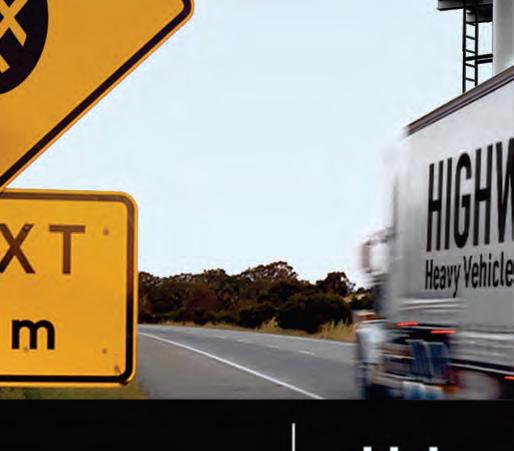
put the talk into action and get behind the industry we all say we love. Support these changes and the associations that fight for them.
Every time you go to whinge about something in our industry, stop yourself and do something positive to make it a better industry.
Finally, I wish everyone the best for 2025, keep it shiny side up, look after your health, family, friends and the rig you are making a living in. See you in 2025.
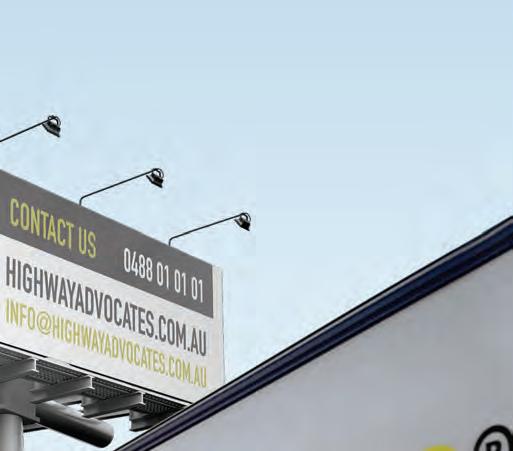

Healthy Heads is offering a range of free mental health training courses tailored specifically to workers in the transport, warehousing and logistics sectors

Do you love a freebie? Well, Healthy Heads in Trucks & Sheds (Healthy Heads) has got you covered! Our free mental health training courses are continuing in 2025. We’ll be offering seven different online training courses. Whether you’ve got 90 minutes or half a day, there’s a course that’ll work for you.
Mental health training is one of the most important things you can do, because it offers real value in a few key ways. First off, it helps raise awareness and gives you the knowledge to not just understand your mental health better, but the mental health of others too. It also breaks down the stigma that can sometimes be an issue in the industry and even clears up a lot of confusion about what mental health really means.
The training is run by experts including Lifeline Australia, Black Dog Institute, Steering Healthy Minds and AP Psychology & Consulting Services. You’ll cover a range of topics, from spotting psychosocial hazards to creating healthier workplaces and supporting your mates to learning how to have those important conversations. It’ll also show you how to help your team stay at work or get back on track after an illness, and most importantly, the need for self-care in our busy, often non-stop industry.
Another big reason to jump on this training is that it helps you reduce risks of mental health and safety problems. New legislation introduced in 2023 requires businesses to manage the risk of psychosocial hazards in the workplace. Plus, Work Health and Safety regulations say employers must provide health and safety training to their staff. The good news? You can learn to manage psychosocial hazards
and provide health and safety training for your team – all for free with Healthy Heads!
Mental health training is a great way to build a stronger, more supportive work culture. When everyone gets the right training, it creates an environment where people feel safe and supported – whether they’re on the road or in the shed. It helps break down the barriers that make it hard for people to speak up about their struggles, giving them the confidence to reach out before things get worse.
This kind of culture means employees can talk openly about their mental
Companies
health challenges, get the help they need and keep things from turning into bigger issues that could affect their work, safety or wellbeing.
With the industry facing a massive shortage of drivers and a rise in mental health claims, it’s clear we need to pay more attention to mental health and wellbeing. The good news is that training can make a real difference. It helps boost the overall health and productivity of the industry by giving everyone the tools they need to handle things like stress and to know how to look out for one another and recognise the signs that someone might be doing it tough. When we focus on psychological health and safety, we can create a stronger work culture where everyone feels safe doing their job, supported and valued and has the confidence to speak up before things get out of hand. Plus, it helps improve the image of the industry, making it more attractive to new drivers and keeping the ones that we’ve got. In the long run, this leads to better retention, less turnover and a happier, healthier and more productive workforce.
Clearly, training today can help shape a brighter tomorrow. By investing in your knowledge and skills now, you can enhance your capabilities to support others, improve your wellbeing and contribute to a healthier, more resilient future. To explore more about the wide range of courses offered, including course details, dates and the process to register your interest, simply visit the “Mental Health Training” section on the Healthy Heads in Trucks & Sheds website. You can also reach out directly to the team at info@ healthyheads.org.au for further assistance or to ask any questions you may have. Taking this step today can be a meaningful investment in both your personal and professional growth. Learn more with Healthy Heads in 2025.
“Mental health training is a great way to build a stronger, more supportive work culture.”


Sarah Marinovic is back with more insightful guides to how to remain compliant when it comes to your work diaries

As we all know, if you’re on standard hours, the obligation to fill in your work diary under the Heavy Vehicle National Law kicks in when you’re going to be doing work outside of the 100km radius from your base.
When doing entirely local work on standard hours, you don’t normally need to fill in the work diary, but this doesn’t mean that the work and rest hour laws no longer apply. Everyone working in fatigue regulated vehicles need to comply with the work and rest hour limits, even when working entirely inside their 100km radius. You are also required to keep your own detailed written records of your work and rest times and provide them to your record keeper, for example on a ‘daily run sheet’.
In a practical sense, not having a work diary to check roadside means it’s less common for the authorities to detect breaches of work and rest hours by local drivers. It’s easy to get complacent. However, a recent case my firm worked on is a cautionary tale for all of us on the importance of following the work and rest hours, even within the 100km radius.
Our client, an excellent driver who only worked locally, caught the attention of a particularly proactive police officer. This officer, using the broad investigative powers available to them under the HVNL, accessed our driver’s tachometer printouts, GPS tracking information, payslips and work schedules and then used those things to piece together their work and rest hours and charge them with a handful of fatigue offences.
“In a practical sense, not having a work diary to check roadside means it’s less common for the authorities to detect breaches of work and rest hours by local drivers. It’s easy to get complacent”
Because our client had a good traffic record and prepared for court well, we were able to achieve a result in court that kept them below the demerit point threshold and on the road. But it was a lesson well learned for all in the importance of always following the fatigue limits, and one I wanted to share.
The other thing I have seen recently that I wanted to raise with you is drivers who are opting to take their heavy vehicles and park them at home for the night between work days, as opposed to leaving them onsite or returning them to base. This can be convenient, but if you’re doing it, please bear in mind that the drive from home in the morning to your starting point and then back home again after your day’s work count towards your work hours.


SARAH MARINOVIC is a principal solicitor at Ainsley Law – a firm dedicated to traffic and heavy vehicle law. She has focused on this expertise for over a decade, having started her career prosecuting for the RMS, and then using that experience as a defence lawyer helping professional drivers and truck owners. For more information email Sarah at sarah@ainsleylaw. com.au or phone 0416 224 601

Now this is a bit odd, because if you did the exact same drives before and after work in your personal car, they wouldn’t be counted, even though arguably their impact on fatigue would be the same. But because the driving is in a fatigue regulated heavy vehicle, it counts. So if you’re doing this, it’s important to pay attention to the time these drives add to your work hours. I had a driver recently who was driving upwards of 1.5 hours on either side of the day to get home in their truck, and it pushed them over their standard 12 in 24, leading to charges.
If you have been charged with a fatigue offence or have questions about work and rest requirements as they relate to your business, the lawyers at Ainsley Law would be happy to help.

The truck sales data for the final month of 2024 saw many of the big players finish off another busy year with a bang
The Truck Industry Council’s (TIC) T-Mark truck sales data has been released for the final month of last year, with 3,250 heavy vehicles being sold to finish another busy year.
While December’s numbers didn’t rival the 3,345 trucks sold in November, it did bring the total truck sales for 2024 to just under 40,000.
Total trucks
In the total trucks market, there was simply no stopping Isuzu. A further 1,184 truck sales for December saw it surpass 13,000 total sales for
the year, with Hino a distant second in December with 426 sales made. From there, Kenworth (358) remained close behind Hino in the top three, with Fuso (323) and Volvo (220) also keeping competitive.
Iveco was the final brand to hit three figures in December with 176 sales, with Scania (95), MercedesBenz (82) and Mack (62) all not too far behind.
Renault (59), UD Trucks (55) and MAN (51) all finished in the 50s for the month, with DAF (32) and Volkswagen (32) keeping ahead of a tight pack to finish that included the likes of Hyundai, Freightliner, Dennis Eagle and Western Star.
Heavy duty
In the heavy duty market, Kenworth completed a comprehensive 2024 with a December rout, recording 358 sales for the month. The total market saw 1,381 sales made in the final month of the year, with Isuzu (220) and Volvo (211) finishing incredibly close on the podium.
From there, Scania was next best with 95 sales, with Hino (77), Mercedes-Benz (68) and Mack (62) all close. Fuso with 59 sales and Iveco with 54 both surpassed the half-century mark, while the same couldn’t be said for UD Trucks (49), MAN (46) and

DAF (41). The final sales belonged to Freightliner (16), Dennis Eagle (13) and Western Star (12) in a tight finish.
Medium duty
There were no surprises in the medium duty market as Isuzu capped off a superb 2024 with 345 sales in December. Out of a total of 706 medium duty trucks sold in Australia in December, Isuzu nearly snatched half of them, with Hino (215) also catching its fair share of the market. The competitors were far behind the top two, with Fuso (93) also extending its lead over the likes of Iveco (22) in December. From there, it was single figure sales for all other brands, including Volvo (nine), UD Trucks (six), Hyundai (five) and Mercedes-Benz (five).
Light duty
It was all about Isuzu again in the light duty segment, with 619 December sales ensuring the stellar brand captured more than half of the total 1,163 light duty truck sales made last month. Sitting well behind Isuzu in second place was Fuso with 171 sales, with Hino (134) and Iveco (100) also cracking the triple figure mark in the final month of 2024. Trailing the leaders was Renault with 59 sales and Volkswagen with 32, while Hyundai (14) and Ford (11) were the only other brands to surpass double digits in December.

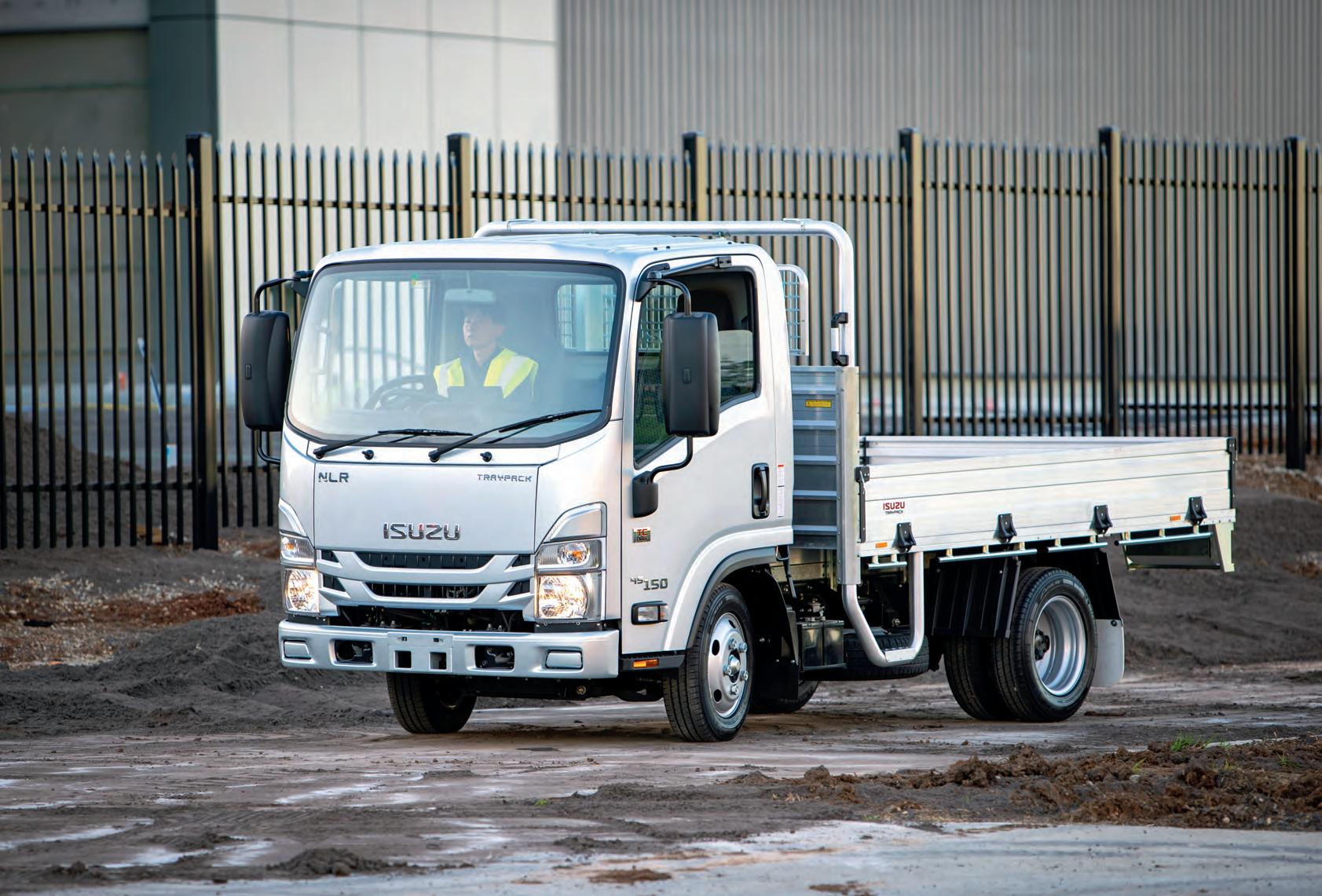
A couple of additions to truck sales reporting saw a new Australian record set for heavy vehicle sales in 2024
The Truck Industry Council (TIC) is celebrating a record breaking year for Australia’s heavy vehicle sales. The new all-time sales record was broken in 2024, with 51,277 units sold. In an increase of 3,520 units, or 7.4 per cent, compared to 2023, it’s the third straight year the new sales record has been set for heavy vehicle sales in Australia.
A key reason behind this historic number is the growth of the market in 2024, with TIC capturing two new truck and van brands in the LDV Deliver 9 and the Peugeot Boxer last year. While these two brands have been selling commercial vehicles above 3.5t GVM in Australia for a few years now, prior to 2024 they chose not to share their sales data.
TIC has captured all sales from January 2024 in the T-Mark sales results for these two brands and this has added 3,010 additional sales in 2024 for brands that were not captured in T-Mark in 2023.
The vast majority of these vehicles, 2,872, are vans, with a further 138 being light duty trucks. Without these additions, the record would still have been broken, except only by 510 vehicles, or 1.1 per cent.
“It was pleasing to see truck sales hold up well in 2024 and van sales strengthen to record levels,” TIC CEO Tony McMullan says.
“This despite challenging economic conditions throughout 2024 in Australia. It was equally pleasing to see a new annual new truck and van sales record that exceed the 50,000 mark for the first time ever.
“The 40,000 barrier was only broken relatively recently in 2018 and despite the protracted global COVID supply chain disruptions, heavy vehicle sales in Australia continue to set new records. The 2024 result of 51,277 sales has surpassed industry expectations, particularly given the above mentioned economic headwinds.
“While these record sales numbers in 2024 were set with the inclusion of a couple of van brands who had not previously shared their sales data with TIC, 2024 was a record year for heavy vehicle sales even if these brands were not included, with a tally of 48,267 bettering the previous record of 47,757 vehicles set in 2023.”
Overall, the year belonged to Isuzu, with the major brand more than doubling the next best to finish with 13,402 sales for the year. It finished comfortably ahead of the second placed Hino with 5,075 sales, while Fuso (3,827) beat out Kenworth (3,774) narrowly to claim third. Volvo wasn’t far behind with 3,193, opening a gap from a trio
of close finishers that included IVECO (1,891), Mercedes-Benz (1,759) and Scania (1,459). Mack (959) wasn’t far off surpassing 1,000 truck sales for 2024, while UD Trucks (896) and Fiat (822) both had strong years. DAF was the only other brand to pass 500 sales with 629, as MAN (420), Hyundai (359) and Renault (348) all remained consistent.
The next bracket of brands include Freightliner (266), Western Star (234), LDV (138), Ford (110) and Volkswagen (102), while Dennis Eagle (99), Foton Mobility (68) and SEA Electric (12) wrapped up the market for 2024.
In the heavy duty truck segment, 1,381 units for December 2024 was down compared to December 2023 results, as the market began to soften after a lofty year. Overall, the market recorded 17,152 sales for 2024.
Heavy duty trucks continue to make up the largest slice of the Australian heavy truck and van market, accounting for 33.4 per cent of all heavy vehicles sold in 2024. It remains comfortably ahead of the light duty truck segment, which is at second place with a share of 28.4 per cent in 2024.
The heavy duty sector belonged to Kenworth in 2024, with the brand amassing 3,774 sales for the
year to finish ahead of Volvo (3,115). Isuzu rose to claim a spot in the top three with 2,481 sales, while Scania (1,459) and Mercedes-Benz (1,076) also surpassed 1,000 sales for the year. Not far behind was Mack with 959 sales, with UD Trucks (803), Hino (795) and Fuso (736) all barely split. With the likes of DAF’s 595 sales capping off a productive year for the segment, there were plenty of positives.
The medium duty truck segment had slight growth over the course of 2024 when compared to 2023, despite December truck sales weakening. Following 706 sales in December, the decreased number still allowed the sector to have a major year of sales. In total, 8,132 medium duty trucks were sold in 2024.
The total number of 8,132 medium truck sales in 2024 eclipsed the 2023 mark by 128 trucks, or 1.6 per cent. While up on 2023 and 2022 sales, it still couldn’t surpass 2007’s peak of 9,923 medium duty truck deliveries.
In 2024, medium duty truck sales accounted for just 15.9 per cent of new heavy vehicles sold in Australia, almost half of the MD segment’s peak of 30.9 per cent set in 2001.
There were no surprises that Isuzu was the runaway winner last year, finishing on 4,116 sales. Hino was a comfortable second with 2,371 sales, with Fuso (1,027) making up the podium. A major gap opened up, with IVECO finishing fourth with 149 sales and Hyundai coming in fifth with 137. These were the only five brands to reach more than triple figures in annual sales as the remaining seven brands all contributed in a consistent year.
The light duty segment had slowing sales in 2024 after coming off record sales in 2022 and near record sales in 2023. Falling by 10 per cent, or 1,608 trucks, compared to 2023, 14,558 light duty trucks were delivered in 2024.
Overall, the light duty truck segment accounted for 28.4 per cent of all heavy vehicle sales in the past year.
Isuzu was once again at the top of the table in this market, finishing with 6,805 sales for 2024. It was comfortably more than double ahead of the next best, which went to Fuso and its 2,064 sales. Hino narrowly trailed Fuso with 1,909 sales, while IVECO was the next best with 1,353. From there, Fiat (822) and Mercedes-Benz (617) both recorded productive
coming from LDV and Peugeot. Without these additions, the segment still had 8,563 sales in 2024, up 42.3 per cent or 2,545 vans from 2023.
In December, 926 vans saw the segment finish the year with momentum, with vans making up 22.3 per cent of the Australia’s new heavy vehicle market in 2024 as part of a new record.
Mercedes-Benz maintained its leading position in the market with 3,327 sales for the year, with
“Despite these record new truck sales, TIC expresses concern that the average age of Australia’s truck fleet is much older than that of Europe and North America.”
years in the segment, with the remaining six brands all ensuring the light duty market continued to produce.
The light duty van segment was impacted by LDV and Peugeot’s sales being included for the first time in 2024. The two brands, mainly directed by LDV, accounted for 25.1 per cent of the increased sales in the van segment for 2024.
The van segment is still rebounding from the poor sales results seen during and after COVID, with 11,435 vans above 3.5t GVM being sold in Australia in 2024. This is a 90 per cent, or 5,417 vehicle increase from 2023, with 25.1 per cent of these
newcomer LDV not far behind on 2,837. Renault (1,810) and Ford (1,563) both rounded out the top four, with Volkswagen (712), Fiat (685) and IVECO (466) all finishing ahead of Peugeot (35).
Despite these record new truck sales, TIC expresses concern that the average age of Australia’s truck fleet is much older than that of Europe and North America.
“An old truck fleet is not conducive to improved safety, public health and environmental outcomes for our society,” McMullan says.
“Moving into an election year in 2025, we must consider what more can be done by both industry and particularly government, to reduce the age of our nation’s truck fleet.”
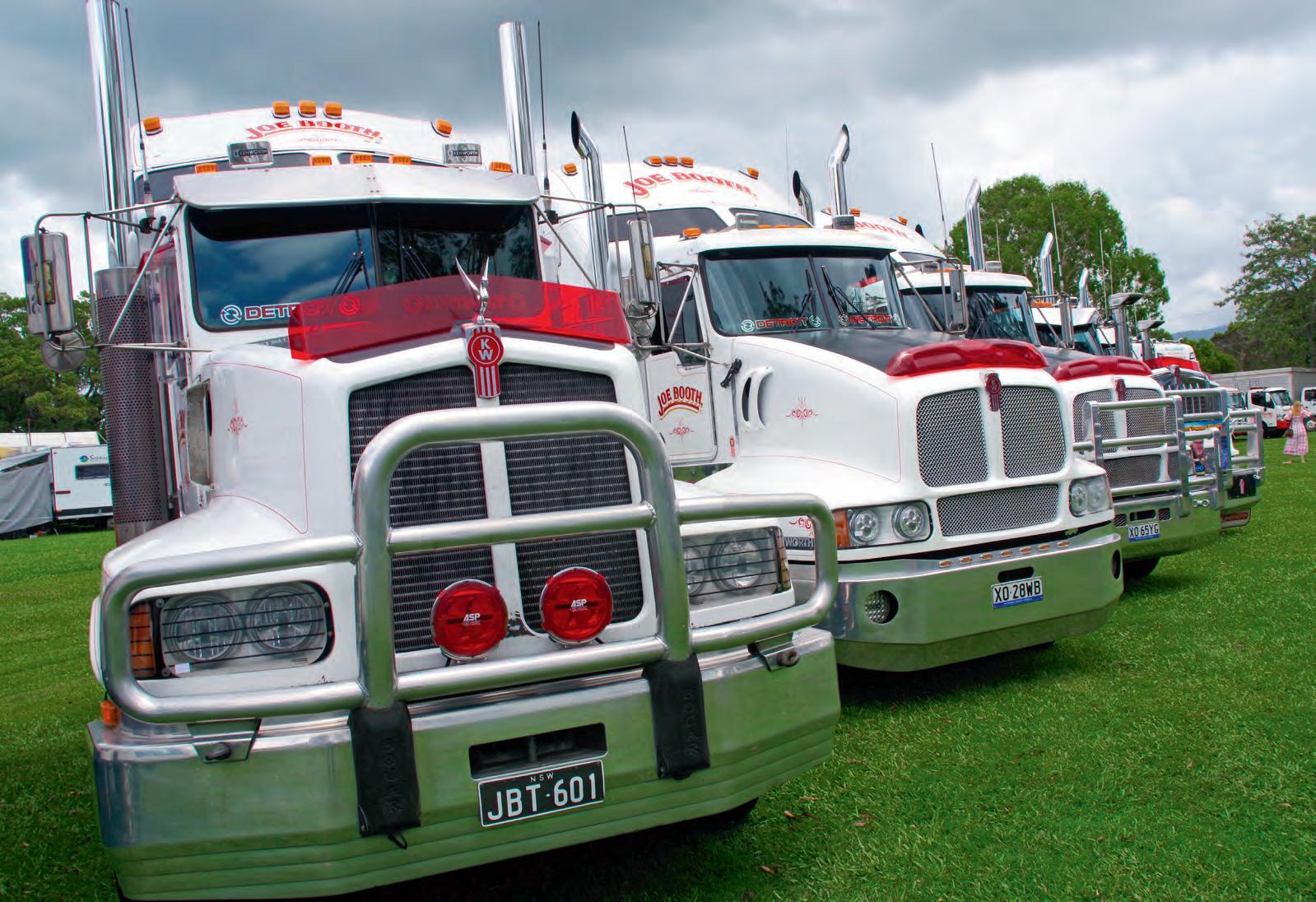


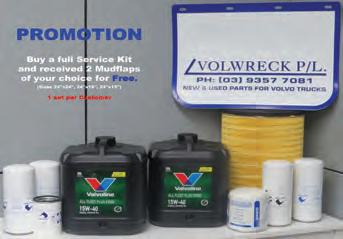
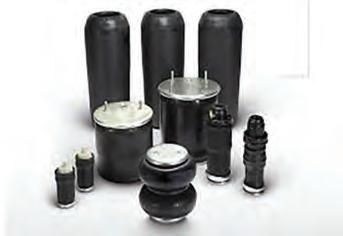
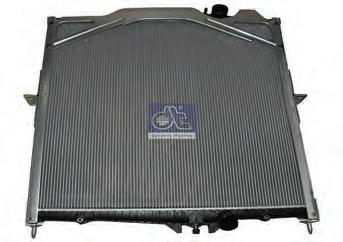
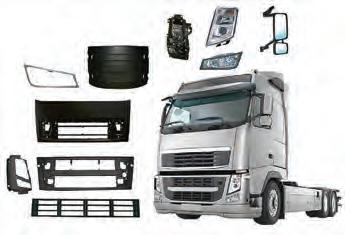
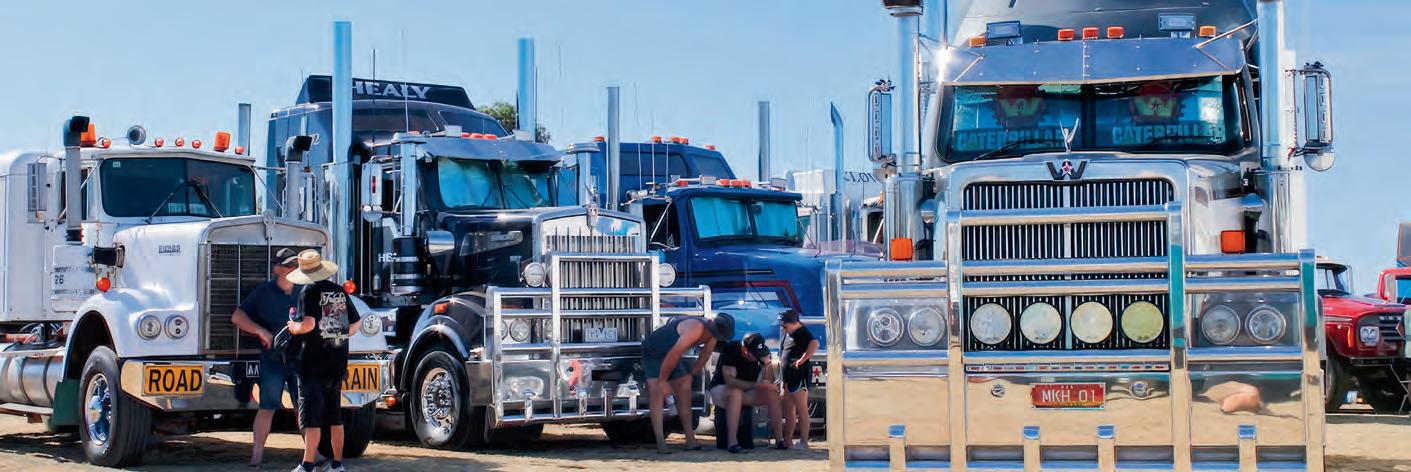
February 22, 2025
Head over to Angaston in South Australia for the Angaston Truck Show & Shine in late February. Held on Saturday February 22 in conjunction with the Angaston Show, the space welcomes trucks of all ages, conditions and uses from all areas, both locally and from far afield. Keep an eye out for more details to follow.
February 23, 2025
The Convoy Geelong Family Festival is a free event packed with entertainment and experiences catering for kids and adults alike. Pack yourself up and head to Victoria’s Beckley Park for a range of food vans, rides, face painting, roaming entertainment, live music, a fundraising awards ceremony and, of course, the opportunity to cheer on the returning convoy and check out all the trucks and vehicles at the show’n’shine. Everyone is welcome for a great afternoon of activities, while showing support for kids facing cancer.

March 1, 2025
Road transport history, both past and present, will be celebrated at the annual Lockhart Truck Show. The event features historic and modern trucks and other vehicles such as motorbikes, and classic and vintage cars, on display in the pavilion. There will also be food and prizes for winners in a wide range of categories. Camping i s available overnight for a donation and includes a Sunday morning breakfast.
March 9, 2025
The annual Clunes Historic Vehicle Show, brought to you by the Historic Commercial Vehicle Club of Australia’s Ballarat branch, will see trucks descend on Clunes. The event has something for everyone, with a vast array of vintage and classic vehicles and motoring memorabilia. Expect food vans, photos and working displays with likeminded people displaying their vehicles, engines.
March 15-16, 2025
It’ll be a big deal at the Kyabram Showgrounds in March when the 100th Australian White Truck Muster sees trucks, buses, cars, tractors and memorabilia displayed. There will also be a Saturday night white truck muster dinner featuring a guest speaker, visual presentation raffles and auction.
March 22, 2025
Situated at the Colac Showgrounds, the Colac Truck & Ute Show includes a Show & Shine, live entertainment, merchandise and industry stalls and food vans. A collaboration of the Colac Fire Brigade and Colac SES Unit to raise funds for equipment and facility upgrades into the future.
April 12-13, 2025
This year the convoy will be leaving from Luddenham Showgrounds on April 12 and making its way down the Hume Gighway via Goulburn through Yass and then onto Gundagai. After camping at Gundagai overnight, the convoy has a short awards ceremony before heading home on the Sunday. Details of entry and forms are on the Haulin the Hume Facebook page. Any enquires can be directed to Deb Cooper at haulinthehume@outlook .com
Entries close when the convoy reaches 300 vehicles or March 7, whichever comes first.


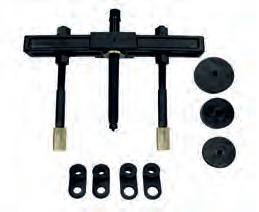
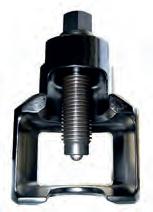




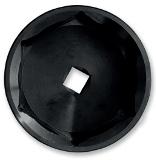
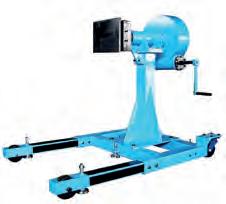

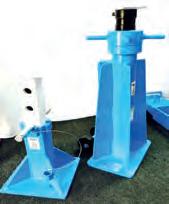

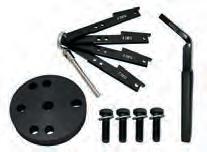



Valentine’s Day is coming up, meaning it’s time for truckies to feel the love
You know how much we love a joke for No Bull. Valentine’s Day may not originally sound like the greatest occasion to be attempting a gag, but we have a few tailored for the special day that may just make your other half laugh and feel the love.
Where do you find love in a supermarket? Aisle B…there for you.
How do vampires know if they’ve had a successful Valentine’s Day? If it’s love at first bite. Why shouldn’t you fall in love with a pastry chef? He’ll dessert you.
What’s Cupid’s favourite band? KISS.
How do you keep a jewellery shop safe on Valentine’s Day? You locket.

If you’re a Brisbane local, or even if you’ve driven through there recently, have you noticed anything funny about the water? Many are reporting a different weird taste to the city’s tap water, but it’s been quick to confirm there’s nothing harmful to the taste. The reason behind it is a harmless organic
compound that often appears after heavy rain and hot weather that is infiltrating the water, so keep on drinking.
In Melbourne, a new trial this summer is allowing those enjoying their nights out to not have to worry
about getting home safe, especially if they have a car to drive back.
Rideshare app DiDi has recently started a dedicated tow truck booking system for Melburnians to get themselves and their vehicles home. For the same price as a normal rideshare service, the truck will come and pick both the car and the person up and take them home.



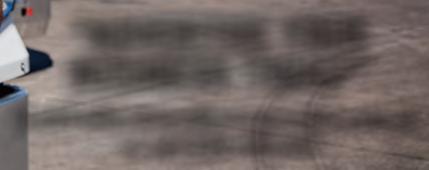

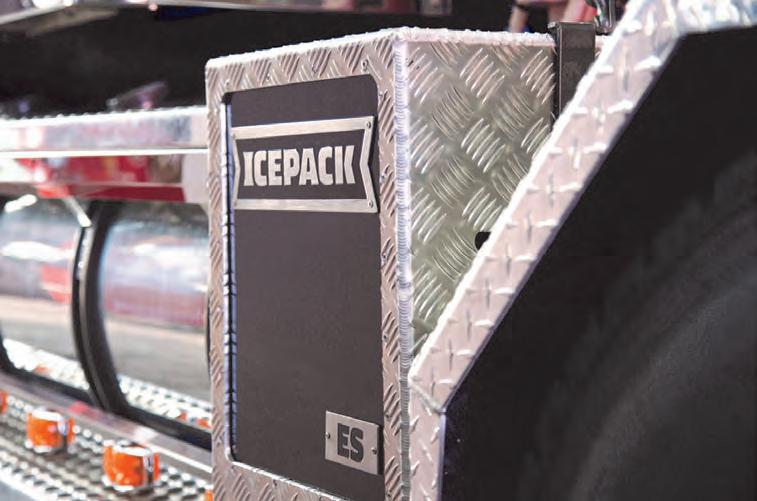











With the Christmas break over, most of us in transport are back to the grind. This is a good time in the year to reflect about the important role that we play in the wider Australian economy. The road transport industry is a pivotal component of Australia’s economy, facilitating the movement of goods across vast distances, connecting urban centers with remote regions and enabling trade both domestically and internationally. This important service to the nation’s economy needs to be properly funded to remain viable.
As we grapple with the pressing challenges of rising costs of running and maintaining our vehicles, living on the road and rising fuel costs, it’s critical that we ensure we don’t let standards slip when it comes to our rates of pay. This isn’t just a case of making ends meet, but staying safe on the road. It’s important for us to make
within the context of road transport and in particular the owner-driver business model. Sustainable rates refers to pricing strategies that incorporate not only the direct costs of transporting goods from one location to another, but the associated expenses of running a transport operation. This includes getting paid well enough to cover rising fuel costs, as well as ongoing maintenance costs that ensure our trucks are roadworthy and safe, for instance ensuring we can put aside funds to replace worn-out or faulty equipment. As owner-drivers, it’s up to us to manage our on-road expenses, so it’s essential that we’re always putting aside money for a rainy day. Sustainable rates also applies to our living expenses, ensuring we are earning enough to provide for our families, especially given rising inflation and the much-publicised challenge to keep on top of the rising cost of living.
“As we grapple with the pressing challenges of rising costs of running and maintaining our vehicles, living on the road and rising fuel costs, it’s critical that we ensure we don’t let standards slip when it comes to our rates of pay. This isn’t just a case of making ends meet, but staying safe on the road.”
it clear to clients up the chain that enough money needs to be flowing through the supply chain for us to cover our costs and operate safely.
Sustainable rates is undoubtedly the biggest area for improvement for us, as we settle back into our role of keeping Australia moving. The sustainability of our rates is significant because as owner-drivers we need adequate remuneration for our businesses to operate viably and to stay safe on the roads, as well as ensuring that members of the community that share the road with us are also safe. At the outset, it is essential to define what constitutes sustainable rates
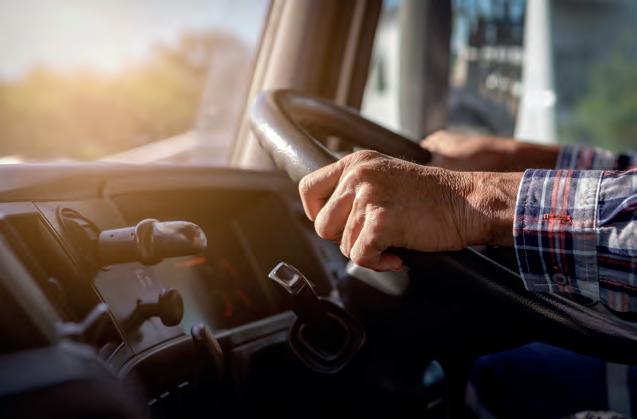
Over the years there have been a few calculators designed specifically for road transport, some good and some not so good. In my view, a simple way to keep track of our costs is to just use an Excel spreadsheet to determine and calculate our rates, minus any overheads, including potential future costs so we’re able to stay viable. When calculating the costs of operating, we need to include all variable and fixed costs and ensure all figures are realistic and accurate. For instance, if you need to put money aside for when the time comes to replace your truck, there’s no point in over or underestimating the amount, or inputting an amount that doesn’t reflect the value of your truck, as it will blow out your figures one way or another.
Often we see rates being increased and decreased as fuel fluctuates. Fuel is a major expense and is often the first thing to come to mind, but it is not the only overhead to take into account. What is always overlooked is the fact that other costs such as tyres, spare parts, repairs, cleaning products and even the cost of living on the road have risen but are seldom discussed. Well-maintained vehicles are safe vehicles and when it comes to trucks, safe trucks protect not only the driver, but other road users, given the size and power of our vehicles.
Given the need to maintain our vehicles, cover the cost of rising overheads and, importantly, to ensure ourselves and our fellow road users remain safe on the roads, we need to ensure enough money is flowing through from the top of the supply chain. After all, if our industry collapses or is unviable then everyone loses out, not just us. Lastly, we also need to keep in mind our profit margin. We are not a free community service and we’re as entitled as any other business to ensure we’re able to profit from the service we provide. Every successful business needs to have a reasonable profit margin and we’re no different. I have even been told that when an owner-driver pays off their equipment, the asset, being the equipment, would be their profit. I have never heard of any other business that would work that way and, in any case, once equipment has reached the end of its useable life, it is either worth nothing or it is traded and rolled over for newer equipment within the business.
Sustainable rates in our industry are essential for ensuring safe and reliable equipment and services, fair compensation, financial stability and eventually being able to upgrade to environmentally friendly equipment. By adopting a holistic view of the costs associated with transport, we as industry stakeholders can better appreciate the long-term viability of our operations and also the implications for society at large. In essence, we can’t run a safe, profitable and essentially viable owner-driver operation without proper remuneration that covers all rising expenses.






